Archived Blog Posts
Tips to Prevent Mold Growth in Your West Valley City, UT Home
3/11/2024 (Permalink)
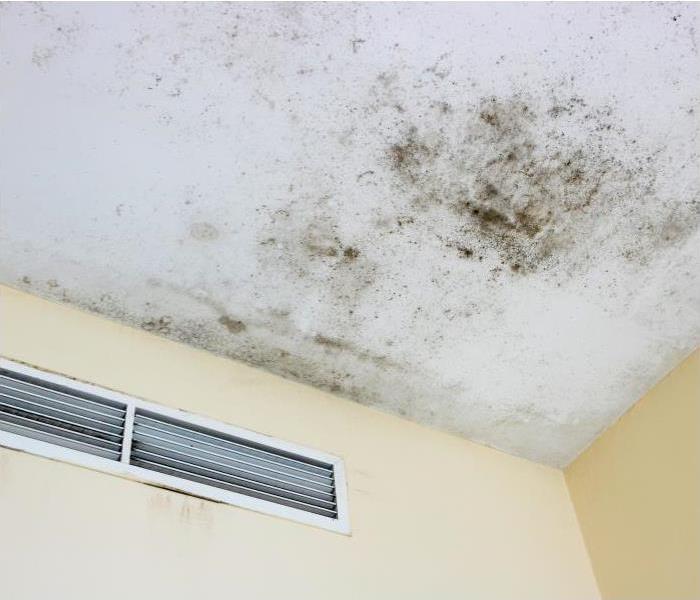 Prevent Mold Growth in West Valley City, UT.
Prevent Mold Growth in West Valley City, UT.
Nestled between the stunning Oquirrh and Stansbury mountain ranges, West Valley City, UT, offers residents a picturesque backdrop for their homes. However, the region's unique climate and occasional humidity can create an environment conducive to mold growth. Mold not only poses health risks but can also damage your home's structure and decrease its resale value. In this blog, we'll explore effective tips to prevent mold growth in your West Valley City home, ensuring a healthy living environment for you and your family.
10 Tips to Prevent Mold Growth
1. Control Indoor Humidity:
Utah's climate is characterized by dry air, but occasional spikes in humidity can occur. To prevent mold growth, it's crucial to control indoor humidity levels. Invest in a dehumidifier to maintain the relative humidity below 60%. Focus on areas prone to dampness, such as basements, bathrooms, and kitchens. Regularly empty and clean the dehumidifier to ensure optimal performance.
2. Improve Ventilation:
Proper ventilation is key to preventing mold in your home. Ensure that bathrooms and kitchens are equipped with exhaust fans that vent outside rather than into the attic. Use these fans during and after activities that generate moisture, such as cooking or showering. Additionally, consider installing an attic vent to promote air circulation and prevent the buildup of humid air.
3. Address Water Leaks Promptly:
Leaks can be a major source of moisture that fosters mold growth. Regularly inspect your home for leaks, paying attention to areas around windows, doors, and the roof. Address any leaks promptly, as even minor drips can lead to significant moisture accumulation over time. Repairing leaks not only prevents mold but also protects your home's structural integrity.
4. Clean and Dry Wet Areas Immediately:
Utah's climate can be unpredictable, and occasional rain or snowfall may occur. If water enters your home, whether through leaks or environmental factors, it's crucial to clean and dry wet areas promptly. Use towels, fans, or dehumidifiers to expedite the drying process and prevent mold from taking hold.
5. Ensure Proper Insulation:
Proper insulation plays a crucial role in preventing mold growth by minimizing condensation. Check your home's insulation, especially in areas like attics and basements. Ensure that insulation is installed correctly and in good condition. If necessary, consider upgrading insulation to prevent moisture buildup and create a mold-resistant environment.
6. Regularly Clean and Maintain Gutters:
Gutters play a vital role in directing water away from your home. Clogged gutters can lead to water overflow and potential water damage, creating conditions favorable for mold. Schedule regular gutter cleanings, especially during the fall when leaves and debris can accumulate. Ensure that downspouts are directed away from the foundation to prevent water from pooling around your home.
7. Use Mold-Resistant Products:
When renovating or upgrading your home, consider using mold-resistant materials. Mold-resistant drywall and paint can be effective in preventing mold growth in areas prone to dampness. These products have anti-microbial properties that inhibit mold development, providing an additional layer of protection for your home.
8. Keep Indoor Plants in Check:
While indoor plants can enhance the aesthetic appeal of your home, they can also contribute to mold growth. Soil in potted plants provides a breeding ground for mold spores, especially if overwatered. Be mindful of your watering practices and avoid overwatering. Place a layer of gravel or sand on top of the soil to discourage mold growth.
9. Regularly Clean and Ventilate Appliances:
Household appliances like washing machines, dryers, and refrigerators can be sources of moisture. Regularly clean and maintain these appliances to prevent mold growth. Ensure proper ventilation for appliances that generate moisture, such as clothes dryers, by venting them outside rather than into the home.
10. Schedule Professional Inspections:
Regular professional inspections can identify potential issues before they escalate. Consider scheduling an annual inspection with a qualified home inspector to assess your home's overall condition. Professionals can identify hidden leaks, ventilation issues, or areas of concern that may contribute to mold growth. Addressing these issues proactively can save you time and money in the long run.
Preventing mold growth in your West Valley City, UT home requires a combination of proactive measures and regular maintenance. By controlling indoor humidity, addressing leaks promptly, and implementing mold-resistant practices, you can create a healthy living environment for you and your family. Regular inspections and a vigilant approach to moisture management will help safeguard your home from the detrimental effects of mold, ensuring that it remains a safe and comfortable haven amidst the stunning landscapes of West Valley City.
SERVPRO of West Valley City's Expertise in Resolving Water Damage from Leaking Toilets
1/15/2024 (Permalink)
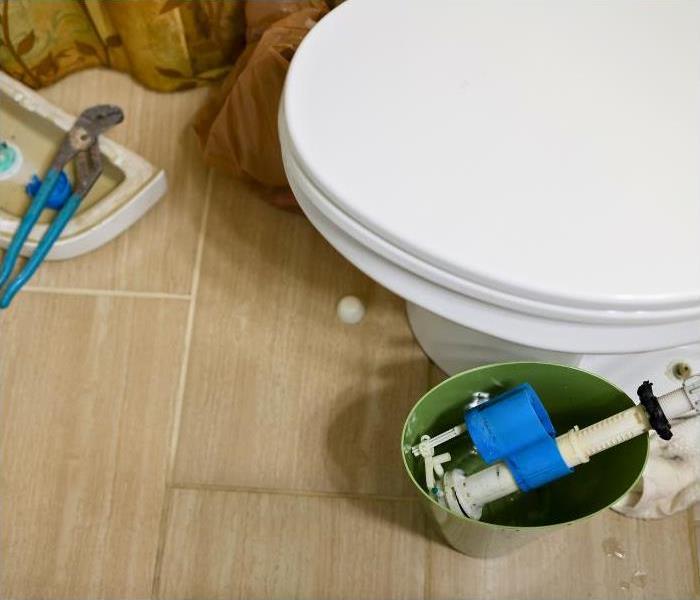 Leaking toilet in West Valley City, UT.
Leaking toilet in West Valley City, UT.
Water damage in residential homes can be a nightmare for homeowners, wreaking havoc on property and belongings. One of the most common culprits is a leaking toilet, a seemingly minor issue that can lead to significant problems if not addressed promptly. In this blog post, we will explore the impact of water damage caused by a leaking toilet and shed light on how SERVPRO of West Valley City acts swiftly to mitigate damage and restore homes to their preloss condition.
The Hidden Perils of a Leaking Toilet:
A leaking toilet may seem like a minor inconvenience at first, but its consequences can be far-reaching. The continuous drip of water can permeate flooring, walls, and even seep into structural components, causing hidden damage that may not be immediately apparent. Mold growth is another concern, as the moist environment created by water leaks provides an ideal breeding ground for these troublesome fungi.
Homeowners often underestimate the potential severity of water damage from a leaking toilet, assuming that a simple DIY fix will suffice. However, time is of the essence when dealing with water damage, and quick action is crucial to preventing further harm to the property.
The Importance of Swift Mitigation:
Water damage can escalate rapidly, leading to structural issues, electrical hazards, and compromised indoor air quality. Swift mitigation is essential to minimize the extent of the damage and reduce the likelihood of secondary issues such as mold growth.
SERVPRO of West Valley City understands the urgency of water damage situations and responds promptly to mitigate the damage. Their team of highly trained professionals is equipped with state-of-the-art tools and technology to assess the extent of the damage, extract water, and implement drying techniques efficiently.
Immediate Response and Assessment:
Upon receiving a call, SERVPRO of West Valley City dispatches a team to the affected property without delay. The first step is a thorough assessment to determine the scope of the water damage. Specialized moisture detection equipment is used to identify hidden pockets of water behind walls, under flooring, and within structural components.
Once the assessment is complete, the team develops a tailored mitigation plan, taking into account the specific characteristics of the water damage. This plan outlines the steps required to restore the property to its pre-damage condition and includes a timeline for each phase of the restoration process.
Water Extraction and Drying:
The next crucial step is the removal of standing water and moisture from the affected areas. SERVPRO of West Valley City employs powerful water extraction equipment to efficiently remove excess water, preventing further damage to the property.
State-of-the-art drying equipment, such as industrial-grade dehumidifiers and high-speed air movers, is strategically placed to expedite the drying process. This not only prevents the growth of mold but also helps salvage materials that may otherwise be irreversibly damaged.
Meticulous Restoration:
Once the affected areas are thoroughly dried, the restoration process begins. SERVPRO of West Valley City focuses on restoring rather than replacing, whenever possible, to minimize costs and reduce the disruption to homeowners. This may involve repairing or replacing damaged drywall, flooring, and other structural elements.
In cases where materials cannot be salvaged, the SERVPRO team ensures that replacements match the existing materials, maintaining the aesthetic integrity of the home. Throughout the restoration process, homeowners are kept informed of progress, ensuring transparency and peace of mind during a challenging time.
Preventing Future Water Damage:
In addition to mitigating current water damage, SERVPRO of West Valley City takes proactive measures to prevent future incidents. This may include identifying and addressing the root cause of the leaking toilet, recommending plumbing repairs, or providing advice on routine maintenance to homeowners.
Education is a key component of SERVPRO's approach, empowering homeowners to recognize and address potential water damage risks before they escalate. By taking a holistic approach to water damage restoration, SERVPRO of West Valley City not only resolves immediate issues but also helps safeguard homes against future incidents.
Dealing with water damage from a leaking toilet requires swift and expert intervention. SERVPRO of West Valley City stands out for its commitment to prompt response, meticulous assessment, and efficient restoration. By addressing water damage comprehensively and preventing future incidents, SERVPRO ensures that homeowners can return to a safe and fully restored living environment. When water damage strikes, count on the professionals at SERVPRO of West Valley City to turn a stressful situation into a successful restoration.
Steps to Preventing and Addressing Frozen Pipes
12/28/2023 (Permalink)
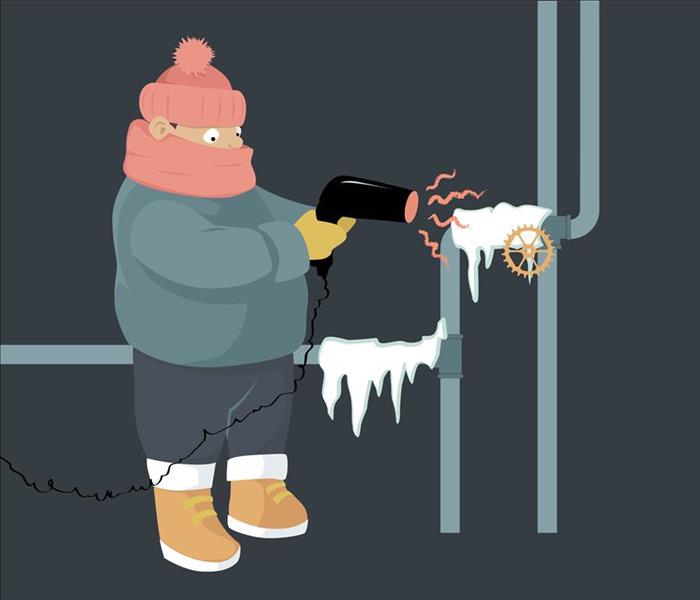 Frozen Pipes in West Valley City, UT.
Frozen Pipes in West Valley City, UT.
As winter blankets West Valley City, UT, with its icy embrace, homeowners must gear up for the challenges that come with the season. One of the most prevalent and potentially damaging issues during winter is frozen pipes. When temperatures plummet, the water inside pipes can freeze, causing them to expand and potentially burst and causing water damage. Dealing with frozen pipes requires a combination of preventative measures and swift action if damage occurs. In this comprehensive guide, we'll delve into the intricacies of frozen pipes, providing practical tips to prevent them and exploring how services like SERVPRO can be a lifeline in mitigating damage.
Understanding the Threat
Frozen pipes pose a significant threat to homes, potentially leading to costly water damage. In West Valley City, where winter temperatures can be unforgiving, taking proactive measures is essential. When water freezes within pipes, it expands, exerting pressure that can cause pipes to crack or burst. The damage often goes unnoticed until temperatures rise, and the ice within the pipes begins to thaw, resulting in leaks and flooding.
Preventative Measures
Insulate, Insulate, Insulate: The foundation of preventing frozen pipes lies in proper insulation. Identify vulnerable areas, such as attics, basements, and crawl spaces, and insulate pipes using sleeves or heat tape. This extra layer helps maintain a consistent temperature, reducing the risk of freezing.
Let the Faucet Drip: Allowing faucets to drip can be a simple yet effective strategy. By letting water flow, you relieve pressure in the pipes, minimizing the chances of freezing. Focus on faucets connected to pipes along exterior walls and those in unheated areas.
Maintain a Consistent Temperature: While it may be tempting to lower the thermostat to save on energy costs, doing so during winter can put your pipes at risk. Keep your home at a stable temperature, especially during the night or when you're away. This ensures that the plumbing stays warm and functional.
Open Cabinet Doors: For pipes located under sinks, opening cabinet doors allows warm air to circulate, providing additional protection against freezing. This is particularly crucial in areas where pipes are exposed to colder temperatures.
Seal Leaks and Gaps: Conduct a thorough inspection of your home for any gaps or cracks that could allow cold air to seep in. Seal these openings with caulk or insulation to prevent drafts, which can contribute to frozen pipes. Not only does this protect your plumbing, but it also enhances overall energy efficiency.
In Case of Emergency: SERVPRO to the Rescue
Despite taking all necessary precautions, frozen pipes can still catch homeowners off guard, leading to potential water damage. In such cases, swift and professional action is paramount. This is where SERVPRO, a trusted leader in the restoration industry, comes into play.
SERVPRO's Approach to Frozen Pipe Emergencies
Immediate Response: SERVPRO understands the urgency of water damage caused by frozen pipes. Their team of experienced technicians responds promptly to mitigate further damage. Time is of the essence, and SERVPRO's quick action can make a significant difference in minimizing the impact on your home.
Water Extraction: Upon arrival, SERVPRO assesses the extent of water damage and employs advanced equipment for efficient water extraction. Removing excess water is crucial to prevent secondary issues such as mold growth and structural damage.
Drying and Dehumidification: After water extraction, SERVPRO focuses on thorough drying and dehumidification. This step is essential in preventing lingering moisture that could lead to mold growth. State-of-the-art drying equipment is used to restore optimal humidity levels in the affected areas.
Restoration Services: SERVPRO's comprehensive restoration services cover everything from damaged drywall and flooring to compromised structural elements. Their goal is to return your home to its pre-damage condition, minimizing disruption and ensuring a seamless recovery process.
As winter's chill settles over West Valley City, UT, homeowners must arm themselves with knowledge and preparation to combat the threat of frozen pipes. By implementing preventative measures and knowing who to turn to in case of an emergency, you can navigate the winter season with confidence, ensuring the safety and integrity of your home. Stay warm, stay prepared, and trust the experts when the unexpected occurs. With SERVPRO by your side, you can weather the winter freeze knowing that a dedicated team is ready to restore your home to its former glory.
Protecting Your Home and Family: Minimizing Lint Fire Risks in West Valley City, UT
10/23/2023 (Permalink)
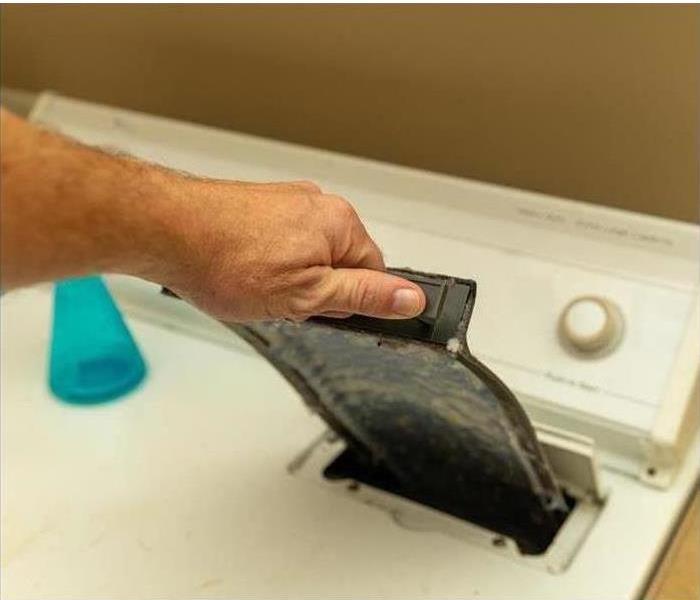 Regular dryer cleaning can help reduce the risk of a lint fire in your West Valley City, UT, home.
Regular dryer cleaning can help reduce the risk of a lint fire in your West Valley City, UT, home.
When it comes to the safety and security of your home, there are many potential risks that we all must be aware of, and one that is often overlooked is the danger of lint fires. In West Valley City, Utah, where extreme weather conditions can make our homes more susceptible to fires, it's crucial to take preventive measures. In this blog, we will discuss in more detail how to limit lint fire risks and how SERVPRO of West Valley City can assist you in restoring your home after suffering fire damage.
Lint Fire Risks in West Valley City
West Valley City, nestled in the heart of the beautiful state of Utah, boasts a diverse climate, ranging from freezing winters to scorching summers. Such temperature variations can lead to increased lint production in our homes. Lint, the tiny fibers shed by our clothing and linens, may seem harmless, but it can accumulate in the lint trap of our dryers and create a potentially explosive hazard.
Why Lint is a Fire Hazard:
Lint is highly flammable, and when it accumulates in the lint trap and dryer vents, it becomes a significant fire risk. As the dryer heats up, lint can ignite, leading to a dangerous and potentially devastating fire. To better understand this risk, let's delve into some key aspects of lint fire hazards:
Lint Accumulation: Lint collects not only in the dryer's lint trap but also within the dryer vent system. Over time, this accumulation becomes dense and highly flammable.
Heat Buildup: As the dryer operates, it generates heat. This heat, when combined with the presence of excess lint, can reach temperatures high enough to cause ignition.
Oxygen Supply: Dryer vents, designed to release hot, moist air from the dryer, often provide a steady flow of oxygen, which is essential for a fire to grow and spread.
Spread of Fire: Once a fire starts in the dryer, it can quickly spread to other parts of the home, especially if the dryer is located near combustible materials.
Now, let's explore practical steps to minimize these lint fire risks in your West Valley City home.
Minimizing Lint Fire Risks
Regular Dryer Vent Cleaning: The most effective way to mitigate lint fire risks is to clean your dryer vents regularly. Annual professional vent cleaning is highly recommended. This will ensure that all accumulated lint is removed, reducing the risk of a fire hazard.
Clean the Lint Trap: After each load of laundry, make it a habit to clean your dryer's lint trap. This simple step can significantly reduce the amount of lint in the vent and decrease fire risk.
Vent Inspection: Regularly inspect your dryer vent for any blockages, damage, or disconnections. If you notice any issues, address them promptly to prevent lint buildup and the risk of fire.
Keep Combustibles Away: Store combustible materials, such as cleaning supplies and paper products, away from your dryer. Make sure there's nothing flammable near the dryer to reduce the risk of fire spread.
SERVPRO of West Valley City: Your Fire Damage Restoration Partner
Despite taking preventive measures, accidents can still happen. If your home in West Valley City experiences a fire, SERVPRO of West Valley City is here to help. Our team of highly trained professionals specializes in fire damage restoration and is dedicated to helping you get your life back to normal as quickly as possible.
Emergency Response: In the aftermath of a fire, prompt action is essential. Our team is available 24/7 to respond to your emergency, ensuring that your property is quickly assessed and steps are taken to prevent further damage.
Assessment and Planning: We conduct a thorough assessment of the damage and create a personalized plan to restore your home. Our experts understand that each fire damage situation is unique and requires a tailored approach.
Cleanup and Restoration: We use state-of-the-art equipment and techniques to clean and restore your home. From soot and smoke removal to odor elimination, we ensure your property is safe, clean, and habitable again.
Support and Communication: Throughout the restoration process, we maintain open lines of communication with you. We understand that dealing with a fire is a traumatic experience, and we are here to provide support and updates every step of the way.
Preventing lint fires is crucial for the safety of your home and family in West Valley City, Utah. By following the simple steps mentioned above, you can significantly reduce the risk of a lint fire. However, if the unexpected happens and your home experiences fire damage, SERVPRO of West Valley City is your trusted partner for efficient and effective fire damage restoration. We are committed to helping you recover and rebuild your life after a fire, ensuring that your home is once again a safe and comfortable place for you and your family. Don't wait until disaster strikes; take action today to protect your home and loved ones from the risks of lint fires.
The Flood Water Cleanup Process
9/13/2023 (Permalink)
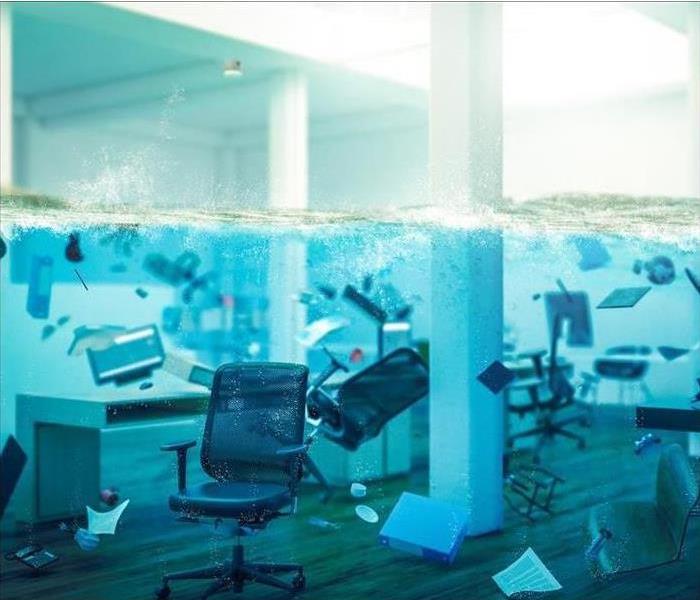 Flooding can cause severe damage.
Flooding can cause severe damage.
Excess water can cause a lot of damage to your commercial building in West Valley City, UT, and these issues can only be properly mitigated by certified water restoration experts. When the flood water in question is contaminated, this adds extra steps to the cleanup process. It's important to understand the measures necessary to ensure that your building is free of both moisture and bacteria.
Steps for Cleanup After Flooding or Toilet Overflow
A simple pipe break can be a big problem, but at least the water it releases is clean. By contrast, Category 3 water is contaminated. It can come from a variety of sources:
- Overflowing toilet
- Groundwater seepage
- Storm damage
- Municipal sewer backup
Any time your building is flooded with Category 3 water, mitigation automatically includes measures to ensure that no contamination gets left behind.
- Extract Excess Water
Removing water is a crucial step that prevents it from causing further damage. Technicians pump it out of the building. Then they use special equipment to get rid of whatever the pump couldn't extract. They must assess which items and parts of the structure are salvageable before they can continue with remediation.
- Remove Debris
Any debris that enters your building along with the flood water must also be removed. Additionally, all porous materials that are saturated with contaminated water need to be torn out. This inevitably includes carpet and insulation, but it may also mean that drywall, floor pads and ceiling tiles have to go. Technicians have to clear the area of all ruined items.
- Rinse Area
No matter how meticulous the mitigation team is, some debris will not be able to be removed manually. The only way to get it off the remaining surfaces in your building is to rinse it. The purpose of the initial rinse is to remove all remaining particles that don't belong in the space.
- Sanitize Surfaces
Once all the dirt and particles that you can see have been washed away, it's time to disinfect the remaining surfaces. Technicians use industrial-strength cleaners to ensure that all bacteria and microbes are killed in the cleaning process. For spaces that are hard to reach, they may need to use equipment that helps them get the detergent into nooks and crannies.
- Dry Thoroughly
There is often residual moisture left by the cleaning process. To prevent secondary damage such as mold, your building needs to be dry. Fans are useful not only for drying surfaces but also for bringing the humidity level back under control.
- Conduct Tests
The final step before the restoration phase begins is confirmation that the space has been sanitized. Technicians may perform a variety of tests, including surface swabs and air quality measures, to make sure that their efforts to disinfect the building were successful. If the results are not satisfactory, they know they have more cleaning to do before moving on to rebuilding.
Cleaning up after flood water is always a multi-step process. When the damage is caused by Category 3 water, however, even more tasks must be added to mitigate it completely.
5 Steps for Water Mitigation After a Building Pipe Burst
8/31/2023 (Permalink)
 Bursting pipes can lead to severe water damage.
Bursting pipes can lead to severe water damage.
When you notice that a pipe has broken or a supply line leaking at your West Valley City, UT, commercial building, it can bring on a sense of panic. Water could still be pouring in, but all you can think about is how to properly perform the pipe burst cleanup procedure.
These basic steps must be taken to keep damage to a minimum.
- Shut Off Electricity
First and foremost, in this situation, you must ensure that everyone remains safe. Turn off the electricity to the part of the building affected by the water, or to the entire building. If there are electronics, appliances, or outlets in the area, an electrical current could be in the water, so don't let anyone walk through it or touch anything until the electricity is shut off. If you can't navigate to the breaker box safely, call a professional electrician or the power company to shut it off before the water cleanup begins.
- Remove Soaked Materials
Next, you must get all of the water-soaked material out of the building. Wet items will only contribute to the excess humidity that needs to be eliminated. Soaked carpets and drywall will have to be removed and won't be salvageable. Some porous items such as wooden or upholstered furniture may be salvageable if they can be completely dried soon enough.
- Extract Standing Water
All standing water must be extracted as soon as possible. Every minute counts when it comes to water damage; standing water can wreak havoc indoors. A wet/dry is ideal for safely, quickly, and efficiently eliminating the water. It's a great tool to have on hand for water emergencies like a pipe burst cleanup. However, if you don't have one, many home improvement stores rent them. Mops and towels will also do the job.
- Dry Everything
Everything in the affected area must be thoroughly dried as swiftly as possible. Besides structural damage, excess moisture can contribute to mold growth. Mold can begin growing within 24 hours of water exposure, and it can get out of control fast. Not only can standing water cause damage but humidity can also. If the humidity outside is lower than the indoor level, open windows and doors to let the fresh air blow through. You can also use fans, heaters, and dehumidifiers. Dehumidifiers can also be rented at home improvement and hardware stores. You must pay close attention to the unit to empty the collected water when necessary. If you feel you cannot dry the area properly, water damage restoration professionals have the expertise and industrial-grade equipment for these situations.
- Inspect for Damage
Finally, once the job is complete, it's essential to inspect for damage to be repaired as soon as possible. Ideally, you can have professionals inspect the area because they know where to find damage and how to best resolve the problem. They'll check for structural water damage and mold growth and determine any repairs or cleanup procedures that must be performed.
In a water disaster, such as a supply line leaking, it's advantageous to know what to do before the situation arises. A pipe burst cleanup will never be pleasant, but it can go more smoothly having a plan in place.
3 Things Not To Do After a Flood
8/31/2023 (Permalink)
 Heavy rains may lead to flood damage.
Heavy rains may lead to flood damage.
It’s one of many homeowner’s worst nightmares: a large storm or local disaster has flooded your neighborhood in West Valley City, UT. Many who experience flooding for the first time are unprepared and uninformed, not knowing what to do after flood water has covered the streets or entered their home. To help you prepare, whether you’re facing a flooded home now or foresee its possibility in the future, here are three things not to do after a flood:
3 Things to Avoid After a Flood
1.Remain in your home. For you and your family’s safety, if water has entered your home, it’s important to leave and not reenter until flooding has subsided. In a flood’s immediate aftermath, the risk of rising water is still imminent due to the possibility of more rain, a compromised levy or busted dam. Find refuge outside the flood area, whether it be in a hotel, a loved one's home or a public shelter.
2. Touch the water. Flood water can be contaminated with any number of bacteria, sewage and/or chemicals that can be harmful to your skin and health. It’s also imperative to avoid standing water to minimize the risk of electric shock from electrical lines and equipment touching the water. If you must enter or be around the water for any reason, protective clothing such as rubber boots should be worn.
3. Fix it yourself. Repairing flood damage in a home can require a large amount of construction materials, professional knowledge and skill to ensure the damage is fully repaired and any mold is removed. Instead of trying to take on the job yourself, it’s best to save time and additional headaches by contacting a water damage repair and restoration company.
For any homeowner, flood water is certainly an unwelcome sight. Knowing what to do, or not do, in this type of disaster is imperative to keep you and your family safe and to begin the restoration process successfully.
Steps of the Fire Restoration Process
8/18/2023 (Permalink)
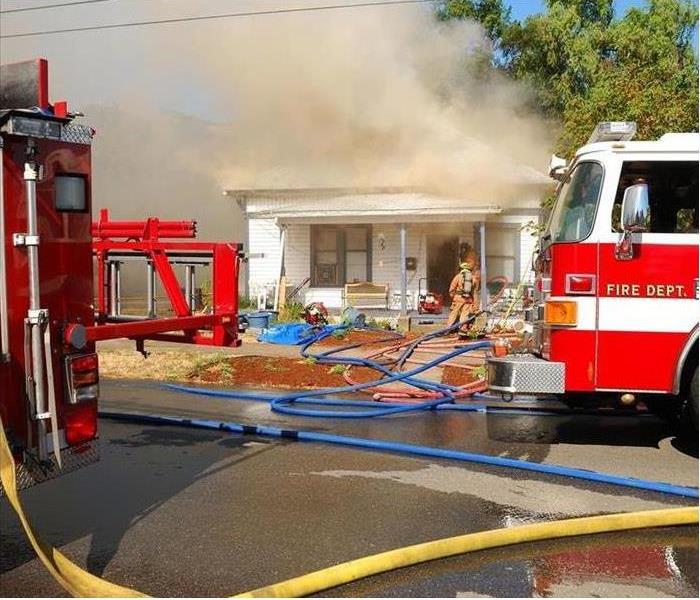 Fire damage in West Valley City, UT.
Fire damage in West Valley City, UT.
A fire in your home in West Valley City, UT, can cause a lot of damage in a short amount of time. After the flames are put out, fire restoration can begin. There are several steps to this process.
Important Tips to Start the Fire Restoration Process
- Initial Contact
Even if the fire doesn't reach all areas of your home, you still need to call fire damage mitigation specialists. They are certified to complete a thorough inspection and treat any problems they find:
- Smoke damage
- Weakened structure
- Soot residue
- Water issues
Other than your insurance provider, the cleanup team is the first call you need to make. Fast contact means that they are more likely to be able to repair the damage before any further problems occur.
- Damage Assessment
The first thing the technicians will do when they arrive is to survey the affected area. They look for weak spots and damaged materials. They then compile a list of tasks that need to be completed so that they can present you with an estimate that will be helpful in filing your insurance claim.
- Material Removal
Before any repairs can be done, the cleanup crew has to remove the parts that can't be salvaged. Drywall, insulation, flooring and ceiling materials may need to be torn out, even if they weren't directly touched by the flames. They may have water damage from the emergency efforts to subdue the fire, or the soot may be embedded deep within the porous materials.
- Surface Cleaning
The next step of the fire restoration process is cleaning all the remaining surfaces. Smoke and soot continue to erode materials the longer they are left on them, so prompt attention is the key to successful salvage. Technicians are likely to use a combination of chemicals and equipment to rid all cracks and crevices of unwanted substances and get rid of any lingering smoke smell.
- Area Drying
To prevent mold growth and other secondary damage, the mitigation team must remove all excess moisture from the affected area. The amount of water used to put out a fire makes this step one of the crucial tasks for ensuring that remediation is thorough.
- Item Repair
The structure isn't the only thing in your home that can be affected by a fire. Damage cleaning also includes determining which of your belongings must be thrown away and which ones can be restored. Before you toss items from the fire, give the mitigation team a chance to salvage them. You may be pleasantly surprised to find out how many things can be repaired.
- Fire Restoration
Finally, after everything is clean and dry, the team can rebuild the damaged parts of your home to make it livable again. They install new walls and flooring and make sure that the paint, tile and wallpaper match the remaining structures. The job isn't done until the affected area looks like there was never a fire in the first place.
No one likes the idea of a fire breaking out at home, but there's often a lot that can be done to save what's left. Once you call the fire restoration experts, they can get to work on your damaged home.
6 Tips for Preventing Mold Growth After a Flood
8/4/2023 (Permalink)
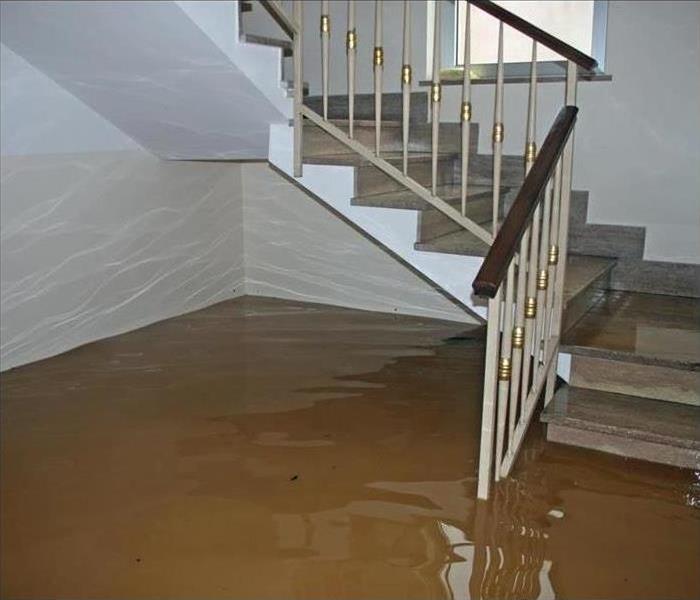 Flooding can cause severe mold damage if not cleaned properly.
Flooding can cause severe mold damage if not cleaned properly.
Floods can cause a significant amount of property damage; however, the initial damage from the water isn't the only problem homeowners face. The moist conditions created by flooding in a home often lead to mold growth. These tips can help you avoid this problem.
6 Ways To Avoid Mold Due To Standing Water
Mold needs several basic things to flourish. Mold requires moisture, food, warmth, and oxygen to grow. It is difficult to eliminate food sources or manipulate the temperature in a home to affect mold. The primary way to prevent mold problems is to reduce moisture.
- Dry Your Property Out Quickly
As soon as it is safe, you should begin drying out your property. Mold can begin growing in 24 to 48 hours from the initial water exposure. This makes it important to remove any standing water and dry out wet materials and contents as soon as you can. You may be able to remove small amounts of water with a wet/dry vacuum. You will probably need professional equipment to remove larger amounts of water. In some cases, it may be wise to contact a water remediation company in West Valley City, UT, to speed up the process of drying out the home.
- Increase Ventilation
If the weather permits it, open windows and doors during the day to increase airflow. Use fans to circulate the air and increase water evaporation. Position the fans to blow air out of doors and windows. Reduce indoor humidity by using dehumidifiers. A dehumidifier designed for home use may work for smaller spaces, but for larger spaces, you may need to rent an industrial model.
- Remove Wet Items
Remove wet debris and contents. Carpets, carpet pads, drywall, ceiling tiles, and other porous materials may need to be discarded because these items are difficult to clean. Salvageable contents may be left outside in the sun to dry or taken off-site by a restoration company for cleaning. Clean surfaces that were exposed to floodwater with a disinfectant or sanitizer to kill mold spores and bacteria. If you can't immediately remove wet carpet, extract the water from it with a commercial carpet extractor or wet/dry vacuum.
- Shut Off Water Sources
If anything in your home is leaking water, shut off the water to your home. As long as there is a source of moisture, mold growth is likely to be a problem. Do not turn the water back on until broken pipes or leaking appliances are repaired.
- Turn Off HVAC Systems
Try to keep your home at a moderate temperature, but avoid over-cooling or overheating. A home that is too hot or too cold can cause the drying process to take longer.
- Watch for Warning Signs
If you are noticing stains on ceilings or walls or noticing musty smells, then you may have a mold issue. Take steps to remove the mold before the problem can get worse.
No homeowner wants to go through the process of restoring a flood-damaged home only to have to deal with a mold growth problem. Fortunately, there are steps you can take to reduce your chances of having to deal with this problem.
3 Fire Prevention Tips for Your Business
9/13/2022 (Permalink)
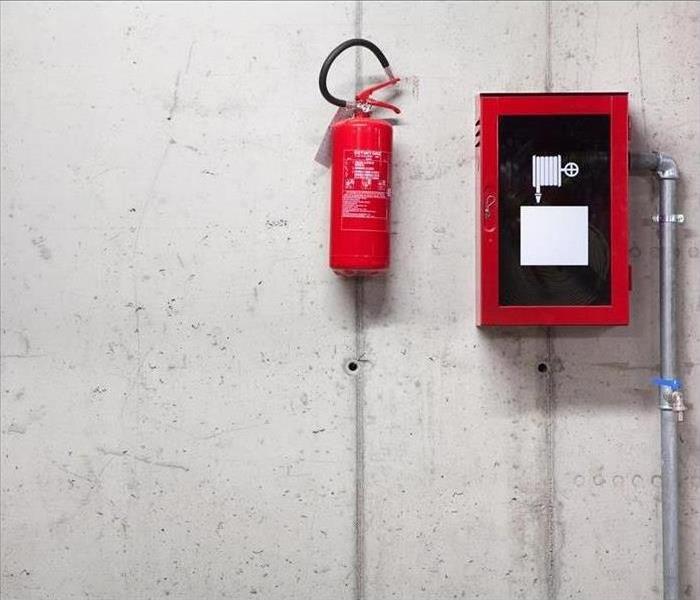 Keep your commercial property safe by having a fire extinguisher.
Keep your commercial property safe by having a fire extinguisher.
Knowledge is power when it comes to fire prevention. While it’s impossible to completely eradicate the potential for a business fire, there are several steps you can take to keep your commercial property in West Valley City, UT, safe.
Three Steps You Can Take To Keep Your Commercial Property Safe
- Schedule a Building Assessment
Fire assessments aren’t reserved solely for your local fire damage restoration company, and they don’t always have to take place after a fire. Contact the fire marshal and inquire about a fire hazard assessment for your building. Identifying and resolving risks up front is your first line of defense.
- Equip Your Building With Fire Suppression and Prevention Tools
It’s standard procedure to have fire extinguishers and smoke detectors on every floor of your commercial property. Test smoke detectors monthly to ensure that they’re working properly and be sure to change their batteries promptly when needed.
Depending on the size of your business, you may also want to invest in a sprinkler system as part of your fire prevention plan.
- Draft and Distribute a Fire Safety Plan
Your employees need to know what to do if there’s a fire during business hours. Those fire extinguishers mentioned above? Your staff needs to know how to operate them. They should also be aware of multiple evacuation routes in the event of a business fire. Run regularly scheduled practice evacuations and post the routes at various intervals through the building.
For larger companies, instituting a chain of command for fires and other emergencies is an easy way to streamline the process. By appointing fire safety officers and assigning responsibilities, you can lessen confusion in the unlikely event of a fire. All of your employees should know where to locate a first-aid kit as well.
Carve a few hours out of next week’s schedule to make sure your fire prevention procedures are up to snuff. It only takes a few hours of planning to significantly decrease the odds of a dangerous fire erupting at your commercial property.
6 Helpful Hints About Filing a Water Damage Insurance Claim
9/13/2022 (Permalink)
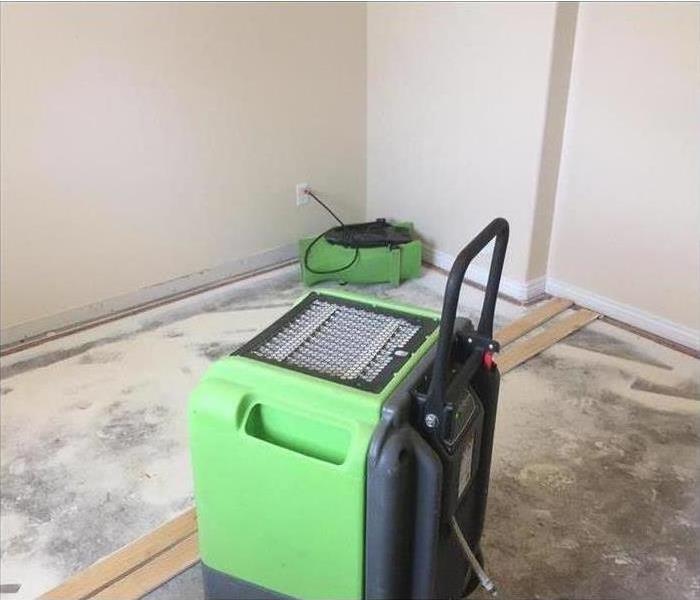 Water damage in a residential home in West Valley City, UT.
Water damage in a residential home in West Valley City, UT.
Insurance claims for water damage are on the rise. In fact, water damage claims are purportedly the second most reported petitions in West Valley City, UT. However, questions often arise when homeowners try to decipher the legal jargon of insurance policy, and many frequently become frustrated over exemptions and exclusions. Here are six hints to help you decode the steps you to take when making a water damage insurance claim.
6 Steps to Make a Water Damage Claim.
- Take pictures of the damaged area immediately after finding the water. Also, continue taking pictures during all stages of cleanup and restoration. If the damage is due to a pipe burst, take pictures of the pipe as well. Offer a copy of all photos to the insurance adjuster.
- Contact your insurance agent regarding the loss. Ask the agent questions about your coverage, the time limit to file a claim, and deductibles. Request information on repairs, restoration, and how long a claim takes to process.
- Establish your claim by filling out the claim forms as soon as you receive the papers. Return the completed documents to the insurance company right after you finish the paperwork.
- Keep a list of damaged and lost items. Include all steps taken to clean or discard major items, if possible. Also, take pictures and keep the photos with the records to substantiate the loss. If receipts are available for destroyed or damaged items, provide copies with your insurance claim.
- Request receipts and a detailed list of all work done by your water repair and restoration company. Also, ask the team to include a list of all supplies used to clean and sanitize the area.
- If your family needs to relocate during cleanup and restoration, keep receipts. Extensive records required may include living expenses, replacement clothing, and meal expenditures.
Once your insurance claim has been settled, and the insurance company accepts your submission, payment is typically sent to cover the terms of the settlement. If the claim is refused, you have the right to contest the refusal and the right to hire an attorney.
5 Signs You Have a Hidden Shower Leak
8/11/2022 (Permalink)
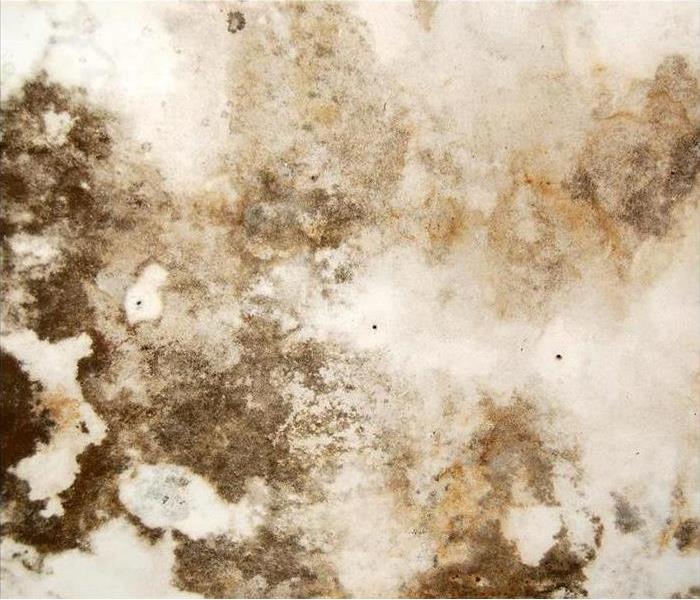 Presence of mold can be a sign of a shower leak in West Valley City, UT.
Presence of mold can be a sign of a shower leak in West Valley City, UT.
Residential plumbing is essential for the functionality of a house, but it is not uncommon for these systems to require maintenance. Unfortunately, it is not always apparent when corrective action needs to happen, like with a shower or bathtub leak. A water mitigation expert in West Valley City, UT, can provide some pointers on preventative steps to take, but you can never really know when a sudden leak will occur. To ensure that you find hidden leaks before they cause too much damage, consider the following five signs of a shower leak.
5 Signs Of A Shower Leak
- Presence of Mold or Mildew
Mold and mildew are indeed common in moisture-rich environments. However, if you are consistently finding mold or mildew around the shower faucet or head, then you may have a leak. To inspect, you will need to shut off the water supply and assess the faucets.
- Peeling or Flaking Paint
Another common sign of water damage from a bathtub leak is peeling or flaking paint. The peeling can suggest a leak behind the wall. The drywall is becoming damp, which is causing the adhesive of the paint to fail.
- Water Stains
If you have a shower on the second level of your home, then look for water stains on the ceiling of the lower level. The stains may appear grey or brown, depending on the damage.
- Sounds
When you turn your shower off, do you hear dripping? Continued water noises after the shower is turned off could indicate a leak in the line behind the wall.
- Loose Tiles
It is not uncommon for a shower pan leak to cause loose tiles around the tub. Water seeps around the drain, causing the subfloor to dampen and swell, which results in the tile breaking away from the floor.
A bathtub leak or shower leak is relatively common, but you do not want to let it fester. If you believe you have a leak, then contact a plumbing or water mitigation expert for help.
The Proper Use of a Fire Extinguisher and Other Critical Tools
7/25/2022 (Permalink)
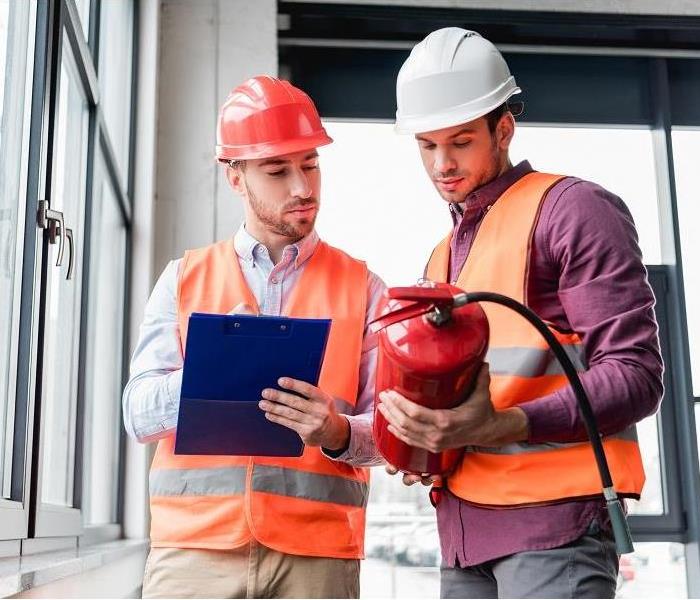 A fire extinguisher is a critical tool.
A fire extinguisher is a critical tool.
If your company in West Valley City, UT, is serious about fire protection, it needs to have the most important fire tools on the premises. It is just as important that these critical items are maintained and that key personnel know exactly how to use them to the best effect. These items include but are not limited to the fire alarm system, the fire extinguisher and the sprinkler system. A fourth category, the services of fire professionals such as a fire restoration team, will also be addressed here.
The Fire Extinguisher and Other Fire Protection Tools
The Fire Alarm System
The type of alarm you need depends upon your facility and how large it is. Professional installation is important as the contractor will understand the requirements for building codes and local fire regulations. The system should be professionally maintained to the highest standards.
The alarm should be set up so that it covers all relevant areas of your building as this will provide the greatest protection against fire damage. Finally, the alarms should have both auditory and visual alerts so that it reaches all individuals in the building should a fire break out.
The Fire Extinguisher
This essential tool can stop an incipient fire before it gets out of control and causes thousands of dollars in damages. Your company should have enough units on hand so that one is close by should a fire begin. The whereabouts of each unit should be identified with bright markings, and all units need to be inspected regularly. Your company should have the right extinguisher on hand for the type of fire that is possible in your facility, whether it be a kitchen fire, an electrical fire or a wood fire.
Fire extinguishers are not overly difficult to operate, but key personnel should undergo training on how to use them. The steps for operating a unit can be summed up by the acronym PASS:
- Pull out the pin to engage the unit
- Aim the nozzle at the base of the fire
- Squeeze the handle to discharge the contents
- Sweep the nozzle back and forth until the fire is out
The Sprinkler System
A modern fire sprinkler system has many advantages for the ultimate in fire protection. It works automatically, even when your building isn't occupied. It responds quickly to a small fire and targets the area so that any water damage is limited. It does require professional installation and should be maintained by a licensed contractor.
The Fire Recovery Process
Fire cleanup and restoration is a highly technical process that requires the work of a professional team of technicians. They use advanced techniques and sophisticated equipment to remove smoke, soot and fire damage. The process typically involves the removal of smoke odors and deep cleaning of soot from walls, furniture and fabrics. With a commercial fire, professionals work quickly to get your business going again as soon as possible.
A fire extinguisher is one critical tool to fight a commercial fire. The right tools and resources can prevent a small fire from becoming a big one and limit damages
4 Things a First Responder Should Know When Working With a Flood
7/19/2022 (Permalink)
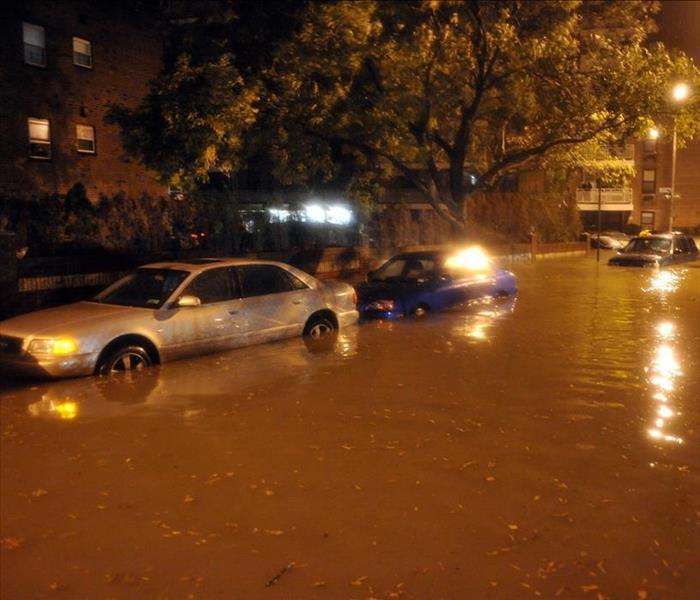 Severe flooding can cause serious damage.
Severe flooding can cause serious damage.
When your home in West Valley City, UT, gets hit with a flood, you need to take action quickly. However, even a first responder cannot run directly into an impacted space. Water and moisture can create an unsafe zone. Appropriate precautions should be taken by anyone entering the premises.
Top Tips for How a First Responder Should Approach a Flood Zone
Floodwater, also known as blackwater, plays host to high levels of pathogens and spores. The onslaught of water takes over an area, drenching it. External bodies of water overflow, or the sewage line backs up. Either way, homes become inhabitants of many organisms and potential hazards. Responders should remain vigilant and aware of the contamination, and understand the toll water takes on buildings. Be sure to follow these four essential tips.
1. Be Sure Your Immunization Records Are Current
The Centers for Disease Control recommends that anyone working with flood response be current in several immunizations. After all, a flooded environment proves challenging, uncertain and cumbersome. Severe flooding weakens structures and displaces items, creating physical obstacles. In addition, dampness encourages rust on metal objects.
These conditions establish a problematic setting where cuts and wounds could quickly and easily occur. Exposure to rusted materials and bacteria complicates injuries further. Therefore, responders should have tetanus and diphtheria shot, called the Tdap for short. In addition, the CDC suggests responders have the Hepatitis B vaccine as well.
2. Use Safety Gear
Minimize injuries and exposure by wearing appropriate safety gear and guarding yourself. Use durable rubber gloves and avoid touching your face and eyes with gloved or bare hands. At the end of the shift, discard gloves appropriately, using a new pair the time you enter. Thoroughly wash your hands with soap and warm water before moving to other activities.
In addition, the skin remains vulnerable, so cover up as much as possible. Have full-body clothes for the worksite, and keep goggles with you at all times. Don't forget a sturdy pair of boots. When you leave, change immediately. Take clothes off before you enter your home, and wash them.
3. Survey Your Surroundings
The United States Occupational Safety and Health Administration emphasizes that floods create multiple hazards for first responders. While water damage proves the most obvious concern, people must also remain aware of other conditions. Responders should consistently keep on their toes, understanding they could encounter the following situations:
- Carbon monoxide buildup
- Extreme heat
- Chemical and biological exposure
- Animal encounters
- Electrical issues
4. Recognize Mold Growth
Note that mold is likely to grow quickly in damp areas, demanding swift cleanup and precautions. Mold spores activate when water and organic matter meet, reproducing within one to two days. Floods establish the perfect conditions.
Use an N-95 mask, and wash everything thoroughly. Furthermore, discard porous, saturated items. Collaborate with an emergency water remediation team to assess the status and use high-quality gear and sanitizing methods.
As a first responder in West Valley City, UT, you face an incredible challenge to help homes and people. Remain cautious, constantly surveying your surroundings and adopting protective measures, to keep yourself and others safe during a flood disaster.
5 Tips for Home Fire Prevention and Preparation
7/12/2022 (Permalink)
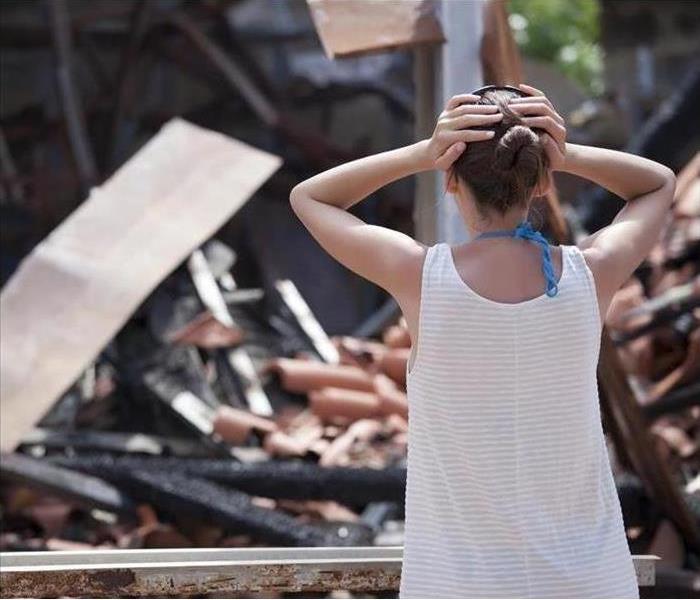 Fire damage in West Valley City, UT. Fire preparation and prevention it's important.
Fire damage in West Valley City, UT. Fire preparation and prevention it's important.
Witnessing your West Valley City, UT, home ablaze is one one the most devastating things you and your family could endure. Nothing is guaranteed. However, there are fire safety measures that can help you prevent a home fire. There are also fire preparation tips you can practice just in case.
5 Fire Preparation Tips
- Inspect Smoke Alarms
Smoke alarms must be maintained to keep them operating properly. Dust or vacuum each unit at least once a year when you replace the batteries. Smoke alarm units themselves should be replaced every 10 years.
- Use Electricity Safely
Avoid overloading electrical circuits. Make sure that your light bulbs don't go above the suggested wattage on each light fixture. If plugs don’t fit the outlets snugly, you may need to replace the outlets. If you frequently have tripped circuit breakers or blown fuses in your home, have a licensed electrician examine your electrical system.
- Cook Safely
Stay in the kitchen while cooking on the stove or broiling. Keeping a pot lid or baking sheet within reach in the kitchen is an excellent fire preparation plan. If a pan fire begins, cover it and turn off the burner. Always keep pot handles turned toward the back of the stove to avoid them being knocked off.
- Monitor Open Flames
When burning candles, make sure that they’re in sturdy, non-flammable candle holders away from flammable materials (e.g., curtains, magazines). Also, place them out of the reach of children and pets. Never keep candles burning unattended. Never present an open flame in an area where medical oxygen is used, even if the machine is turned off.
- Use Heaters Safely
Keep flammable materials at least three feet from space heaters, fireplaces, woodstoves, radiators and furnaces. Turn off and unplug heaters when you’re leaving home or going to bed. Only use space heaters with overheat or tip over automatic shutoff features.
Fire preparation and prevention are essential fire safety tools that you must practice. If a fire occurs at your home, fire restoration professionals can return it to its pre loss condition.
Storm Damage Prevention Tips
7/12/2022 (Permalink)
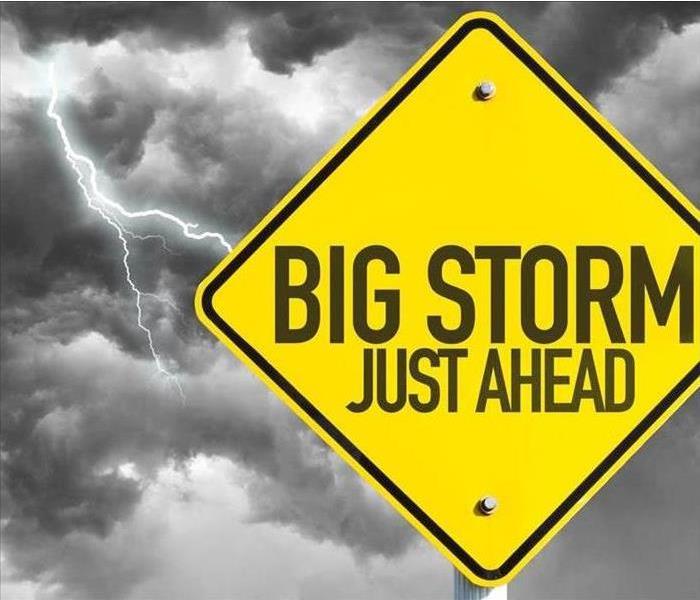 You can prevent a lot of damage to your property with regular inspections.
You can prevent a lot of damage to your property with regular inspections.
Taking care of your commercial property starts with prevention. A severe winter storm in West Valley City, UT, can result in a lot of expensive damage to your commercial building. However, there are several things you can do to prevent or at least minimize the damage the storm causes.
3 Tips For Storm Damage Prevention
- Inspect Building
Regular building inspections are a great way to identify potential problems and take care of them before they get out of hand. At the start of winter, you need a professional inspection of the parts of your building that are particularly vulnerable to storm damage during colder seasons:
- Roof
- Windows
- Foundation
- Plumbing
Look for existing damage as well as ways to fortify the structure. You can prevent a pipe break by making sure your plumbing has adequate insulation. Don't wait until after the storm hits to find out if your building is in good shape.
- Control Water Flow
A winter storm often brings a lot of precipitation with it. If that water has no clear path away from your building to follow, it can pool and freeze on your roof or near the foundation. This can cause cracks that let water seep in as the ice melts, causing interior damage that you may not notice for months. Storm damage restoration specialists recommend regular cleaning of your gutters and downspouts as well as the use of sandbags or other barriers to protect the places that are most vulnerable to leaks.
- Plan Ahead
Some prevention measures require prior notice to use effectively. Have a plan for protecting your building, and make sure everyone knows the part they are expected to play. Pay close attention to the weather reports in your area so that you have plenty of time to get your building ready for an approaching storm.
A winter storm can be dangerous to your building, but there's no reason you can't be ready for it. With regular inspections and a solid emergency plan, you can prevent a lot of damage to your property.
3 Common Causes of Water Damage in Your Home
7/12/2022 (Permalink)
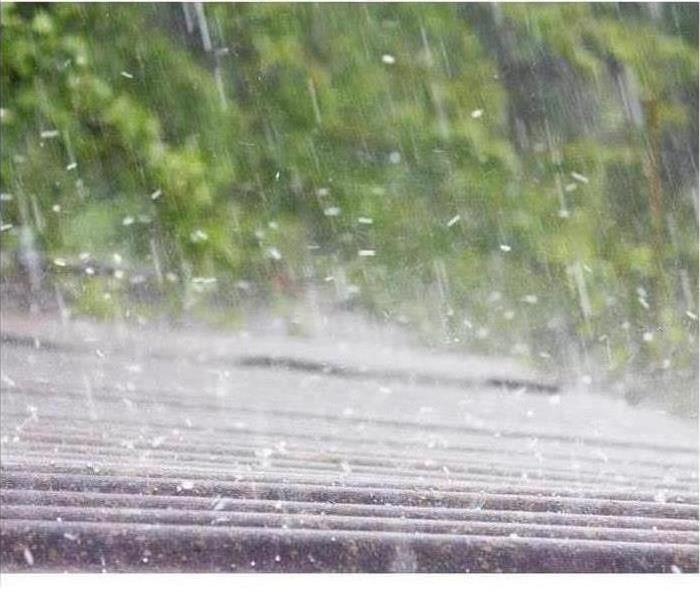 Hail damage can be a leading cause of water damage in West Valley City, UT.
Hail damage can be a leading cause of water damage in West Valley City, UT.
When Mother Nature has a bad day in West Valley City, Utah, sometimes you do too. Many different natural disasters can lead to flooding inside of your home. Unfortunately, even on a sunny day you can experience a pipe burst or water line break that causes the same result.
3 Leading Causes of Residential Water Damage
- Natural Disasters
Torrential downpours are not the only event in nature that can cause flooding in your house. Hurricanes, snowstorms, ice or hailstorms can be sources of water damage, and even fires can be a potential threat due to firefighting efforts. In any of these emergency situations, consider your safety first. After you and your family are out of danger, contact a storm damage and water restoration company that specializes in emergency services. From tarping a roof to prevent further damage to removing the excess flood waters, professionals can walk you through the steps needed to return your home to preloss condition.
- Broken Pipe or Line Break
When a pipe burst or water line break occurs, your house can become flooded with clean, uncontaminated water. In this situation, take action immediately to reduce the risk of secondary water damage. A water restoration specialist can inspect the damage and remove the standing water, and they can also dry, dehumidify and restore your home and its contents.
- Sewage Backup
A sewer backup is an emergency situation due to the level of contamination in sewage. Immediately leave your home and do not touch the contaminated water. Specialists typically arrive within a few hours with the appropriate equipment to safely remove the water and debris. Your home and possessions will be dried, sanitized and restored.
Whether the cause is from nature or a man-made source, flooding at your home in West Valley City, Utah, should be addressed promptly. When a rainstorm or pipe burst ruins your day, take action by calling in professional water restoration experts. Also, check with your homeowners insurance agent to see if water damage is covered under your policy.
Fire Preparation Tips for Homeowners
6/22/2022 (Permalink)
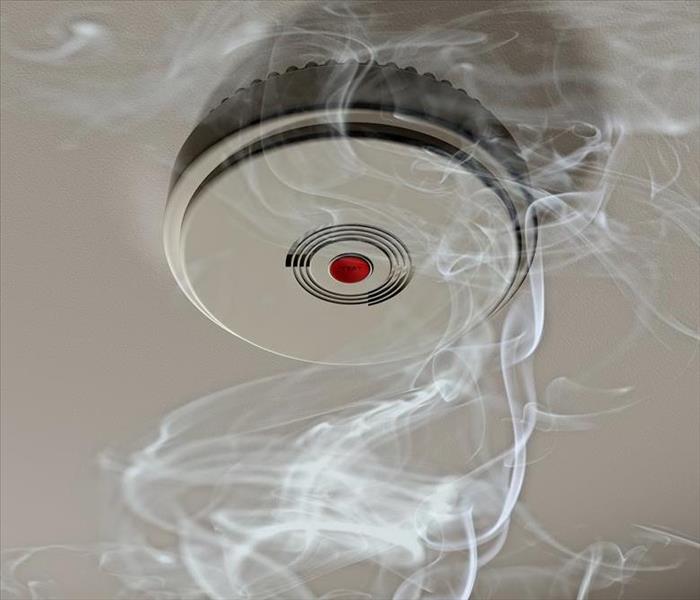 Follow these steps and be ready to avoid Fire Damage in your Property.
Follow these steps and be ready to avoid Fire Damage in your Property.
No homeowner in West Valley City, UT, wants to face the danger and damage of a house fire. Keeping your family safe during such an event should be a top priority. With a few fire preparation strategies, you can make sure that everyone knows what they need to do if the unthinkable happens.
Tips for Home Fire Prevention and Response
Of course, the best option is to prevent a fire from occurring in the first place. There are several things you can do to make a fire in your home less likely. Even if you employ all these prevention strategies, though, the whole family still needs to understand some fire safety basics.
Maintain Your Home and Habits
Safety starts by preventing potential hazards. Fire restoration experts recommend several tasks that you should turn into regular habits if you own a home:
- Store flammable liquids away from heat sources.
- Have your wiring inspected by an electrician once a year.
- Take preventative measures to keep pests that chew through cords or wires out of your home.
- Use space heaters and candles responsibly.
- Restrict smoking to outside areas and make sure that used cigarettes are disposed of properly.
Arm Your Home for Alert and Response
Smoke detectors are crucial for alerting your family when a fire begins. One detector won't cut it, though. The number you need depends on the size and layout of your home. Place one in a central location on every level.
You also need a detector for every sleeping area. Test them at least once a month to ensure they're working and to remind everyone what they sound like when they go into alarm. Replace the batteries at least once a year.
It's also a good fire preparation practice to have fire extinguishers stashed in various areas of your home. At a minimum, you should have one near the kitchen and others in easily accessible common areas on every floor. Everyone in the family should know not only how to use them but also when to stop using them and call 911.
Create an Emergency Fire Escape Plan
Despite all your best efforts, you may experience a home fire at some point in your life. Having a clear emergency plan that involves everyone in the family is your best chance of keeping them safe. Start by walking through your home. Find two ways to escape from every room. Plot escape routes and make sure children know what they are supposed to do.
Practice your fire escape plan at least twice a year. This gives all the people in your home a chance to actually go through the steps they need to take in an emergency. Agree on a meeting place that is away from the house and set up a communication plan just in case you get separated. The more you prepare, the easier it will be to remember it if necessary.
Most people will never have to endure a house fire. Every homeowner, however, needs to have a fire preparation plan just in case his or her prevention strategies fail.
How To Clean Valuable Items Damaged by Water in a Home
6/17/2022 (Permalink)
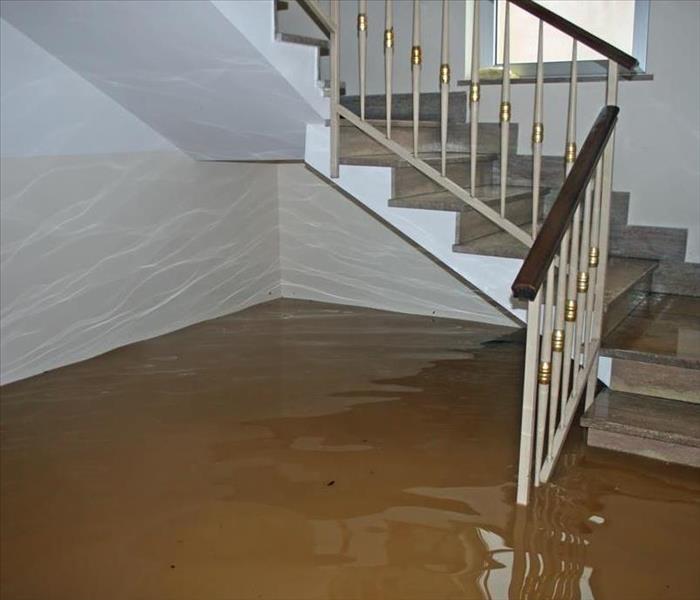 Your Valuable Items are also Valuable for us. Water Damage Specialists are ready to Help.
Your Valuable Items are also Valuable for us. Water Damage Specialists are ready to Help.
A broken pipe can cause a massive flood in your house that leads to thousands of dollars in damage. Yet fancy televisions and expensive cars are not always the most valuable items lost during a disaster.
Water can also harm treasured family heirlooms that are impossible to replace. Thankfully, with the help of water damage cleanup specialists, many of these items can be restored.
How To Salvage Items Damaged Due to Water in a Home
Even if you think the water in your West Valley City, UT, house is clean, it may be contaminated by unseen bacteria. You should thus wear the following whenever you touch the damaged items:
- Protective clothing
- Nitrile or vinyl gloves
- Respirator
- Goggles
Ideally, the remediation professionals will do most of the drying and dry cleaning. Here are some of the materials they can salvage.
Baskets
Twisting or wringing wet baskets could further damage them. Instead, the pros should get rid of the excess water by draining, blotting or rinsing the baskets. They should then put clean cotton sheets or paper towels inside the baskets. This should help the baskets maintain their shapes. The baskets should then be left to air dry.
Ceramics
Water in a home can cause pottery or ceramic materials to break. Do not attempt to glue them back together. Instead, place the broken items into labeled bags to keep everything organized. Once the pieces are dry, the restoration experts can decide the next steps.
Photos
Any wet photos need to be removed from their frames or plastic enclosures. To avoid further damaging the pictures, cut a slit in the enclosures so you can easily pull them away from the photos.
The restoration experts should take any pictures that are stuck together and place them in water. This should separate the photos. The pros will then either freeze- or air-dry the pictures.
Documents and Books
Important papers and documents can also be restored via freeze-drying. The restoration experts may have to rinse the materials first. The books should then be stacked spine-side down in strong containers. The containers will then be stored in a freezer that has a frost-free setting. Depending on the extent of the damage, the drying process could take weeks or months.
Art
Any pictures or art pieces behind a glass frame should be removed from the frame if possible. From there, the documents can be air-dried. If the item is stuck on the frame, keep it in the glass and turn it frame-side down to dry.
Paintings, meanwhile, should remain on the stretcher bars during the drying process. The pros should use distilled water and a clean sponge to remove any dirt or debris. As long as the paint is not flaking or cracking, the cleanup experts can blot the back of the paintings and then air dry them away from sunlight or heat. The paintings should instead be placed face-up on a surface that allows air to flow under the stretchers.
Even irreplaceable baskets, ceramics and photographs can be salvaged if they are harmed by water in a home. Emergency remediation specialists should help you enact the above strategies for restoring these items.
How To Stop a Leaking Toilet
6/8/2022 (Permalink)
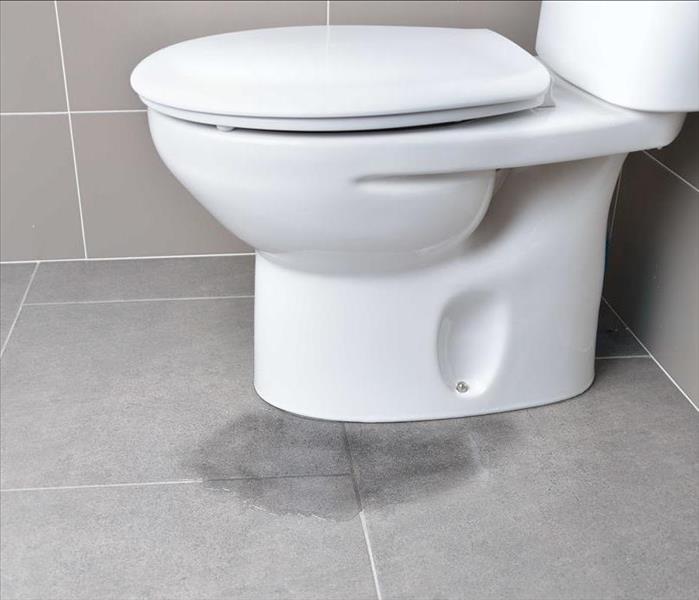 Our Professionals know how to Stop a Leaking Toilet. Just follow our Tips.
Our Professionals know how to Stop a Leaking Toilet. Just follow our Tips.
It's never a good sign to discover a puddle of water on your floor in your West Valley City, UT, bathroom. You know you have a job ahead of you if it's originating at the base of your toilet. Fortunately, though, there's a good chance you won't need a plumber. A leaking toilet can definitely be a hassle but is often a relatively simple fix. Discontinue use until it gets repaired because the problem can quickly worsen. Here are a few steps to resolve the issue if your toilet is leaking from the base.
Toilet Repair Steps for a Base Leak
1. Determine the Cause of the Leak
There are several reasons why your toilet has started leaking. Even a tiny leak can turn into a disaster if left, so it's critical to find the problem and repair it as soon as possible. The toilet is not the most sanitary place in your home, to begin with, but excess moisture can also lead to secondary damage like mold. An issue like this usually requires the services of water damage restoration professionals.
2. Inspect the Inside of the Toilet Tank
Carefully remove the lid from the toilet tank and keep an eye on the float and inlet valve. The inlet valve, also known as the fill valve, brings clean water into the toilet tank and bowl from the water supply line. Then, the water empties out of the tank and into the bowl when you flush.
The float on the inlet valve goes down and back up with the water, which allows the water to go into the tank. It controls the quantity of water allowed to flow into the bowl. If the inlet valve or the float are not working correctly, the result can be a leaking toilet.
3. Tighten the Base Bolts
A toilet has bolts on the base to hold it securely to the floor. You may notice the toilet rocking back and forth if the bolts are loose. An unsteady toilet isn't the worst problem resulting from loose bolts. The wobbling can break the wax seal between the toilet and the septic pipe. This will likely result in a leak at the toilet's base.
To tighten the base bolts, remove the plastic lids that are on top of the bolts. Two tee bolts must be tightened to properly create a water-tight seal. These bolts will keep the wax ring in place.
4. Replace the Wax Ring
The wax ring attaches the toilet to the drain and seals the water from seeping into the bathroom floor. The ring could be worn or damaged, which is a sign that you need to replace it. Ensure with the hardware store employee that you get the right ring to fit your specific type of toilet, as they can vary from different toilet models. You can also take the old ring with you.
Whether an old toilet or a newer one, it is always possible for it to malfunction. Therefore, it's good to know some tips on handling it beforehand in case you have to deal with a leaking toilet.
4 Steps of Action To Take After Storm Damage
6/7/2022 (Permalink)
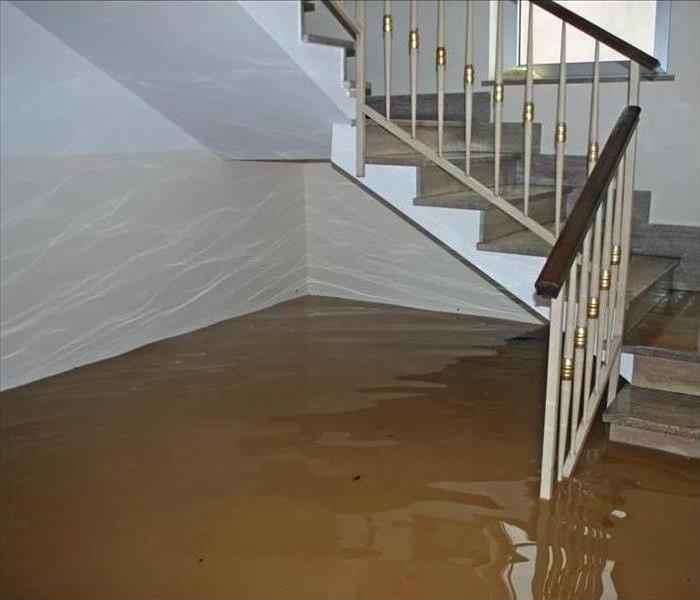 The Specialists suggest you these Steps of Action After Storm Damage.
The Specialists suggest you these Steps of Action After Storm Damage.
Whether you live in an area where the seasons bring an increased risk of hurricanes or an area where a home flood is more likely to occur because of broken pipes, you need to know how to respond after your home has been affected by flooding. Heavy rains, aging pipes, and backed up sewer systems are all potential causes of flooding in West Valley City, UT. Dealing with water or storm damage can be summed up in several vital steps:
Steps to Dealing With Storm Damage
- Begin Drying Out Your Home
This may require shutting off the water to your home. It could also entail using buckets, mops, towels, or wet/dry vacuums to remove water. It's a good idea to open windows (if it's dry outside) and gather fans to circulate the air and prevent moisture from settling on surfaces.
2. Contact Professionals for Advice About Proceeding
There's a lot of potential for errors and further damage when the sheetrock, carpeting, and other elements of the home are covered with water. Call your insurance company for a better understanding of what your policy covers and whether there are specific steps you should take. This is also a good time to call a storm or water damage restoration company. These professionals have resources, training, and tools to appropriately handle cleanup and repairs.
3. Separate Items To Save and Discard
When it's safe, carry wet belongings outside where they can dry. Separate items with too much damage for repairs but don't haul them off yet. It's important that the insurance adjuster can see what you've lost in the home flood.
4. Dry and Disinfect Your Belongings as Quickly and Thoroughly as Possible
It doesn't take long for mold to start growing. If you've stuffed your wet clothes in a plastic bag, for instance, mold may set in within 24 hours. Instead, get your clothes, blankets, and similar materials in for laundering as quickly as you can. Some furnishings, such as mattresses and the pad under your carpet, are prime environments for mold.
It's very important to resist taking steps after a home flood until you've spoken with your insurance provider and restoration professionals. Prompt action is required, so get into contact with the pros as soon as you can.
Learn How To Use a Snake for Minor Drain Clogs
6/7/2022 (Permalink)
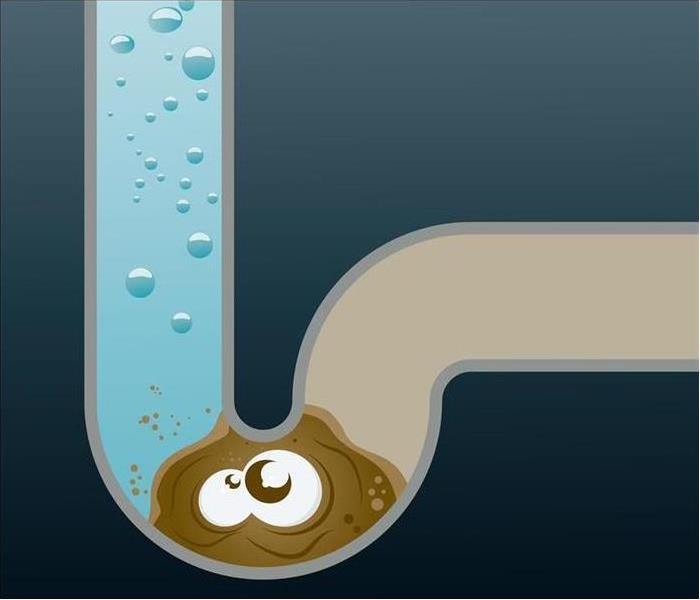 Clogs in the bathroom or kitchen sink are relatively common occurrences in homes.
Clogs in the bathroom or kitchen sink are relatively common occurrences in homes.
Clogs in the bathroom or kitchen sink are relatively common occurrences in homes, and they do not always require a phone call to a handyman. Most clogs occur within the first few feet of pipe below the sink, which means that instead of calling a remediation company in West Valley City, UT, you can use a standard household auger or snake to relieve the clogged drain.
However, it is essential to use the tool correctly to avoid doing further damage, like a pipe break. Freeing up a stopped sink with an auger is a four-step process.
- Uncoil and Push Into Drain
you will want to uncoil about a foot of the snake, and then gently push the head of the auger into the drain. Continue feeding the auger into the pipe until you feel some resistance. Know that the first sign of resistance is likely not the clog; it is probably the trap. You want to rotate the snake, pushing it gently past the trap before continue further into the pipe.
- Feel Resistance, work it out
When you feel resistance again, you want to repeat the process above. Gently push into the clogged drain while rotating the auger. You can also use a slight forward and backward motion to help break away the clog. If you push too hard, you risk tangling the auger within the drain, at which point you will need a professional's help.
- Free Movement, Recoil the Snake
When you feel the auger push through the clog and move freely through the pipe, it is time to recoil the snake, pulling it free of the drain. Once the snake ifs removed, run warm water down the drain to ensure the clog has cleared.
- Call a Professional
If the clog is not free, or if you did not experience resistance, then it is time to call a professional. Plumbers and remediation experts have commercial augers that can reach further into your system. Do not use a drain cleaner.
If your sink is clogged, it is OK to try and remove it on your own. However, if you are struggling, make sure to call a professional to avoid doing more damage.
What You Should Know About Mold Cleanup After a Storm
5/24/2022 (Permalink)
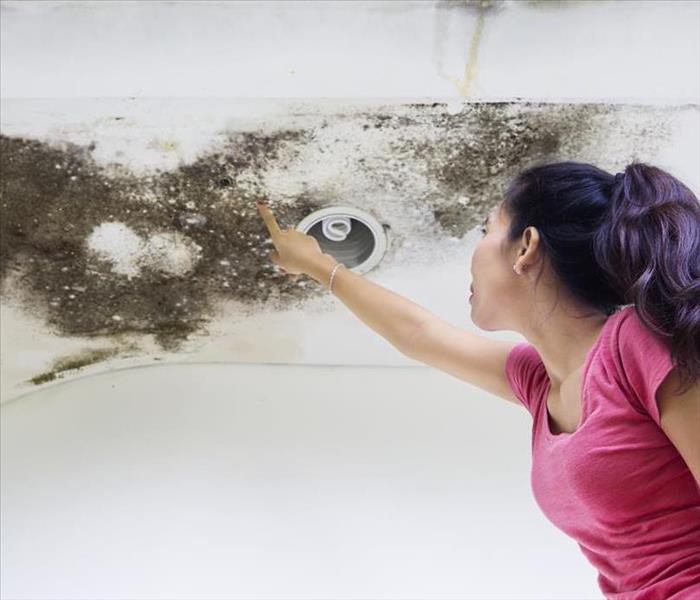 Let Our Professionals help you with the Mold Cleanup After a Storm.
Let Our Professionals help you with the Mold Cleanup After a Storm.
As a homeowner, you owe it to yourself to take care of the property through regular maintenance, home security, and protection against damages due to fire, theft, and even certain types of storms. Insurance policies vary in terms of what perils are covered, especially in certain locations.
After a hurricane or severe thunderstorm, you may experience water damage at your home in West Valley City, UT. Whether as a result of a leak in your roof or floodwater, unaddressed water damage can lead to other serious problems such as mold growth. Here’s what you should know about cleanup.
Important Information to Consider
Mold Removal vs Remediation
You may have heard terms such as cleanup, removal, and remediation used interchangeably, but they have very different meanings when it comes to your home. Removal is simply the act of disposing of objects and surfaces covered in mold. Remediation involves a comprehensive approach that includes the following:
- Assessing the extent of damage
- Removing affected items
- Preventing mold growth
- Employing special cleanup techniques
- Repairing and rebuilding as needed
Cleaning up mold is not a DIY approach. You need to contact a professional mold remediation provider to get the job done.
Difficult Cleanup
The reality is that mold is not something that is easily cleaned with bleach. Mold spores exist everywhere, and even though you may not see mold on a visible surface, it can easily and quickly spread beneath floors, behind walls, and above ceilings. This fungus also can survive in cracks, crevices, and other hard-to-reach places.
Do you have the equipment and energy to cut into your house structure to confirm the source and the extent of the spread? Is it even safe for you to do so? Restoration professionals are fully equipped and experienced in finding out where the mold is to return your home to pre-damage conditions.
Stop the Spread
Mold can spread quickly. Let’s suppose you have flooding in your home that was limited to one area. In the time it takes for you to acquire pumps, wet vacs, and other water removal items, damage can spread to another room unbeknownst to you. Remediation professionals have equipment that can isolate affected areas and spare parts of your home that are unaffected. They know the best way to approach the job to avoid double duty and other mistakes that can extend the cleanup period.
Odor Control
Mold isn’t just unsightly. It also leaves a musty odor that can affect the building structure as well as other possessions. The professionals have the equipment to remove unwanted smells from your house and its belongings. They understand which products are the best for getting the odor out of the air, fabric, upholstery, carpets, rugs, and other items which may not be otherwise damaged. The professionals do what they can to save objects by cleaning and repairing, more affordable alternatives to replacement.
If you have mildew or mold from flooding, burst pipes, or other types of water damage, you’ll need to call the pros right away. You want a complete approach that does more than just removal. The professionals know how to prevent new mold growth and minimize the time and cost associated with a full restoration.
Understand the Insurance Claims Process
5/19/2022 (Permalink)
 Contact us. We can Help You with the Insurance Claims Process.
Contact us. We can Help You with the Insurance Claims Process.
When your business in West Valley City, UT, has been hit by disaster, you and your insurance agent are under a lot of pressure to get the cleanup and repairs completed as quickly as possible. The SERVPRO Claims Inventory System is set up to simplify the gathering and sharing of every detail of the insurance claim.
All the Details of Your Insurance Claim in One Place
To fully understand the benefits of this system, you need to know more about how the claims process works:
- What is covered under the policy?
- How is the payment amount determined?
- When will payments arrive?
- Who will the insurance company pay?
The answers to these questions and others you might have are multi-faceted. For example, the type of policy or policies you have affects your coverage; a standard commercial property insurance plan may not include business interruption coverage. The amount of the payment is affected by factors such as the adjuster's determination of property and content damage, your policy limits, any coinsurance percentage, and whether you've insured your property for replacement cost or actual cash value. The Claims Inventory System makes it possible for your insurance agent to record and keep track of these details.
A Central Location for Sharing Information
Your agent works closely with you and with many other professionals during the recovery process. These professionals include the team of property damage cleanup and reconstruction technicians, the insurance adjuster, your private adjuster, any municipal officials, and all of the various contractors involved. The Claims Inventory System provides a central access point to information from each of these parties.
Access to Research and Statistics From Your Neighborhood and Across the Country
As your insurance claim is processed, your agent does a lot of research and runs comparisons to ensure a balanced claim. The inventory system makes it easier to access information from your region, allowing your agent to quickly sort through data related to similar types of claims, the allowable causes of loss, and the prices associated with completing each part of repairs and recovery. Naturally, the numbers change as initial estimates are recorded and then updated. With all of the data in one location that can be accessed by each party, the information you receive can be accurate and up to date.
An Efficient Conclusion to Your Claim
With a convenient dashboard, your agent can quickly gather the facts necessary to complete an accurate claim. Logging in to one site on a computer is much faster than making multiple phone calls, searching through documents from various physical locations, and trying to work out complex algorithms. It also allows your agent to quickly find answers to the questions you have as the process moves forward.
The SERVPRO Claims Inventory System means that your insurance claim can be completed quickly and accurately. This also speeds up the actual work as West Valley City, UT, contractors can plan their work, efficiently coordinating each step with other professionals.
The less time your business spends on hold, the better you can survive and return successfully after a disaster. When it comes to business interruption, the speed of your recovery is crucial to your long-term success.
Post-Fire Cleanup: Why Owners Should Prioritize Content Cleaning
5/11/2022 (Permalink)
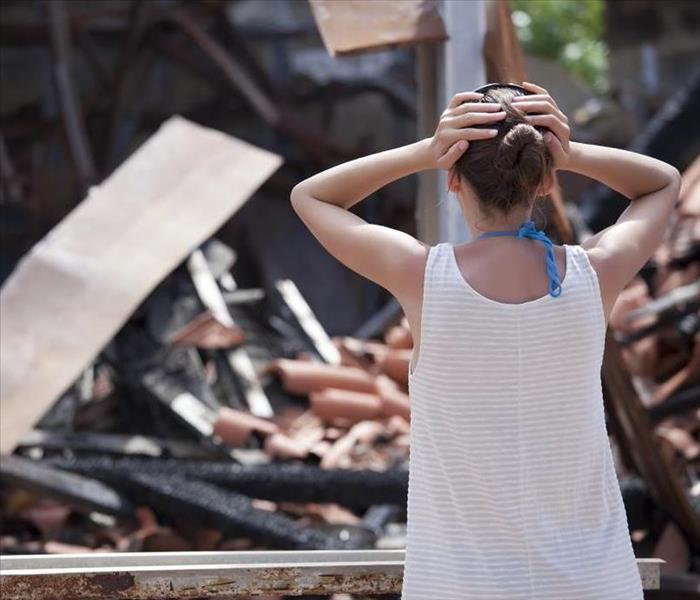 Learn More about Post-Fire Cleanup. Let the Professionals Give you a Hand.
Learn More about Post-Fire Cleanup. Let the Professionals Give you a Hand.
When a fire devastates a building, the blaze impacts more than the structure. It also affects assets inside, including essential documents, equipment and belongings. In West Valley City, UT, owners may think all is lost; however, there is hope.
When you work with professional fire restoration teams, technicians focus on cleaning the building and personal property, offering proprietors a chance to keep essential possessions.
Dry-cleaning technology, deodorizing equipment, and careful inspections can save items and reduce replacement costs. During post-fire cleanup, reach out and ask about content evaluation. The following are essential points to understand about the process and its benefits.
The Value of Content Cleaning Services
When sparks fly, they often impact several elements, leaving owners to handle more than soot and ash. It's a pile of problems, with each one requiring specific care. Thus, when you're considering remediation and cleaning needs, it's imperative to evaluate several areas of concern:
- Unpleasant odors
- Stubborn stains
- Moisture saturation
- Structural deterioration
- Mold and mildew exposure
Cleaning establishments understand each of these issues. They have training and certification to detect any long-term trouble and decide which items may qualify for cleaning rather than removal.
You may consider tossing items. Sometimes that is necessary; however, replacing everything touched by the fire proves challenging and costly. Do you have specialized equipment and electronics? These pieces didn't come cheap. Getting new ones could take time and add thousands to your property loss claim.
In addition, you may not have the ability to replace some documents or images. These pieces prove essential to your operations. Pairing with content experts could keep these objects in your possession.
Factors That Influence Cleaning
Fire restoration professionals scrutinize contaminated smoke belongings. They must test each piece, concluding whether dry-cleaning technology or abrasive cleaning techniques provide effective sanitizing and deodorizing needs.
The team wants to ensure that whatever returns to the facility has minimal chance of future damage or contamination. Nonporous objects remain easier to clean as the soot and water particles do not penetrate the core. The crew may deem them acceptable for ultrasonic procedures.
Effective Methods for Smoke and Water Removal
Remediation technicians have a variety of tools to use. First, they may remove belongings to content storage. Relocation moves items away from hazards and minimizes secondary troubles such as mold and water damage. In addition, teams have access to specialized equipment that meets your assets' unique needs.
It's not enough to have one approach, so specialists train in various fields to match the proper cleaning method to your situation. Dry cleaning delicately and effectively removes particles from uniforms and clothing. Foam cleaning works well with cloth and materials likely to shrink.
Electronics and documents undergo a series of innovative processes. Televisions and computers, for example, demand evaluation for corrosion and soot. An electronic expert works to eliminate these concerns and get the product back to normal. Fragile, damaged papers receive gentle care, undergoing various methods such as dehumidification and vacuum freezing or thermal drying.
If you're worried that a fire could ruin it all, take a deep breath. Work with restoration professionals in West Valley City, UT, to assess the situation. Allow experts to use dry-cleaning methods and ultrasonic procedures to clean and deodorize your valuables.
Reasons To Call SERVPRO for Every Mitigation Need
5/7/2022 (Permalink)
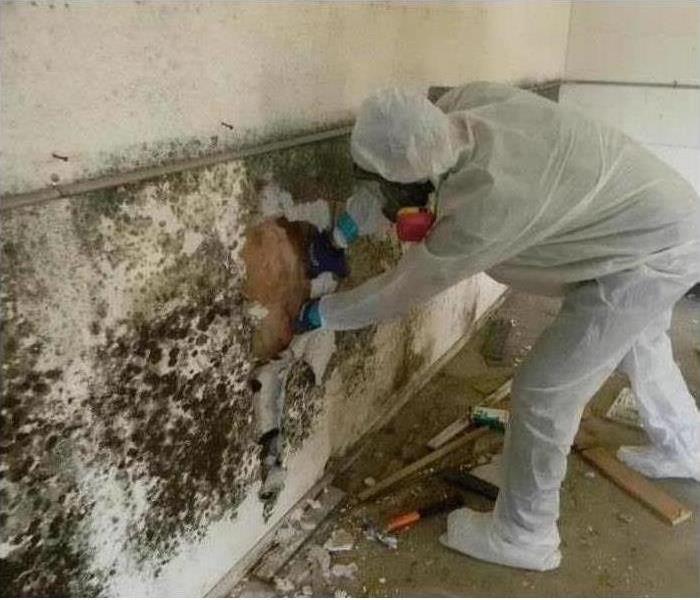 SERVPRO's specialists are certified and trained with proper techniques
SERVPRO's specialists are certified and trained with proper techniques
When homeowners need repairs and restoration, it's important to be able to call someone they trust. Damage to homes in West Valley City, UT, can result in costly insurance claims and secondary damage if it's not mitigated quickly and properly. SERVPRO commits to being Faster to Any Size Disaster through a reliable network of local technicians. Here are some reasons to choose them over other companies.
2 Reasons to Choose SERVPRO
Broad Experience
The certified restoration experts at SERVPRO are trained in techniques to address a variety of problems:
- Fire damage
- Flood damage
- Storm damage
- Mold damage
Their broad expertise comes in especially handy after disasters that encompass several types of damage. For example, a fire that breaks out in a home can take a lot of water to put out, leaving behind not only smoke damage but also water issues. Full remediation requires a team that moves Faster to Any Size Disaster to address everything that is wrong with the home.
Vendor Program
As a preferred vendor for many insurance companies, SERVPRO offers benefits that make it stand out among its competition. The Claims Information Center provides all the information about each cleanup job necessary for filing an accurate insurance claim. Any changes to the process are updated in the system in a timely manner, providing a level of transparency that is hard to beat. When clients call 1-800-SERVPRO, they are referred to a local team that has met the stringent qualifications of 21 guidelines for service. The technicians provide 24-hour service to ensure that the damage is assessed and addressed as quickly as possible.
SERVPRO is committed to being Faster to Any Size Disaster by utilizing a trusted network of experts throughout the country who can provide quick, quality service. Wherever there is damage to a home after a fire, flood or storm, there is likely a team of SERVPRO technicians nearby, ready to mitigate it.
The Mitigation Process for a Wet Crawl Space
4/21/2022 (Permalink)
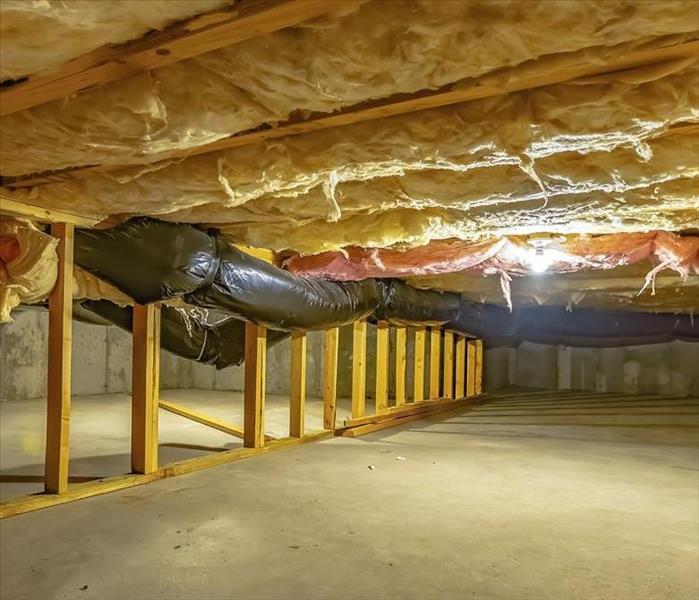 Learn more about The Mitigation Process of Wet Crawl Spaces and Avoid Damage in your property.
Learn more about The Mitigation Process of Wet Crawl Spaces and Avoid Damage in your property.
There are many spaces in commercial buildings in West Valley City, UT, that are susceptible to excess moisture. It's easy to detect when walls or ceiling tiles are affected, but regular inspection may reveal water in the building's crawl space, too.
To avoid mold growth and other secondary damage that can occur due to a wet crawl space, SERVPRO technicians must mitigate the water damage efficiently and thoroughly.
Steps of the Mitigation Process
Find Source
One of the first things that the water damage restoration experts will do when they arrive on site is to figure out where the floodwater is coming from. There are several common ways that water can flood a crawl space:
- Extra groundwater that seeps in
- Landscape grading that slopes toward the building
- Excess water in flower beds near the foundation
- Broken pipes or sewer lines
- Poor drainage from rainwater runoff
Extract Water
Standing water continues to cause damage every minute it is present. SERVPRO technicians pump the water out of the space quickly upon arrival. Their fast action stops the seepage in its tracks, thus reducing the overall cost of repairs.
The removal of the excess water from the wet crawl space will likely reveal ruined materials that need to be torn out. Any damp insulation must be discarded. Drywall or flooring that is saturated may not be salvageable. The team removes the parts of the structure that are no longer viable.
Clean Wet Crawl Space
The source of the water gives the mitigation team some information regarding how contaminated the space is likely to be, but the pre-testing they do guides the cleanup process more reliably. It assures that they use the correct procedures and chemicals needed to fully disinfect the area and prevent additional problems from surfacing later. This commitment to excellence is why SERVPRO is a preferred vendor for many insurance providers.
Dry Area
Even after the crawl space is cleaned, it is probably still wet. Before they start rebuilding it, the technicians make sure the space is completely dry. This prevents a second claim for mold damage that results from the original covered peril.
Replace Ruined Materials
The last step of the process is replacing the parts of the structure that were too damaged to remain in the space. The restoration team adds new insulation and installs new drywall and flooring. After they are finished, it will look "Like it never even happened."
Many companies only handle mitigation of the damage done by flooding, but SERVPRO takes care of your commercial clients from assessment through restoration. After they are finished, the building is back to normal. You get one estimate for the whole job, which you can access at any time through the Claims Information Center. Any time your clients have a wet crawl space in the building, they can depend on SERVPRO to get the job done well.
No matter how large an area is affected, these technicians are Faster to Any Size Disaster. Speedy and thorough service from mitigation to restoration is just one of the reasons many companies that insure commercial properties list SERVPRO as a preferred vendor.
How Can I Protect My Business From a Fire Disaster?
4/13/2022 (Permalink)
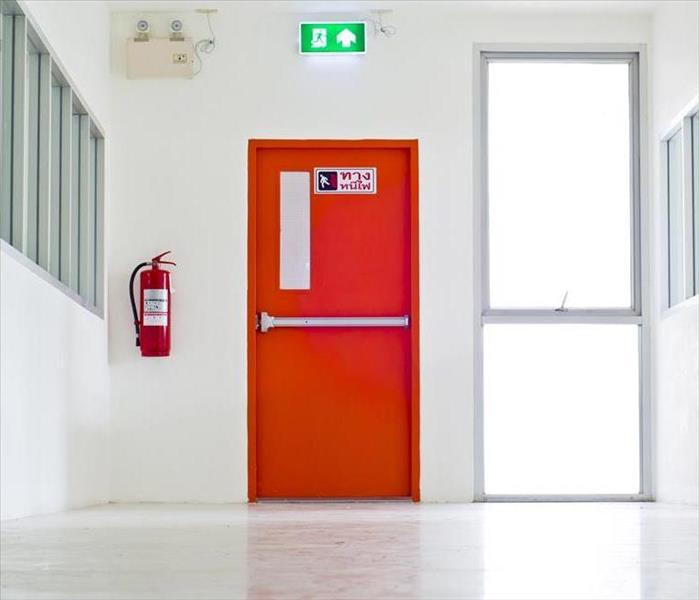 Protect Your Business From a Fire Disaster by Following These 4 steps.
Protect Your Business From a Fire Disaster by Following These 4 steps.
A commercial fire is one of the most devastating things a business owner can experience. Not only does it cause extensive loss of property, but it can also result in injuries to employees. If all of this isn't bad enough, fire damage can cause the business to shut down for an extended amount of time. It might be severe enough to put it out of commission forever due to the financial strain.
Unfortunately, tragedies sometimes can't be avoided, but a fire preparation plan can significantly reduce the chances of flames breaking out. Being prepared can also considerably decrease the loss by learning proper extinguishing methods. Whether your West Valley City, UT, workplace only consists of a couple of employees or thousands, disaster preparation can always add more peace of mind for your company's future.
4 Steps for Creating a Fire Safety Plan
1. Get Routine Inspections of Fire Alarm System
A working fire alarm system is essential for quickly notifying everyone involved if smoke or fire is detected in your building. People in the building and emergency services will be warned as soon as the alarm activates. A fire suppression system will also begin putting out the flames to minimize the damage until firefighters arrive. Therefore, it is vital to have your fire alarm system regularly inspected and maintained professionally.
2. Provide Emergency Procedures in Writing
Sometimes emergencies can't be avoided no matter what proactive steps you take to prevent them. It is critical to have your fire preparation details in writing and post them in multiple overt locations throughout the building. Everyone must have easy access to them daily and read the materials at least once.
The emergency plan should also depict all evacuation routes with clearly marked exits. Include other essential details, such as emergency services information and important phone numbers, including your preferred fire damage restoration company and other specialists.
3. Train Employees on Fire Prevention
One of the most successful ways of decreasing your fire risk is to train your employees on fire prevention and safety. Make rules for your employees about using space heaters and prohibit burning candles. Regularly inspect all areas of your building to look for potential fire hazards. Threats often include piles of papers or other flammable materials near heat sources.
Keeping all areas clear of clutter will decrease the chance of fire. Once you have completed an initial cleanup, call a fire safety professional to assess your building's fire risk. They can advise you on other safety efforts to take.
4. Don't Forget the Fire Extinguishers
Your fire extinguishers should be inspected regularly to ensure that there are enough of them in the correct locations, that they are installed correctly according to laws and regulations, and that they are in good working condition. Also, provide training for your employees to teach them to properly use a fire extinguisher. After all, an extinguisher is not helpful if it's not used correctly in an emergency.
As a business owner, it's your responsibility to assure the safety of your employees. This requires you to perform specific fire preparation safety measures. Keeping these details in mind and sharing them with others can protect your employees and overall business.
What To Do When a Pipe Breaks in Your Home
4/9/2022 (Permalink)
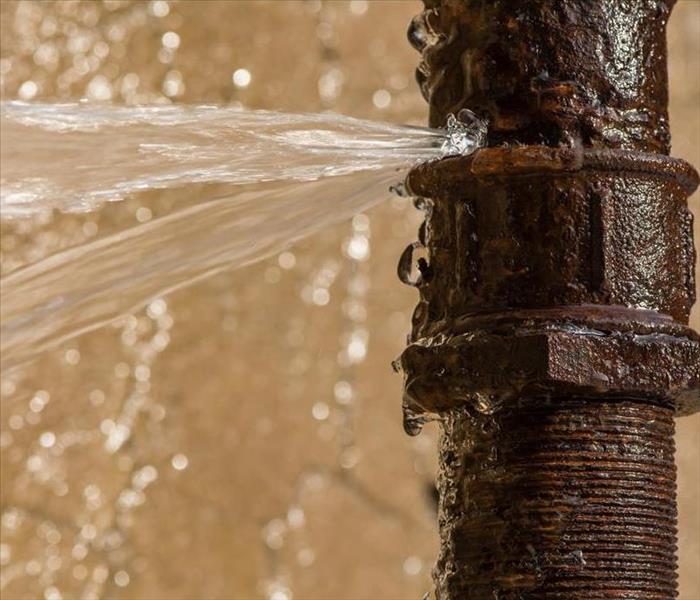 Tips to act Efficiently When a Pipe Breaks in Your Home.
Tips to act Efficiently When a Pipe Breaks in Your Home.
Bursting pipes can prove chaotic, expensive and time-consuming, filling a home with excess water and leading to significant overhauls. Those steel or copper tubes break for many reasons, including severe changes in pressure and temperature. In addition, corrosion and external objects may also cause unexpected and unpleasant busts.
Within seconds, homeowners in West Valley City, UT may face a fast-paced breach where water sprays throughout the room. How do you get it to stop? What action should you take? These bursts demand swift attention and thorough cleanup. Be ready for the unpredictable.
What can you Do to Reduce Water Damage?
The following are measures homeowners can take to reduce impact and begin essential home repairs.
1. Shut Down the Bursting Pipes
Above all, owners must focus on cutting off the water supply, thereby limiting the amount of moisture that enters the home. Although helpful to humans and plants, this water proves hazardous to structural materials. The dampness quickly saturates into porous materials. The wetness leads to rot, mildew and mold when allowed to linger.
Therefore, priority number one remains cutting off the flow. Stop, think and locate the closest shut-off valve. If the one in the home doesn't work, go outside and close the main outlet. Do whatever it takes to stop moisture from entering the premises.
2. Fix the Break
Contact professional water restoration services in West Valley City, UT to evaluate the situation. These experts should assist in locating the source of trouble. They should immediately fix broken pipe elements. With the original cause under control, owners may concentrate on salvaging and cleaning the damaged property.
3. Assess the Location
With the plumbing problem corrected, remediation specialists can examine the rooms for secondary damage, such as fluid buildup and microbial exposure. Using moisture reading meters, the team determines how much of the home suffered saturation. They may also take specimens from the walls, air and ceiling (anything impacted from the break), sending these collections out for testing.
The results allow experts to determine if pathogens inhabit the space. The professionals use the information to create a detailed plan to sanitize and restore the house.
4. Agree To Quick Tear Outs
Water damage, especially within a dark and humid space, activates spore reproduction. Therefore, the broken pipe leaves owners with more to consider than a plumbing bill and dampness. Owners must consider the possibility of mold development.
To curtail this predicament, permit restoration employees to remove materials of concern. The team may take out carpeting, drywall and belongings that suffered excess flooding. This decision reduces the number of spores and pathogens to safeguard from spreads.
5. Dry Out
Air out the room, concentrating on extracting as much water as possible from anything left. Remove any standing water, and use dehumidifiers to pull moisture from places you cannot touch or see. These devices use heat to pull fluid from those porous materials. This step helps you lessen the severity of the water conditions.
When you observe water spraying throughout the room or puddling up on the floor, don't panic; instead, kick into action. Immediately shut off the water supply and call for professional help.
Attend to the bursting pipes and initiate remediation efforts. Swift and efficient measures mitigate secondary damage, saving homeowners from further expenses and repairs.
Understanding the Water Damage Assessment Process
4/8/2022 (Permalink)
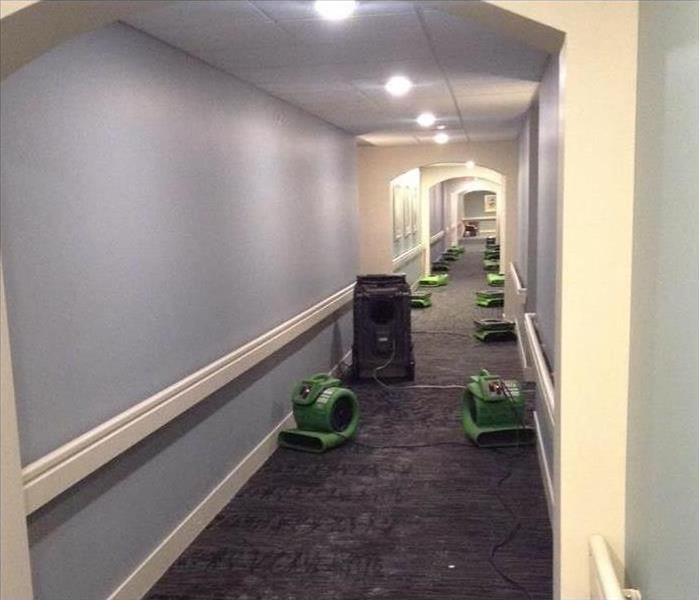 Learn more about the Water Damage Assessment Process by following our Tips.
Learn more about the Water Damage Assessment Process by following our Tips.
Your commercial property in West Valley City, UT, may be inspected regularly to ensure that it is flood resistant. A broken pipe or heavy storm, though, can get past all the precautions you have put in place.
When water restoration experts arrive at your building, they conduct a series of assessments and pretesting to tell them exactly what needs to be done to fix the problem.
Water Inspection
Water damage can vary greatly in terms of extent and contamination. First, technicians have to determine the water source:
- Broken or leaky pipe
- Sewer backup
- Storm runoff
Water is clean when it comes straight out of a pipe that feeds your faucets or supply lines, but that doesn't mean that it stays clean. By testing the water's contamination level, specialists can determine the equipment and procedures they will need to mitigate the damage. Then they formulate a plan that you can include on your insurance claim to get the payment process started.
Content Inspection
After the water is identified and removed, technicians start to move out the contents of your building, particularly those that may stain the floors and cause more damage. They also inspect each item to determine whether it can be repaired or needs to be replaced. Through this pretesting process, they identify items that are not total losses, thus reducing the amount on your insurance claim.
Structure Inspection
Walls, ceilings and floors often bear the brunt of water damage. Your insurance agent will likely want to know how much of the building is affected, and the technicians assess the damage before any repairs begin. If they suspect mold damage, they can test for growth and determine if it was caused by the covered incident. This step helps them get an accurate estimate for your claim.
By pretesting your building and its contents, restoration experts gain the big picture for the remediation process. This can lower your claim and improve its accuracy from the start.
How Much Does Mold Removal Cost?
3/21/2022 (Permalink)
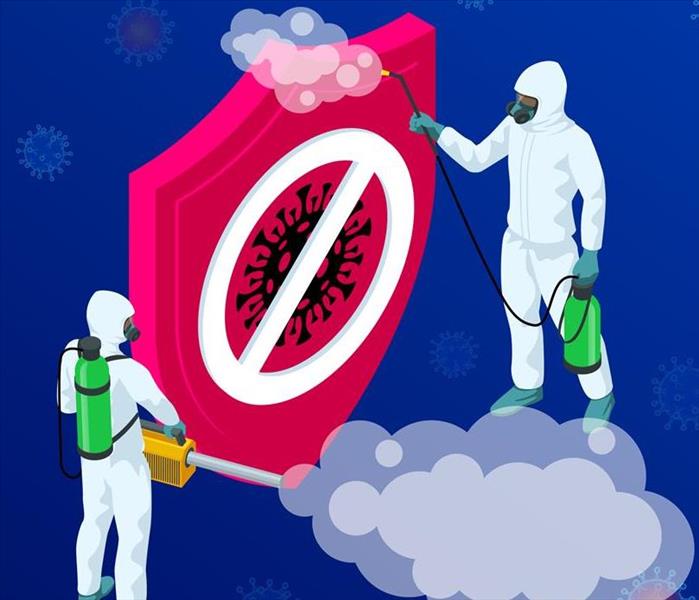 Learn more about Mold Removal and its Costs by Following These Tips.
Learn more about Mold Removal and its Costs by Following These Tips.
When there's a fungus in your home, it must be removed as quickly as possible. Otherwise, it will grow and create an even bigger, more financially draining problem. Whatever stage you're at, you're likely dreading this unexpected expense. Knowing the cost in advance should help cushion the blow. Here's how you can figure out the potential price of mold removal from your residence in West Valley City, UT.
Know That Multiple Factors Affect the Cost of Mold Removal
On average, having a professional remove mold runs anywhere between $500 and $6,000. Several factors may impact the final tally, including:
- The extent of the damage
- The types of materials that are infected
- The company you hire to get rid of the mold
- The location of your home
The classification of mold also plays a factor. Black mold removal, for instance, is typically more expensive to get rid of than less dangerous types. Safety equipment, such as respirators and protective suits, are necessary and create additional charges.
Hire a Mold Inspector
The next step toward determining the cost is bringing in an inspection professional. This is especially necessary when fungal interlopers have infected drywall or wood surfaces, the extent of which can be difficult to gauge. Qualified ones can also refer you to a mold remediation company with a stellar reputation.
Beware that not all mold inspectors are trustworthy. Before hiring one, make sure the person is accredited. Read online reviews to verify honesty.
Mold inspectors typically cost between $200 and $600. Comprehensive packages include an air test, which runs from $30 to $150. Find out whether this expense will be added on or is part of the base price.
Hire a Mold Remediator
Hiring an expert to tackle your problem is usually the best decision. Before objecting to the cost, understand the services that someone devoted to the profession provides.
Mold cleanup professionals remove items destroyed by water damage or infested with fungi. Moving these objects comes with risk. Allowing a person intimately familiar with proper handling procedures to do it for you means your family remains safe. Wall-to-wall rugs and drywall may be unsalvageable.
Mold remediation renovators have the expertise to replace these pieces of your home so that they look brand new. Once reconstruction projects are complete, they vacuum everything with a HEPA filtration system to assure no spores are still hanging around.
If the mold in your home is limited to crawlspaces, expect to pay between $500 and $4,000. When fungal invasions extend into ducts, attics, and walls, the cost generally falls between $2,000 and $6,000. Widespread structural damage is worst of all. Such scenarios can run homeowners between $10,000 and $30,000. Prevent your situation from reaching this level of seriousness by taking action as soon as possible.
Mold removal is essential for every home experiencing a fungal invasion. While the cost is unwelcome, it's a task that must happen to preserve your residence's resale value. Cushion the shock by learning ahead of time how much it will cost.
4 Questions About Fire Damage and Renters Insurance
3/14/2022 (Permalink)
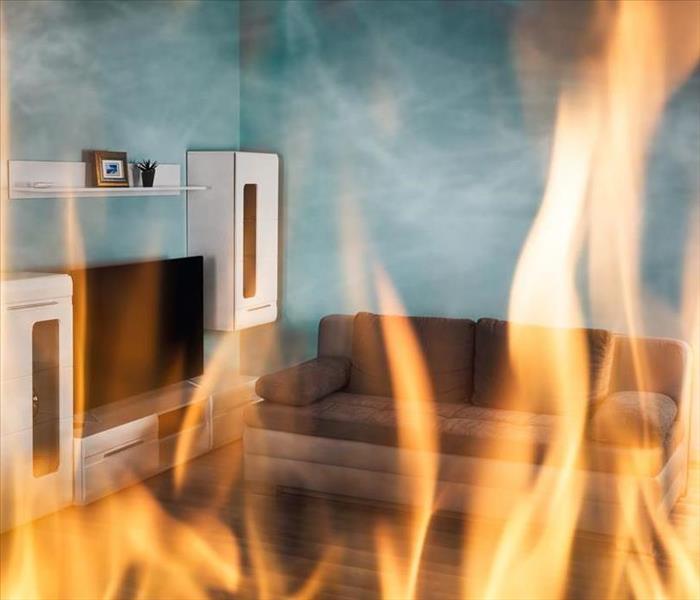 Learn more About Fire Damage and Renters Insurance by following These Tips.
Learn more About Fire Damage and Renters Insurance by following These Tips.
When you move into a new rental property in West Valley City, UT, it's important to have a renters insurance policy in place from day one. Your landlord probably required that you hold a policy in order to move in because your policy covers all of your personal belongings while the landlord's policy covers the building.
In the event of a fire at your rental property, your insurance policy can do a lot to cover you. Here are four questions you might have about how fire damage is covered with your insurance.
Questions to consider about Fire Damage and Renters Insurance1. Will My Belongings Be Replaced If They Are Damaged in a Fire?
If your personal property is damaged in a fire, your insurance policy likely covers the replacement of those items. One important thing to ask about your policy is whether you will receive actual cash value or replacement cost coverage. If there is fire damage to your three-year-old leather couch and your policy offers actual cash value, that means that your policy covers the current value of your couch, not its original price.
Ultimately, that means that you don't get as much money toward new furniture. Replacement value means that your policy pays to replace your damaged couch with a new, similar couch. Keep in mind that there are caps on policies that cover personal property. If you own expensive jewelry or a lot of computer equipment, consider taking out an additional insurance policy to ensure that you're covered.
2. How Can My Insurance Help Me If I Can't Stay in My Apartment?
A fire that does major damage and requires you to leave your apartment is covered under your insurance policy. If you can't live in your rental property until the landlord works with a fire restoration team to repair your home, your insurance policy will pay for a hotel and other associated living expenses such as food and transportation.
3. Are My Roommates Covered Under My Policy?
Each renters insurance policy is for an individual. Even though you share an address with a couple of roommates, you each need to carry your own insurance policy. Imagine that you started a kitchen fire that ruined one roommate's personal belongings and the other roommate hurt their wrist trying to use the fire extinguisher. One policy can't cover you all because there's a conflict of interest. Instead, you each need your own policies to cover your belongings and to pay medical damages to your roommate.
4. How Do I File a Claim with My Insurance Company?
After a fire, as soon as you can safely do so, contact your insurance company. The longer you wait to file, the longer it takes for the insurance company to get you your money. If you can, take pictures of the damages to submit with your proof of loss form. The company will ask you to provide an inventory of the items that were damaged. Once you submit your claim, you'll have to wait for the claim to be processed and approved before you can get the finances to cover the costs of replacing your belongings.
A renters insurance policy is important to have because you never know what sort of emergency will require you to file a claim.
How To Prepare Your Business For a Storm
3/9/2022 (Permalink)
 Be Ready for a Storm Event and protect your Business from Storm Damage by following These Tips.
Be Ready for a Storm Event and protect your Business from Storm Damage by following These Tips.
When you own a business in West Valley City, UT, you know just how tricky operations can become during and after a big storm. All kinds of natural catastrophes can negatively impact your business. Flooding can lead to physical damage of inventory or other physical assets, while other damage can interrupt your company's ability to serve its customers. These kinds of destructive tendencies can leave you high and dry if you are not prepared.
This is why having a proper understanding of storm insurance is so important. In the event of a large storm such as a hurricane, tornado, or flood, you want to make sure you have taken the right precautions to protect your enterprise. Here are the best ways to prepare your business for a storm.
Important Tips to be Ready for a Storm Event
Backup Important Data
If the power goes out or a lightning strike fries your online systems, you do not want to be the person who loses all of your much-needed data. Take the time to backup your systems to an offline server or another similar protection device so that in the event of a loss of data, you have what you need on a separate device.
Make Sure You Have Storm Insurance
This is perhaps the most crucial step that you can take. If you do not already have storm insurance for your business, then take the proper steps to find a good insurance company that you can trust and buy coverage that will be in effect prior to the start of a potential storm. If you do already have insurance coverage for this matter, then call your insurance company or an insurance company representative and double-check that your coverage is active and that you understand your plan inside and out.
Essentially, you want to make sure you are prepared and know just what storm insurance covers as coverage varies from state to state.
Batten Down The Hatches
Take care to make sure that the physical structure of your business is as protected as it can be. This might mean boarding up windows, securing outdoor objects, and other processes that will keep your damage to a minimum.
Let Your Employees and Customers Know
Another important thing to do is to utilize social media to let your customers know what your business is going to do as a response to the storm. You should also use internal company communication to do the same for your employees. Clear communication is always best.
Be Prepared To Cancel Operations Indefinitely
This might be a hard pill to swallow as a hardworking professional. However, storms are out of our control and if they become too dangerous, you must put the safety of people ahead of operations. Know when to call it and send everyone home indefinitely before it is too late.
Storms can cause serious damage to businesses and the simple fact is, sometimes there is nothing humans can do to stop that from happening. This is why you should take the right steps to prevent as much damage as you can.
When there is damage that you can not prevent, then your insurance coverage will come in handy and you can let the storm cleanup professionals handle it for you.
11 Flood Safety Tips
2/22/2022 (Permalink)
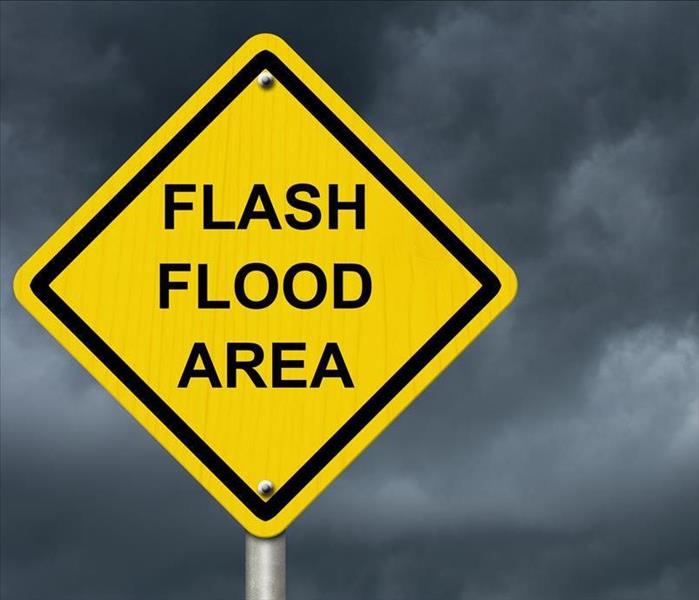 Consider these 11 Flood Safety Tips to be better prepared in case of a Flooding Situation.
Consider these 11 Flood Safety Tips to be better prepared in case of a Flooding Situation.
Flooding can cause serious property damage and create dangerous conditions for property owners and their families. These tips can help you improve your flood safety plan.
11 Flood Safety Tips for Homeowners
You may have limited time to take action when a flood event occurs. For that reason, it is important to have a safety plan in place before a flood happens. These 11 safety tips can help you create your plan:
1. Gather Emergency Supplies
Suggested items include flashlights, batteries, a weather radio, a first aid kit, a sealed plastic bag with necessary medications, pet food and enough non-perishable food and water for three days. Store a minimum of one gallon of water per person and pet for each day.
2. Listen to Weather Updates
Turn on a radio or television and pay attention to weather updates. If flooding seems imminent, prepare to evacuate.
3. Check Immunization Records
If you have a copy of your family's immunization records, store them in a flood proof bag or container. Check the date of everyone's most recent tetanus shot.
4. Secure Outdoor Possessions
Bring lawn furniture, trash cans, grills and other outdoor items inside or secure them to something that isn't likely to float away. You may want to cover securely anchored items that can't be moved with plastic to reduce the amount of damage from water.
5. Turn Off Utilities
If you will need to evacuate as a flood safety measure, switch off all utilities at the main breaker and close the main gas valve.
6. Move To Higher Ground
If you are in a low-lying area, move to higher ground. If you are in a vehicle, avoid driving through floodwater.
7. Avoid Floodwater
Do not return to your home until local authorities have told you it is safe. Do not use floodwater for drinking, bathing, washing dishes, brushing your teeth or preparing food.
8. Dry Out Your Home
Once you have been given the OK to return home, contact a flood remediation company in West Valley City, UT, to dry out your home. Do this as soon as possible. The longer your home remains wet, the more likely you are to have problems, such as rot or mold.
9. Be Aware of Boil Orders
Flood conditions can make tap water unsafe for drinking and bathing. Check the local news for announcements about boil orders. If there is a boil order, only use bottled, treated or boiled water for cooking, drinking or bathing.
10. Avoid Potentially Contaminated Food and Drink
Any food or drinks that may have been in contact with contaminated water should be thrown out. If you aren't sure, throw it out.
11. Avoid Carbon Monoxide Poisoning
If you run a generator or pressure washer, make sure it is a minimum of 20 feet away from windows, doors or vents. Don't run your vehicle inside an attached garage, even if the garage door is open.
Preventing damage to your property is important in a flooding situation, but flood safety is more important. It is better to sacrifice property than to risk your family.
The Content Cleaning Process for Your Flooded Company
2/17/2022 (Permalink)
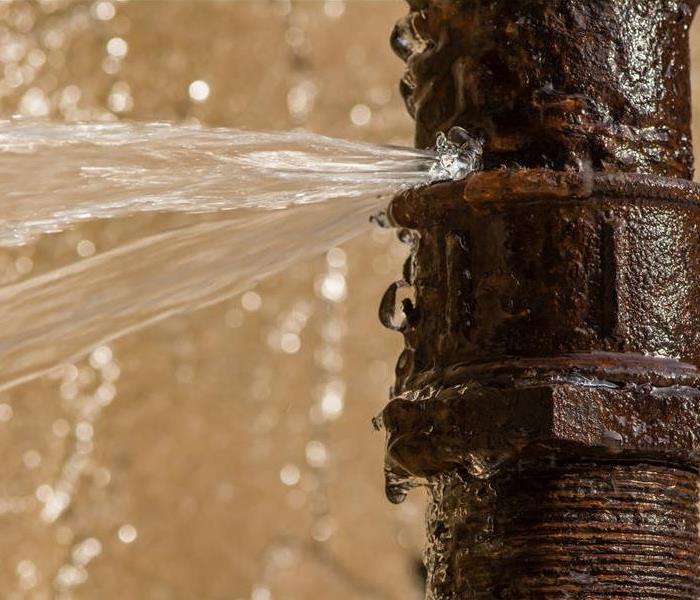 Knowing more about Content Cleaning Process can be very useful if you experience Water Damage in your property.
Knowing more about Content Cleaning Process can be very useful if you experience Water Damage in your property.
Water damage on your flooded company property in West Valley City, UT, requires a large amount of cleanup, and content care and restoration make up a big part of those efforts. A quick, thorough response is the best way to get back to your normal activities with limited interruption to business. Professional restoration teams provide this response in five steps:
- Inspection and assessment
- Water removal
- Thorough drying out
- Cleaning and sanitization
- Repairs and restoration
Although the specifics may vary from one part of the country to another, the broad steps are pretty standard. You can see how this process is carried out for the contents of your property.
Content Cleaning and Restoration for Your Flooded Company
One of the most important parts of the inspection step is ascertaining the level of contamination to your belongings. There are three types of water contaminations:
Category 1: Mostly clean and from a sanitary source
Category 2: Gray water with some contaminants, such as detergent
Category 3: Black water with hazardous contaminants, such as organic matter or chemicals
Once this assessment is complete, restoration professionals determine the best methods to dry, clean, and repair your possessions.
Water Removal Techniques
Water removal technicians use a variety of techniques. The methods used for removing excess water from carpets and other fabric furnishings are not the same as those used when handling electronics. The good news is that with proper handling many belongings can be cleaned and restored to their original condition.
It's important to understand that water and electricity is a dangerous combination that presents many safety hazards. In addition to making sure that the power to your property has been shut off, remove batteries from any items that have them.
Complete Drying of Contents
Thoroughly drying the contents in your flooded company property is much more complicated than simply removing surface water. Once your building has been prepared to control humidity, airflow, and temperature, technicians can get to work on the contents of your offices and other rooms. The many components in appliances, computers, and furnishings must be handled delicately and professionally. Waterlogged books and paper files may require freeze-drying, for instance.
Cleaning and Sanitization
Cleaning and sanitizing efforts include both wet and dry cleaning methods. Professionals use specialized sprays and foams, abrasives, and immersion baths to clean your belongings without causing further damage. Cleanup crews may apply antimicrobial, antibacterial, and other disinfectants to prevent contamination. Some belongings may also require treatment for odor removal.
Repairs and Restoration
Repairing the contents of your property is a more cost-effective method than replacing all of your belongings. As much as possible, professionals will save carpeting, appliances, and valuables. In some cases, contents will be moved to other locations for treatment while some of your belongings can be treated on-site.
It's important that each of these steps is carried out thoroughly and in order for efficient and thorough results. A single broken pipe can quickly pump many gallons of water into your property. The sooner professionals address the damage to your flooded company, the better you can avoid the most costly repairs.
Understanding Secondary Damage
2/14/2022 (Permalink)
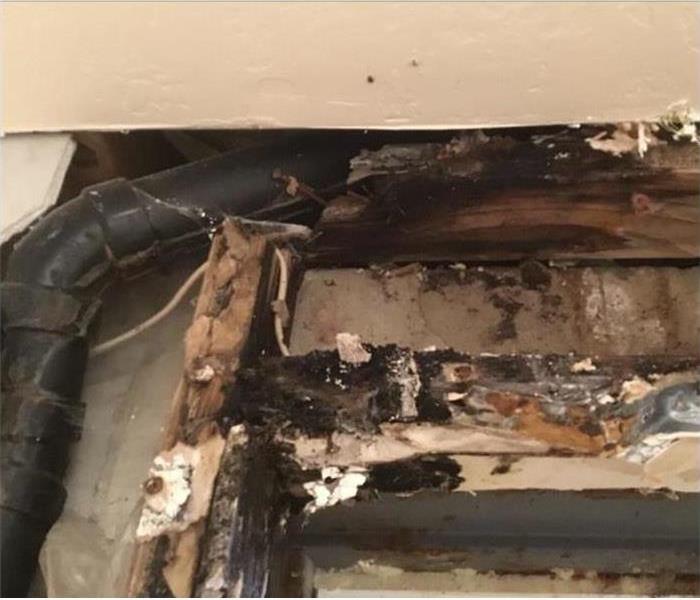 Important tips to understand Secondary Water Damage. If you have any doubt, please contact us.
Important tips to understand Secondary Water Damage. If you have any doubt, please contact us.
When you have a flood in your commercial building in West Valley City, UT, it is hard to know what the extent of the damage will be until you get a remediation team in there for an inspection. This crew can help you do the following:
• Assess the damage.
• Create a repair plan.
• Initiate cleanup.
As the professionals are assessing your damage, you may hear them talk about primary and secondary damage. Here is what you need to know about damage that is caused indirectly by the waters.
Secondary Water Damage
What It Doesn't Include
This secondary form of destruction can include a wide range of damage, but it does not include everything done to your building. The primary damage is anything done when the pipe burst or the roof leaked. For example, black mold growth was not caused directly by the flooding, but damaged walls and ceilings may have been.
How It's Formed
Because this type of damage only includes the harm done after the flooding has ceased, how is the damage done? Often slow reaction time, improper cleanup and hidden problems cause what the professionals consider to be nonprimary damage.
For example, black mold growth does not happen the instant a flood starts. Instead, it takes 24 to 48 hours to begin. High humidity may also be a secondary type of damage because it takes place when the water is allowed to sit for too long or is not completely removed from the building.
What It Does Include
Because it's caused by slow reactions, this damage can include mold growth, unsalvageable furnishings, water contamination and the spread of the flood. If a pipe bursts on the second floor, the water may start to travel to lower levels if it is not caught soon enough. The path of the water may be considered secondary or primary damage depending on what caused the travel.
Mold growth, including black mold, is often considered a type of secondary damage.
However, your commercial space could by affected by other types of secondary destruction if you do not properly address water issues right away.
Learn These Storm Tips Before the Clouds Gather
1/24/2022 (Permalink)
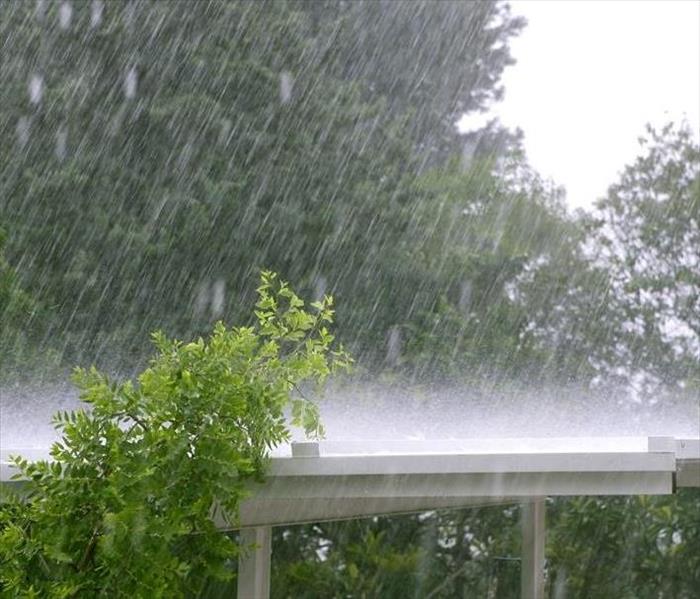 Consider these Storm Tips to reduce damage and stress in your West Valley City, UT house.
Consider these Storm Tips to reduce damage and stress in your West Valley City, UT house.
When you know how to respond after storm damage occurs, you can reduce the long-term consequences of that damage. With more preparation, you'll also increase your confidence during this stressful time, decrease the losses to your home and family, and reduce the amount of money it takes to recover. With the right storm tips, you can avoid many of the complications you'd otherwise face.
Storms Tips To Reduce Damage and Stress
As is generally the case, one of the best ways to avoid storm damage is taking preventative measures:
- Cleaning the gutters and downspouts
- Clearing the yard of debris, overgrowth, and dying branches
- Inspecting the roof and foundation at least once a year
- Putting away or securing yard furnishings and outside toys
After completing these tasks, it's also important to arrange a professional inspection of the roof, the foundation, and the structural integrity of your home. This inspection helps you identify small issues that could become much larger problems because of a storm. The following storm tips guide your actions once the weather clears:
Focus on Safety First
As you begin to assess the damage to your home and property, keep yourself, your family, and your pets safe from hazards such as downed power lines, floodwater, exposed wiring, and broken glass. If there's no power, use a battery-powered flashlight rather than candles or lighters. Be aware of the potential for gas leaks and sewer system problems.
Board Up and Tarp Openings
If you have broken windows or doors or holes in the roof, use plywood and tarps to keep your home secure and to keep out water. Be sure to document the damage and your emergency repairs to share with the insurance company and the adjuster. Any lack of response or permanent repairs could affect the insurance amount you receive for professional cleanup and reconstruction.
Record All Damage
If it's possible to move safely through your property, use a camera to document damage for your insurance claim. It's also important to schedule a professional damage assessment as soon as possible. The insurance company will take this information into consideration as they process your claim. (Before a storm hits, it's important that you understand what type of coverage you have and what you can expect after a storm.)
Contact Necessary Professionals
Your insurance agent is a great source of information and answers to your questions. The agent may also recommend other resources, such as a cleanup and restoration company, federal disaster assistance information, and emergency service providers and management agencies. You only have a 30-day window to file your claim, and there will be many homeowners working with the insurance company because of their own damage.
These storm tips can help you respond after heavy winds and rainfall hit your home. Extreme weather can occur at any time during the year, so make sure you know which actions to take before, during, and after the storm. Mitigation and reconstruction professionals in West Valley City, UT, can provide more information specific to this area. Don't wait for dark clouds before you learn how to protect your home and family.
What Can I Expect if My Building's Pipes Freeze?
1/13/2022 (Permalink)
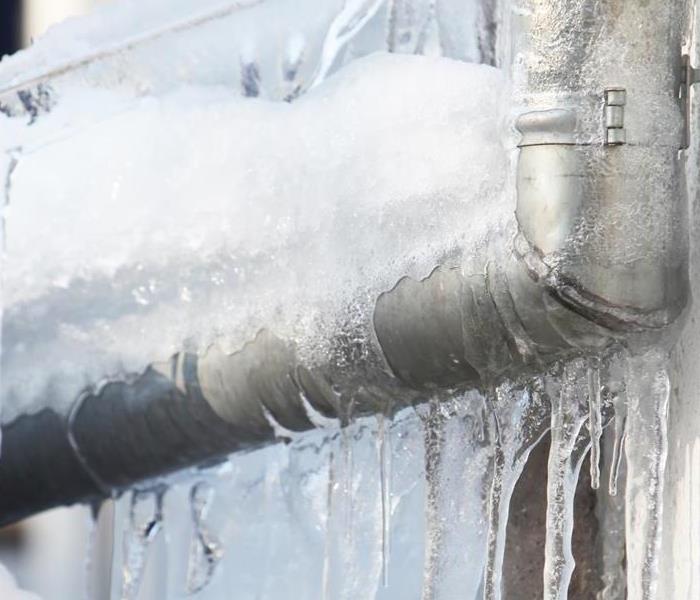 Consider these tips if you experience Frozen Pipes in your West Valley City, UT Commercial Building.
Consider these tips if you experience Frozen Pipes in your West Valley City, UT Commercial Building.
A water pipe burst in your commercial building could cause devastating effects. During the frigid winter months in West Valley City, UT you're more susceptible to broken pipes if you don't take the proper measures to protect them before winter sets in. This type of disaster could cause extreme water damage to your building's structure and contents, which ultimately could mean a halt in your business operations until the problem is resolved. The key is to prevent your pipes from breaking in the first place, but there are no guarantees something won't happen no matter how careful you are, and then you need to know what to do.
How To Safely Manage the Damage
It can be beneficial to know what to expect and what actions to take if a pipe does break.
1. Shut Off the Water
First, shut off the water main as soon as safely possible. Then, it's necessary to drain the water from the pipes. To empty them, turn on each faucet's cold water. You should also flush each toilet a couple of times.
2. Turn Off the Electricity and Remove Electronics
Next, before you do anything else, turn off the electricity. If you have any electronics or appliances in the area plugged in, it's also essential to unplug them. These measures can keep you safe and prevent electrical fires. If you can't safely perform this action, call an electrician.
3. Find and Inspect the Broken Pipe
Try to figure out which pipe is broken and determine the type of water damage incurred. A visit from a plumber will probably be necessary.
4. Document the Damage in Detail and Call for Help
It's critical to document the damage in as much detail as possible. It will provide evidence for your insurance adjuster. This documentation should include photos and notes. Videos can also help significantly.
5. Eliminate the Excess Water and Moisture
All standing water and excess moisture must be removed as quickly as possible. Unless it's a very minor situation, you will need to hire water cleanup and restoration professionals. They have the industrial equipment and expertise to handle the job safely and efficiently. They can also repair the damage and perform a thorough inspection upon completion.
6. Remove the Affected Contents
You will also need to remove damp and wet items, such as furniture and paper. Soaked materials like carpet won't be salvageable, as it won't be possible to completely dry them quickly enough.
7. Dry the Area
The affected area must be dried as soon as possible. The longer water is left to sit, the more damage will be incurred. Mold growth can begin in the first 24 hours after the water intrusion. If mold takes hold, the cleanup process could be significantly more challenging. You can dry the area using dehumidifiers, heaters and fans. You can also open the windows to allow fresh air to circulate.
Broken pipes can cause disastrous results in a building. The water damage can be significant, leading to ruined contents and even structural issues. Hopefully, you'll never have to, but it's helpful to know beforehand how to deal with a pipe burst if you experience this situation in the future.
What Should I Do If I Smell Natural Gas?
1/5/2022 (Permalink)
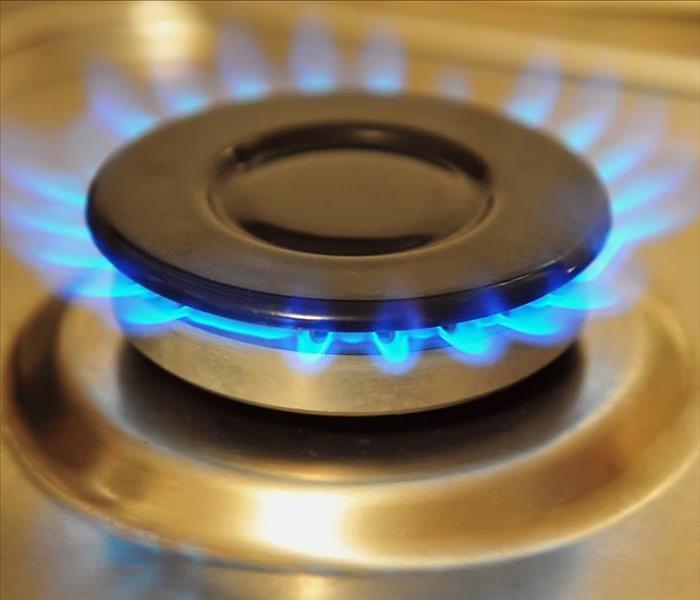 If you suspect a Natural Gas Leak in your West Valley City, UT house, follow these tips and do not hesitate to contact us.
If you suspect a Natural Gas Leak in your West Valley City, UT house, follow these tips and do not hesitate to contact us.
A natural gas leak can result in a gas fire or explosion. If you have natural gas service to your home, it is important to know what to do if you suspect a leak.
Steps To Take If You Suspect a Natural Gas Leak
When everything is working properly, you probably don't think about your natural gas service very much. However, a gas explosion caused by a leak can be a safety hazard and cause substantial property damage. Take steps immediately if you suspect a gas leak.
1. Check Your Stove
If you are noticing a gas smell in your kitchen, check your stove to make sure the burners are all turned off. It can be easy to accidentally turn a burner on when reaching for something in a cabinet or walking by the stove.
2. Don't Switch Any Lights on
If you have ever turned on a light switch in a dark room, you have probably seen sparks. Those sparks can ignite any gas that is in the air and cause an explosion. If you need to investigate a leak in the dark, use a flashlight instead.
3. Avoid Open Flames
If you are in a dark room, you might be tempted to use a cigarette lighter or light a candle to see by without thinking about it. Never introduce an open flame to an area that may have a gas leak. This may cause a gas fire or explosion.
4. Open Windows and Doors
Ventilation will help you disperse any gas that is in the air. Open windows and doors and leave them open until the problem is resolved.
5. Locate Your Gas Meter
Before you have a problem, take the time to locate the gas meter outside your home and learn how to shut it off. If you smell gas, you can use a wrench to shut off the gas at the meter. If you have trouble finding your meter, contact your gas company in West Valley City, UT.
6. Know When To Evacuate
If the source of the gas leak isn't something obvious that you can easily stop, such as a burner that is turned on, evacuate all people and pets in your home and go to a safe place, such as a neighbor's house across the street. Call 911 to report the emergency.
7. Keep Emergency Contacts on Hand
Save the phone numbers for your utility company, fire department, insurance company and a fire remediation company in your cell phone or another easily accessible place. If a fire occurs or the leak takes some time to resolve, you may not be able to reenter your home for some time. If you have this information on hand, you can begin making arrangements immediately.
A natural gas smell might be something as simple as a burner you need to turn off on the stove, or it could be a dangerous situation that could result in a gas fire or explosion. You may not have much time to act when you notice a leak, so having a plan in place before a problem occurs is important.
How to Keep Commercial Pipes From Freezing
12/8/2021 (Permalink)
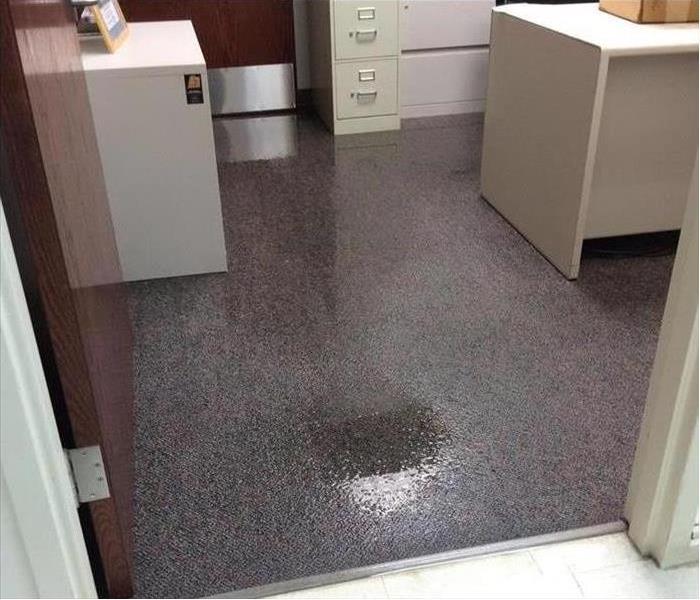 This West Valley City, UT office suffered water damage.
This West Valley City, UT office suffered water damage.
Living in a colder climate can present your commercial business with several unique challenges. Frozen pipes at home can be a hassle, but freezing issues associated with a business can be devastating. Since water expands when it freezes, pipes may burst, leading to the need for major water line repair.
Protecting Your Pipes
Exposed pipes are very susceptible to wintry weather. If you live in a colder climate or are expecting subzero temperatures, you need to winterize your pipes. Exposed pipes may be located in a variety of areas:
- Basement
- Attic
- Crawl spaces
- Outdoors
At the very least, they need to be insulated. Heat cables or heat tape is another popular option for protecting against frozen pipes. These cables radiate a small amount of heat and are powered by electricity. When used properly, they can keep water flowing. Some can even be controlled by a thermostat. In some situations, you might want to combine insulation with heat cables.
Shut off any outside water sources that you don't need, especially if you are expecting particularly low temperatures. When a building is left unattended, make sure the thermostat is set no lower than 55 degrees Fahrenheit.
Dealing With Emergencies
Even if you take all the necessary precautions, you should still be prepared in case of an emergency. This may include a backup water supply depending on your business needs. Make sure you and your employees know where the main shutoff valve is located. Educate yourself on minor plumbing repairs. You may be able to temporarily patch a hole and prevent further water damage. If you are dealing with frozen pipes in West Valley City, UT, call a professional as soon as possible.
Freezing conditions can wreak havoc on exposed plumbing. Take precautions and be prepared for any unfortunate emergencies. Train your staff to know what to look for, what to do, and who to call should a disaster occur.
Regular Duct Cleaning for Your Home
11/29/2021 (Permalink)
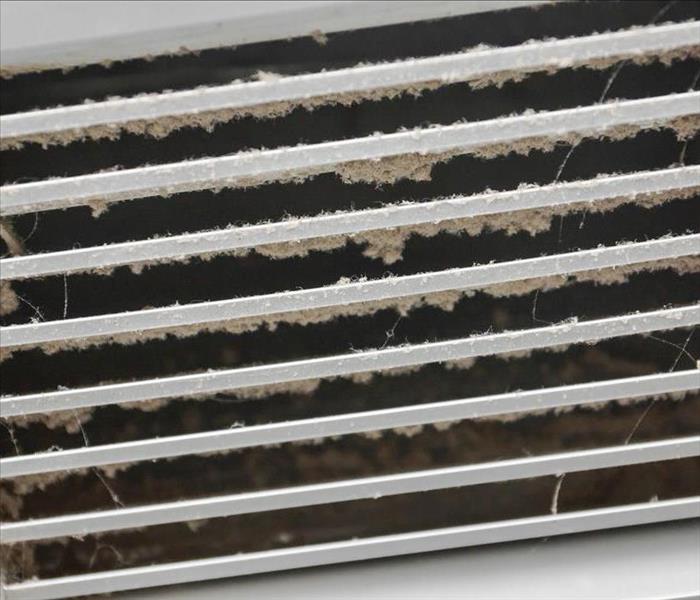 Keep air ducts clean to prevent the spread of mold in your West Valley City, UT home.
Keep air ducts clean to prevent the spread of mold in your West Valley City, UT home.
If you've never taken a look at the air ducts and vents in your West Valley City, UT, home before, there's a very good chance that you won't like what you find. A lot of air moves through the ducts, and it may carry dirt, germs, insects, dust, and other contaminants. During seasons of humidity, moisture also gets into the ducts, increasing the risk of mold growth. Routine duct cleaning is important for many reasons. Make an appointment if you've noticed:
- Visible mold growth
- Evidence of rodents or insects
- Reduction of airflow through vents
- Musty smell from the vents
Don't wait for serious trouble before getting your dirty ducts cleaned. Prevention is a simple but sure home care solution.
4 Benefits of Regular Commercial Duct Cleaning
The air ducts draw air into your property and then circulate through all the rooms of the home. This means that any dust, dirt, mold, insects, and mites in the vents are also circulating through the air. Professional duct cleaning is a good way to improve air quality.
1. Get Rid of Insects and Pollutants
In one year, about 40 pounds of dust build up in an average home. That buildup contains dust mites and chemicals which can be hard on the welfare of the building. Commercial cleaning crews use powerful vacuums to remove and contain dust, mites, and other debris from the vents and the rest of the ventilation system.
2. Improve Indoor Air Quality
Many things impact the comfort and indoor environment of your home. These factors include inconsistent temperature, low air circulation, and clogged ventilation systems. You may have noticed that it's harder to keep up with dust removal; this is an indication that the air quality in your home has been impacted by dirty ducts.
3. Increase HVAC Efficiency
As ventilation ducts become full of dust and dirt, the path of heated and cooled air becomes smaller, decreasing the efficiency of the entire HVAC system. With that buildup removed, more air passes through the system and the HVAC equipment doesn't have to work as hard. Clean, open ducts make it easier for you to maintain a consistently comfortable temperature throughout your home.
4. Save Money on Monthly Bills and Equipment Upkeep
As property owners consider any financial investment in maintenance and upkeep, it's important they understand the value of those tasks. Keeping the ducts and vents clean results in savings on monthly utility bills and reduced repair and replacement costs. According to the U.S. Department of Energy, proper HVAC system maintenance substantially reduces the percent of wasted energy in the home.
Schedule an Appointment Today
Many industry experts recommend having the ducts cleaned every three to five years. Depending on the traffic through and the immediate environment surrounding your home, you may want to increase the frequency of commercial cleaning. When you decide to schedule commercial duct cleaning, be sure to choose a cleaning company that is dependable and reputable. The well-trained technicians at West Valley City, UT, SERVPRO are Here to Help and are ready to provide the high-quality results you expect. There's no reason to delay your improved comfort and the financial savings of professional duct and ventilation cleaning.
My Basement Is Flooded! How Do I Remove the Water?
11/19/2021 (Permalink)
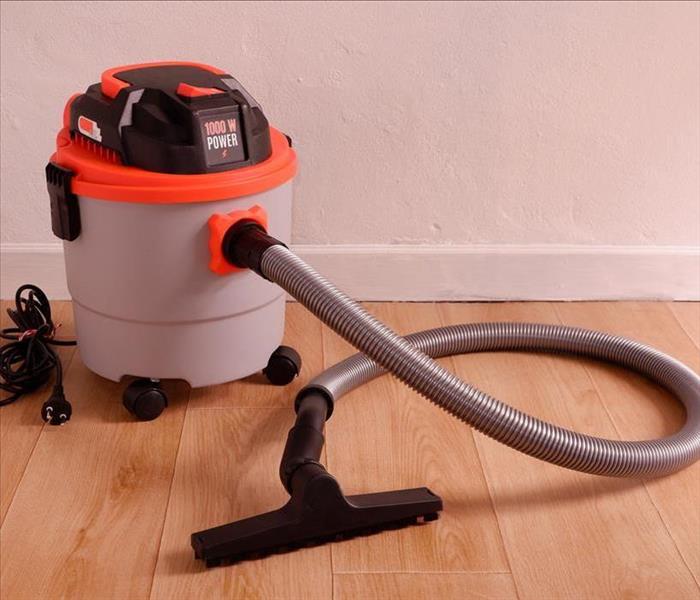 Take some preventive steps to avoid a basement flood in your West Valley City, UT, home.
Take some preventive steps to avoid a basement flood in your West Valley City, UT, home.
When you discover a basement flood in your West Valley City, UT, home, you are likely to have a range of emotions such as surprise, panic, and dread, and for good reason. The severity of water damage increases with every second, so it's essential to extract all the water as quickly as possible. It can also be hazardous, producing a risk of electrocution and creating a haven for mold growth.
First and foremost, shut the power off to the flooded area before anyone enters. If you can't safely navigate to the circuit breaker, call an electrician or the power company to turn it off. Also, stop the water at the source, if possible (e.g., from a burst pipe). If it originated from a hazardous source, such as a sewer backup, it is definitely time to call flood damage restoration professionals. They have the professional equipment and expertise to complete the remediation job safely thoroughly.
6 Methods for Eliminating Floodwater From a Basement
1. Sump Pump
A sump pump can give you some peace of mind during those heavy rainstorms. It'll help you avoid having to manually remove water from the area. It will also keep your home and its contents safer from water damage when you're at home and when you're away. Getting a sump pump installed in your home can provide a discount on your homeowners insurance coverage. If you already have one, make a point to test it and maintain it regularly so that it's there for you when you need it.
2. Wet/Dry Vacuum
A wet/dry vacuum provides perhaps the safest and most efficient way to extract water if you're doing it yourself. It's a great tool to have on hand for a quick cleanup. You can get wet/dry vacuums that hold various capacities of water. You'll just have to empty it when it gets full and then go back to work.
3. Buckets
Scoop up the standing water with flexible plastic buckets. One gallon of water weighs seven pounds, so this can be a very strenuous job. It's also not very efficient, but it's better than nothing.
4. Floor Squeegee or Push Broom
When you're dealing with a basement flood, after you've removed the majority of the water, you can push the rest of the standing water out the closest exterior door. A floor squeegee or push broom works well for this.
5. Mop and Towels
A mop will soak up residual water from a hard floor. Towels are good for absorbing any remaining puddles.
6. Air
Once all the standing water is removed, ventilate the area as much as possible. If the outdoor air is less humid than the indoor air, open windows and doors. Run fans and heat to remove the indoor humidity. Dehumidifiers are also very beneficial. Just remember to empty the water receptacle before it gets full.
If you have to deal with a basement flood once, you'll probably be motivated to avoid one at all costs in the future. Remember these tips so you can be prepared for a future disaster as much as you can.
Understanding Mycotoxins and the Importance of Professional Assistance
11/10/2021 (Permalink)
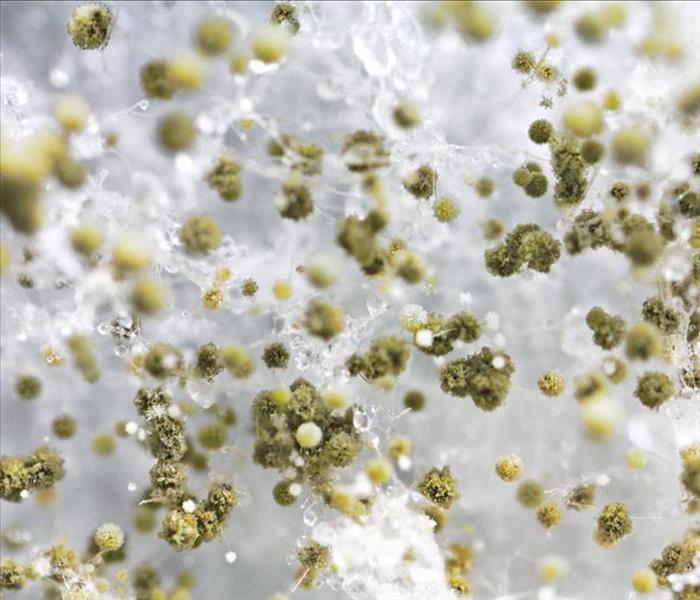 Contact a mold removal company if you detect mold in your West Valley City, UT commercial building.
Contact a mold removal company if you detect mold in your West Valley City, UT commercial building.
4 Questions to Understand the Importance of Removing Mold
Mold is known not only by its physical appearance but also by its smell. Commonly described as a musty odor, the odor is off-putting and should cause concern for business owners. The scent is a sign of mycotoxin, which indicates mold is spreading. Suppose you start to notice a strong smell in your facility. In that case, it is best to contact a mold remediation specialist in West Valley City, UT, to address the issue quickly and without the need for significant business interruption. The process for mold removal will include:
- Identification of the species
- Sealing of the affected area
- Thorough removal
- Cleaning and disinfecting
- Restoration
What Is Mycotoxin and Why Is Remediation Encouraged?
Mycotoxins are some of the primary gases produced during the spread and reproduction phase of various mold species. While not all microbial volatile organic compounds result in the production of odors, this particular gas does. The musty smell of mold, then, is a sign the mold is developing and can become problematic.
Where Does Mold Grow?
Mold requires specific conditions to grow and thrive: dampness, warmth, and humidity. Most commercial facilities will have at least one area prone to these characteristics, such as basements, kitchens, laundry facilities, etc.
To prevent mold growth, you might want to identify vulnerable areas in your facility and take preventative action. Mold prevention can be as simple as installing a dehumidifier or exhaust fan or as complex as reassessing HVAC and insulation protocols.
A good start for a commercial building is to assess the moisture and humidity levels in the facility. The humidity level in any building should never be more than 50%.
Why Is it Necessary To Hire a Professional Remediation Service?
Mold is a potential concern for inventory, building structure, and employee safety. While many business owners might seek possible DIY solutions, it is often best to hire a professional. Professionals understand government regulations regarding the disposal of potentially hazardous materials, and they have the necessary training to handle the materials. Additionally, commercial insurance policies might require professional mold removal to maintain a policy.
In some instances, the local government might also require professional removal. For example, if toxic black mold is identified in the facility, many municipalities require licensed removal specialists.
What Does Mold Removal Entail?
Depending on the severity of the problem, mold removal can be a complex process. A remediation professional will first test the facility to locate the infestation and identify the species of mold. The result of those tests will help determine the rest of the mold removal process.
If a toxic species, the specialists will seal off the affected area, ensuring the rest of the facility is protected against further spread. They will tape off vents, windows, and doorways. They will also dampen the moldy sections of walls to minimize the spread of spores before removing them. Once the mold is removed from the facility, the remediation team will clean and disinfect the space before restoring it to pre-disaster conditions.
Mycotoxin is the primary MVOC in mold, causing a musty smell. If you notice the odor in your facility, it is a sign that you need to contact a mold removal company.
How To Safely Extinguish a Grease Fire
10/14/2021 (Permalink)
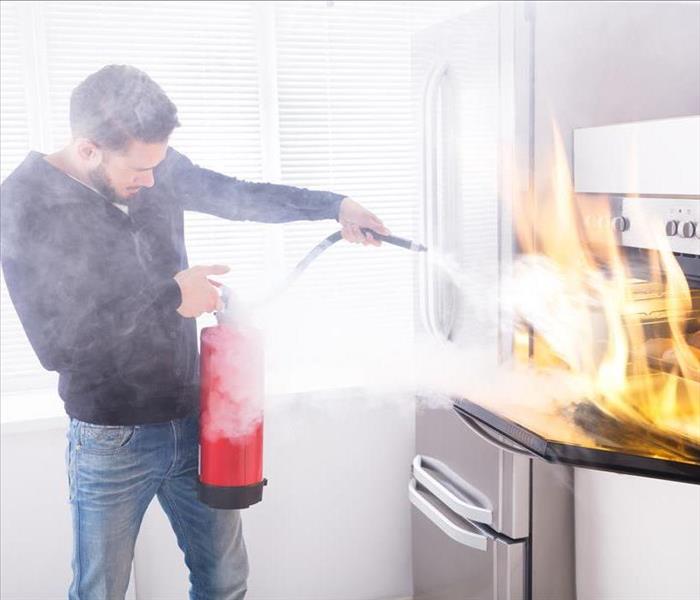 The most common fires in West Valley City, UT homes are grease fires.
The most common fires in West Valley City, UT homes are grease fires.
The grease fire is one of the most common causes of fire and smoke damage in West Valley City, UT, homes, and kitchens. There are a couple of ways that grease-fueled fires get started: leave hot oil on the stovetop unattended and heating oil beyond its recommended temperature. These fires may also start if the heated grease overflows the pot or pan.
How To Respond to a Grease Fire
Your first step in avoiding a kitchen fire is to remain in the kitchen at all times when you have oil or grease on the stovetop. This precaution is appropriate when you're cooking any type of meat, such as bacon or hamburger, that releases juices. Another great tip for avoiding kitchen fires is keeping the stovetop and oven clean and free of crumbs, animal fats, and other foods. Keep flammable items, such as hot pads, towels, and cookbooks away from sources of heat; instead, keep the pan lid, a fire extinguisher, and baking soda or salt within reach.
Common Mistakes To Avoid
You can't handle a grease fire the same way you approach other types of fire. In fact, some of the first things you would do to put out other types of fire can increase the risk of harm and damage when dealing with grease. Here are some tips about common mistakes:
- Never throw water on grease, oil, or fat-caused fires. Adding water to an already dangerous fire will dramatically increase the danger and cause flames and oil to splatter.
- Do not move the pot. Too often, this movement causes the burning oil to splash and the fire to spread.
- Don't use towels or other flammable materials to smother the fire. You may have a damp cloth or a towel handy, but these materials will cause the fire to spread.
- Don't use flour or sugar on the flames. Baking soda and salt are the only baking products you can safely use to put out the fire.
With the "do not" list out of the way, it's time to focus on the things you can do to quickly extinguish the fire.
Safe Ways To Put Out the Fire
- In a best-case scenario, you will be on hand to recognize that your heated oil is starting to smoke. At the first sign of trouble, turn off the heat to your pot or pan. This may be enough to prevent flames and spitting.
- If you have your metal lid close by, you can use it to cover the pot. The lack of oxygen will put out the fire.
- A #10 can, such as a large coffee can, full of baking soda or salt can be used to smother grease-fueled fires. Bear in mind that it takes a lot of soda or salt to put out the flames.
- Use a fire extinguisher if you can't get close enough to use one of these tactics, a fire extinguisher is another good option. You should have a Class B dry chemical fire extinguisher on hand. The wrong extinguisher, such as a water-based Class A, can make the fire worse.
A grease fire can be very dangerous. Use these tips to avoid damage, and then turn fire cleanup over to trained fire damage cleanup professionals.
Important Facts To Know About Sewage Cleanup
10/6/2021 (Permalink)
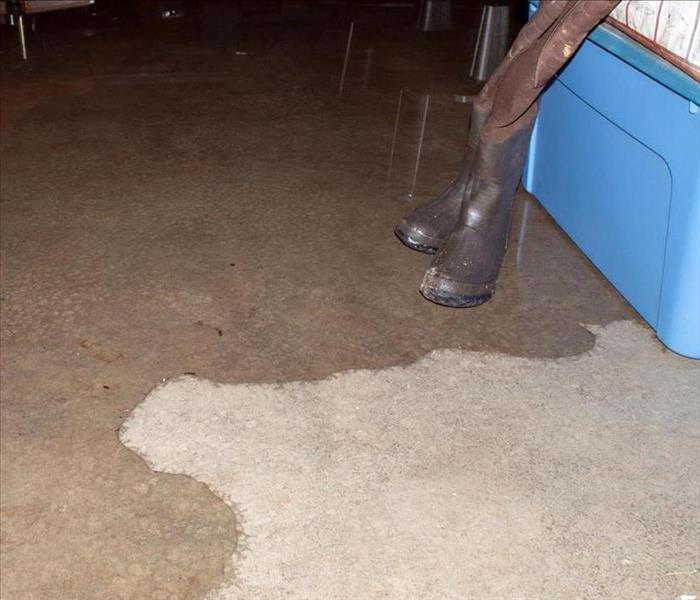 Protect yourself to clean sewage in your West Valley City, UT, building.
Protect yourself to clean sewage in your West Valley City, UT, building.
When you have raw sewage infiltrate your West Valley City, UT, commercial building, you can't treat it like an ordinary flood. Various situations can cause a sewage problem, such as a flooded toilet, clogged lines, or damage from tree roots. Whatever the cause, from start to finish, there are precautions that you need to take during the sewage cleanup to protect everyone involved as well as the building and contents.
How To Safely Clean After a Sewer Backup
1. Prioritize Safety
Block off the area so no one can enter, aside from people cleaning the room. Children, people with medical issues, and pets should stay out. Also, before anyone goes into the area, make sure that there are no electronics or appliances in the standing water, as an electric current could be flowing through the water. This issue can also occur when electrical outlets are exposed to the water. Turn off the building's power before stepping into the area.
2. Wear Personal Protective Equipment
Before going into the affected area, wear PPE to protect yourself from the contaminants. Safety goggles, a face mask, rubber gloves, and boots are musts. Water-resistant coveralls are also recommended.
3. Create a Barrier
Close off the contaminated area from the rest of the building. Blocking off the room can reduce the chance of cross-contamination of debris and airborne particles, and it works as a barrier to keep everyone out.
4. Extract Standing Water
Once you've identified the problem and stopped it, it's essential to remove all of the standing water. The safest and most efficient way of doing this is by using a wet/dry vacuum.
5. Remove Contaminated Materials
Remove all contaminated materials that can be removed from the area. During sewage cleanup, you must bag anything that isn't salvageable for the trash and dispose of it immediately. Items that can be adequately cleaned and sanitized should be sealed in bags and placed outside to handle later.
6. Remove Debris
After the area is clear of obstacles, it's time to clear the area of as much contaminated material as possible. You will probably have debris and could even have sludge. This material should be removed with a shovel, placed in heavy-duty plastic trash bags, and then immediately disposed of. If the flooring is soaked, you'll need to remove it, particularly if it's carpet. Wet areas of drywall will also need to be removed and thrown away.
7. Clean and Disinfect Everything
Clean and disinfect every affected surface. This washing is imperative to avoid serious issues, such as cross-contamination and mold growth. To ensure the job is performed safely and correctly, it's best to hire water damage, remediation professionals.
8. Dry Everything
Dry everything as quickly as possible to prevent mold growth. Mold can begin growing in as little as 24 hours, so it's critical to dry the area and contents thoroughly. You can use fans, dehumidifiers, and heat.
When you've had a sewer backup, taking specific steps in the raw sewage cleanup process is vital. By being thorough with this job, you'll protect not only your employees but also your building and its contents.
Which Commercial Cleaning Services Does SERVPRO Offer?
9/23/2021 (Permalink)
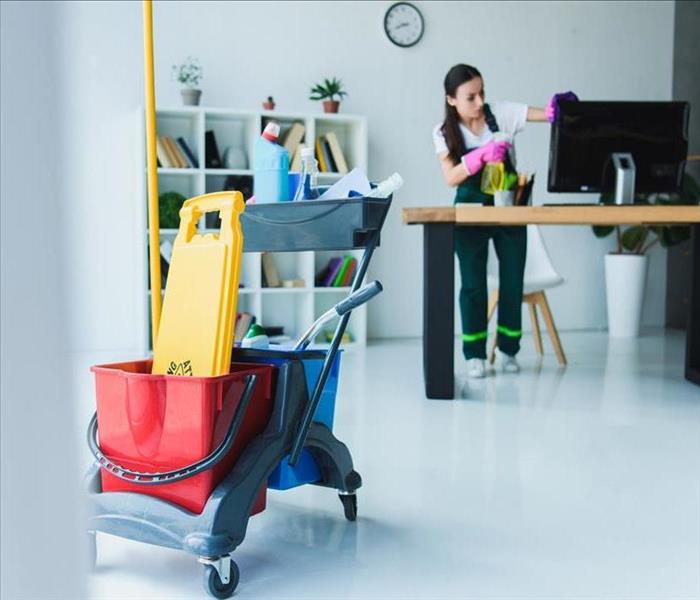 SERVPRO has a professional and qualified team to give the customer the best service.
SERVPRO has a professional and qualified team to give the customer the best service.
First impressions are important for any business. Whether you have property damage or normal wear and tear commercial cleaning can be critical for restoring your business's appearance. SERVPRO franchises offer a variety of services that can make it “Like it never even happened.”
Services Offered by SERVPRO
SERVPRO offers a variety of cleaning services to meet the needs of businesses. With over 40 years in the business, award-winning training, and more than 100 exclusive cleaning products, we have the skill and expertise to provide cleaning services to many types of businesses:
- Education facilities
- Retail facilities
- Healthcare facilities
- Foodservice facilities
- Property management
- Hospitality facilities
Certified: SERVPRO Cleaned
The CDC recommends that businesses clean high-touch surfaces, such as doorknobs, keyboards, and workstations to help prevent the spread of COVID-19. SERVPRO's certified clean service is a defensive cleaning program designed to make it easier for businesses to operate safely during the COVID-19 pandemic. This viral pathogen-cleaning program goes beyond what your regular janitorial staff can do and is based on our Consult, Clean, and Certify model.
Our professionals start by discovering the unique needs of your space. They then perform an expert deep clean using our proprietary EPA-approved, hospital-grade cleaning solutions. All cleaning plans are tailored to your needs and conform to CDC standards. Finally, we provide a window shield and digital emblems so that your customers in West Valley City, UT, know that your business is Certified: SERVPRO Cleaned.
Commercial Building Restoration Services
The SERVPRO team is an expert at providing restoration services for water and fire damage. Our franchises are available to you 24 hours a day to get your business operational as soon as possible. As part of this service, we can restore electronics, dry documents, and provide mold remediation services. Additionally, we can remove smoke damage and odors, provide storm cleanup services and assist with disaster recovery.
Commercial Building Cleaning Services
Whether you need odor removal, carpet cleaning, or deep cleaning of your flooring, our commercial cleaning service can help. Our professionals work hard to complete the job correctly the first time and respond quickly to make sure your business looks its best. We offer both office and industrial cleaning services.
Specialty Cleaning Services
In addition to our standard cleaning services, we offer a range of services to address the specific needs of various industries. Our professionals can clean restaurant hoods, remove biohazard contaminants, and clean air ducts and HVAC units. We can also deep clean upholstery and carpets, floors, ceilings, and walls, restore documents, remove odors, and clean drapes and blinds. Additionally, we can safely clean sewage spills, perform trauma and crime scene cleanup and deal with vandalism.
With more than 1,700 national franchises, SERVPRO is uniquely positioned to meet your commercial cleaning needs. Our professionals are ready to serve you 24 hours a day and seven days a week. We are a preferred vendor for many local and national insurance companies. Whether you need to ensure your space is safe during the pandemic or restore it after a disaster, SERVPRO is ready to make it “Like it never even happened.”
Pipe Burst? Don't Panic! Plan Your Response
9/15/2021 (Permalink)
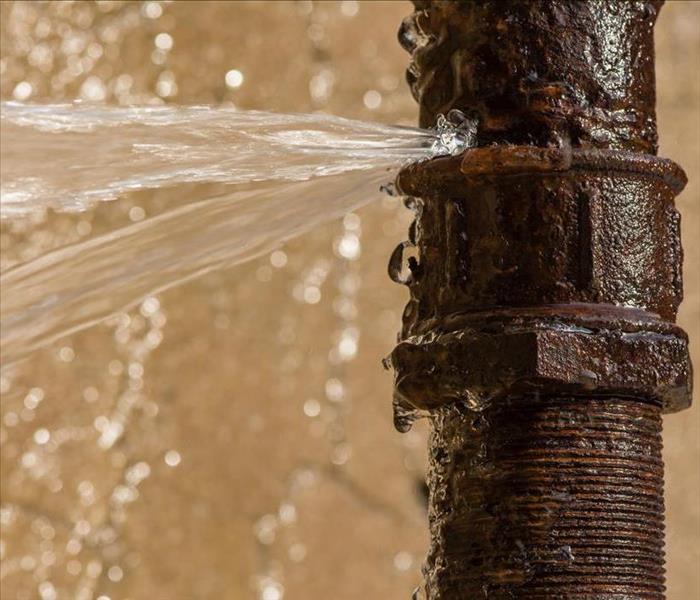 A pipe burst is the cause of water damage and leads to other severe damages.
A pipe burst is the cause of water damage and leads to other severe damages.
When dealing with a pipe burst, it's crucial that you take immediate action to prevent lasting water damage. Each minute that you delay increases the risk of extensive and costly damage, as well as disruption to your daily life.
Your Response to a Pipe Burst Situation
Prevent Bursting Pipes
Of course, prevention is the best course of action. When you know how to avoid the most common causes of the situation, you can significantly reduce the probability of flooding. Watch out for the following signs of trouble, especially along with your West Valley City, UT, home's main water line:
- Aging pipes may become cracked and weakened over time. Depending on the materials used to build the home, pipes may last between 20 and 50 years. Even if the rest of your home appears to be in good condition, if it was built in the 1970s or earlier, the pipes need to be replaced.
- Clogs from food, waste, and dirt create pressure along the pipeline.
- Corrosion can be recognized through visual inspections, a change of water pressure, or changes in the smell and color of the water coming through the pipes.
- Freezing temperatures affect pipes that run along exterior walls. As the water inside freezes or the metal pipes reach the freezing point, clogs or hot water can cause a burst.
Recognize a Water Leak
Sometimes, there's a clear gush of water that you can't miss, but at other times a cracked pipe happens out of sight. When this is the case, it's important to recognize signs of trouble at a hidden spot along the waterline. These include an unexplained increase in your water bill, increased sounds of water such as drips or running water behind the walls, puddles in the home, or signs of moisture on the ceilings or walls.
Turn Off the Water
As soon as you recognize a leak or pipe burst, shut off the water. If you aren't sure where the water is coming from, turn off the main valve. This may be in the basement, under the kitchen sink, or somewhere along the exterior of the home.
Disconnect the Electricity
Water and electricity are a dangerous combination. Shut off power to your home before coming into contact with any leaking water or moisture.
Drain the Pipes
With the water and power turned off, open the cold-water faucets throughout your home, flush the toilets, and open the hot-water lines to drain the pipes.
Repair the Broken Pipe
It may be possible for you to complete the necessary repair to a cracked pipe, but in some situations, a professional response may be required. The same is true when it comes to cleaning up and repairing areas damaged because of the water. Professional property cleaners do more than address visible damage; they also assess for hidden areas of moisture, the possibility of mold, and other vulnerable points along the water pipes.
Your first response to water gushing from a pipe may be a moment of panic, but when you have a plan in place, you're prepared to minimize the chaos. Protecting your West Valley City, UT, home from water damage begins long before you face the risk of a pipe burst.
How To Keep Your Employees Safe During Mold Remediation
9/7/2021 (Permalink)
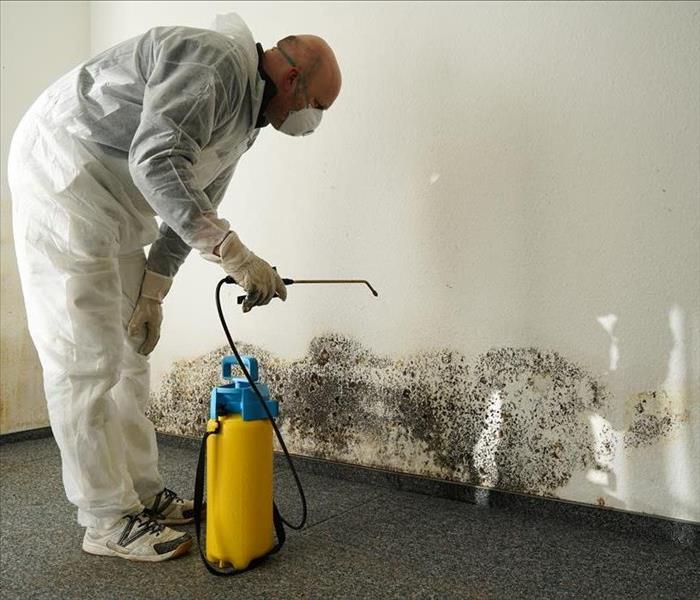 If mold appears in your West Valley City, UT business, hire a professional team to remediate the damage immediately.
If mold appears in your West Valley City, UT business, hire a professional team to remediate the damage immediately.
If you've noticed mold growth in your West Valley City, UT, commercial building, it's essential to take immediate action. The spores can spread quickly, and you can find mold running rampant throughout the building faster than you realize. If you leave it untreated, it can be harmful to humans, animals, and even the structure of your facility and building contents. It's your responsibility as the company owner or manager to keep your employees safe.
Therefore, it's helpful to know beforehand some of the safety procedures used to ensure a safe work environment for everyone, whether you're performing the mold removal job yourself or hiring a restoration company. In the meantime, keep mold growth at bay by regularly investigating for and repairing leaks and drying condensation. Control the relative humidity indoors and ensure proper drainage around the foundation. Also, maintain your building's HVAC system.
Continue Business While Ensuring Your Employees' Safety
1. Allow Employees To Work Remotely
Immediately upon discovering mold in your building, the ideal thing to do with your employees is to move them to an area that you're sure is unaffected, or ideally, out of the building entirely. If possible, allow them to work remotely from home or another location. In the case of a severe mold problem, your business insurance may pay for a temporary work location for your employees to set up base until remediation is complete. After all, a severe mold problem can take weeks or even months to remedy.
2. Place Containment Barriers
Professionals use containment barriers to keep mold and mold spores contained in the affected area where the cleanup occurs. Typically, sheets of heavy plastic are hung around the perimeter of the room and sealed on all sides to prevent mold spores from migrating to unaffected areas of the building. Air vents and door gaps in the area will also be covered and sealed.
3. Wear Personal Protective Equipment
The team of mold remediation professionals will wear personal protective equipment for two reasons: to ensure their individual safety and to prevent cross-contamination into untouched areas. If your employees must stay in the building during the restoration process, they should wear some PPE (respirators, at minimum) if they're at risk of mold exposure. Depending on the scale of the damage and the extent of the mold removal process, this PPE must include some or all of the following: hair covers, protective eyewear (e.g., goggles or safety glasses), face masks, or respirators, gloves, coveralls, and shoe covers.
4. Install HEPA Filters
High-efficiency particulate air filters are designed to remove at least 99.97% of airborne particles, including mold, pollen, dust, and bacteria. These HEPA filters can be placed on HVAC system air vents, vacuums, and portable air purifiers. It's beneficial to have these filters installed around your building, especially during mold remediation. Place some HEPA air purifiers around the office to ensure better air quality at all times.
The mold removal process can be time-consuming and intensive, but it has to be completed thoroughly and effectively to prevent further spread throughout the building. Whether the contamination is black mold or a less severe type, it's critical to begin remediation immediately.
Things To Throw Away After a House Fire
8/19/2021 (Permalink)
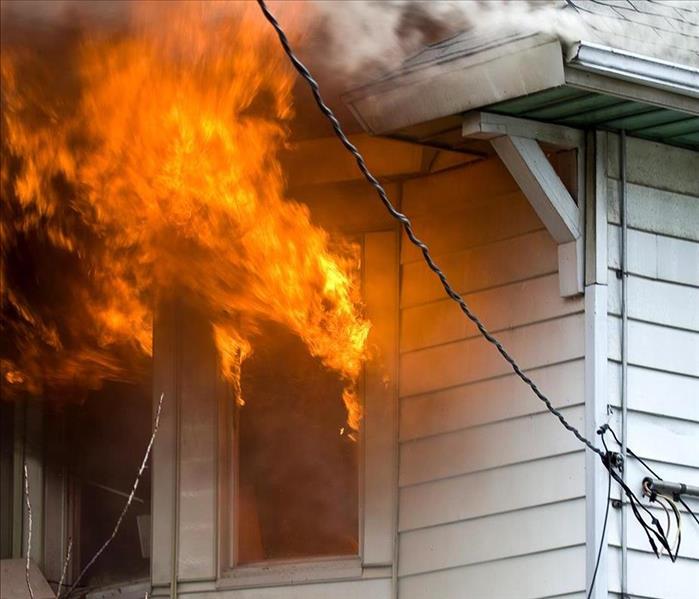 After a home fire in West Valley City, UT, some items must be thrown away because of the damage.
After a home fire in West Valley City, UT, some items must be thrown away because of the damage.
A house fire can be devastating emotionally, physically, and financially. The tough decisions you need to make during recovery from the fire can be especially hard as you sort through belongings trying to decide what can be salvaged and what you must throw away. Whether you're struggling to get rid of items for sentimental reasons or because you're worried about finances, there are some items that must be tossed without question.
Perishable and Non-Perishable Food Items
Naturally, any food exposed to flames or smoke should be tossed immediately. Food stored in thin plastic, cardboard boxes, or cloth should also be thrown out. Perishable foods should be thrown away if:
- They sat at room temperature.
- The refrigerator lost power.
- The inside of the fridge smells like smoke or has a weird smell.
- Items in the fridge or freezer don't feel cold.
Consider getting rid of canned food because the high temperatures that accompany the fire can trigger bacterial growth even in sealed containers. If cans are bulging or have changed shape, the food inside isn't safe to eat. Anything that is covered in fire extinguisher dust should also be thrown out.
Medications
During and after the fire, flames, smoke, soot, water, and fire extinguishing chemicals have all affected the items in your home. Any of your medications could have been affected, and you may not see physical evidence of this contamination. Additionally, the high heat in the home can affect the potency of the drugs. According to the Federal Drug Administration, before tossing medicine into the dumpster, take it out of its container, mix it with something undesirable (such as dirt or cat litter), and seal it in a plastic bag.
Makeup, Cosmetics, and Toiletries
The same high temperatures that negatively affect your medications can also damage your makeup. The various chemicals in all the cosmetics and toiletries in your home could be impacted by those high temperatures, as well as by the water and extinguishing chemicals used to put out the fire. Even if you don't see visible signs of damage, get rid of and replace these items.
Clothes and Other Textiles
These may be some of the most difficult items to throw out. It's natural to want to save as much money as possible after experiencing fire damage, but clothing, bedding, towels, and other textiles could absorb contaminants that are irritating. It is also very difficult to get rid of the smoke and chemical smells that linger after a home fire.
Your well-being should be one of your top priorities after a fire in your West Valley City, UT, home. Although it is difficult to get rid of items that don't look damaged, it's better to protect your safety and that of your family members. This means tossing the items in these four categories and replacing them when you're able.
In addition to protecting your health and safety by learning to throw away contaminated items, contact fire damage cleanup and repair professionals. These technicians are trained to recognize potential dangers during cleanup and reconstruction. Also, if there are items that can be salvaged, these professionals can help you do so safely.
8 Tips for Tearing Out Flood Damage
8/19/2021 (Permalink)
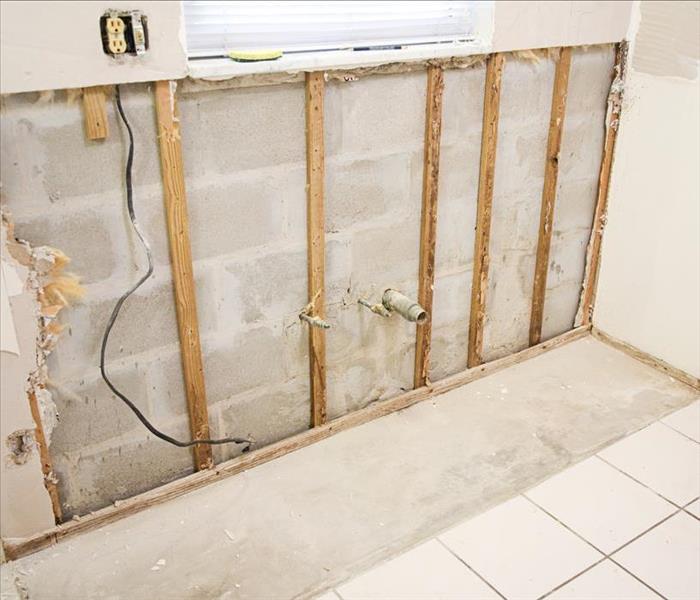 The tear-out process must be done with professional equipment for your safety.
The tear-out process must be done with professional equipment for your safety.
Tearing out damaged items after flooding in your home can be one of the most time and labor-intensive parts of the restoration process.
These tips will help you complete it correctly.
1. Take Precautions
The tear-out process may expose you to mold, dust, mildew, sharp items, nails, broken glass, and other debris. Wear protective gear such as gloves, sturdy shoes, dust masks, and eye protection. It may be a good idea to get a Tetanus shot if you haven't had one in the past ten years.
2. Remove Wet Contents
Before you start tearing out materials, remove wet contents. Leaving items such as wet furniture, clothing, and books in the home can cause the drying process to take longer which increases the risk of mold growth and other complications. Some wet items can be placed outside to dry, though be cautious about leaving furniture and other items that may fade or discolor in the sunlight for too long.
3. Hire a Restoration Company To Remove Black Water
If there is still water in your home from outside flooding or a sewer backup, consider hiring a restoration company in West Valley City, UT, to remove it. Sewage and floodwaters may contain contamination that is unsafe to handle without the proper safety equipment and training.
4. Remove Water Damaged Flooring Other Than Tile
Tiles that have been installed on a concrete slab are usually not damaged by floodwater and can be restored by regrouting and resealing them. Most other types of flooring, including carpets, wood floors, and subfloors will need to be removed and replaced.
5. Remove the Baseboards
Depending on how high the water level was, your baseboards will either need to be removed and replaced or detached and reset. If you aren't sure, consult with a contractor. If you have insurance, you may want to talk to your insurance company about what it will pay for, before you decide what to do.
6. Make a Flood Cut
If your drywall got wet, remove it from the floor to one foot above the waterline. Once you have removed the drywall, remove the insulation up to the same point. Insulation that has gotten wet can not be salvaged. You should remove and replace it.
7. Detach Cabinets
If your cabinets are damaged or the drywall and insulation behind the cabinets are damaged, remove the cabinets. If the cabinets were damaged, they will need to be replaced. If only the walls were damaged, the cabinets can be reset. If the face frame and doors of your damaged cabinets are not damaged, you can remove them and attach them to your replacement cabinets so that they will match the rest of your cabinets.
8. Some Countertops Can Be Salvaged
Laminate countertops can often be detached and reset because they are attached to the base with screws. Tile countertops need to be replaced because they can not be removed in a single piece.
Restoring your home after flooding is a lengthy and work-intensive process. However, taking the time to properly tear out damaged materials before beginning the repair process can help you avoid future problems.
Who's Responsible For What After an Apartment Fire
8/3/2021 (Permalink)
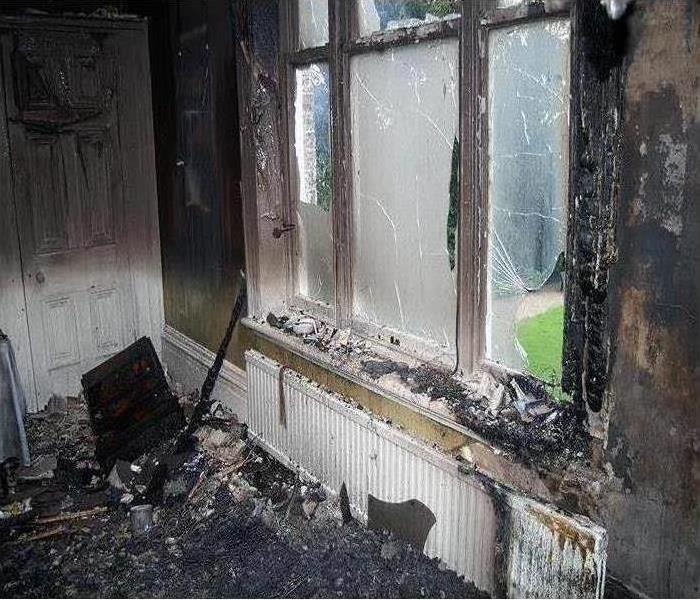 Fire damage in West Valley City, UT.
Fire damage in West Valley City, UT.
An apartment fire can raise a lot of questions: Did we lose any family heirlooms? Why didn't we ever replace that ancient, sparking coffeemaker in the kitchen? Are we on the hook for fire damage repairs, or is that the landlord's job? Here's a brief guide to who's responsible for what after a fire at a rental property in West Valley City, UT.
Guide of Responsibilities After an Apartment Fire
What the Property Owner Is Responsible For
In the simplest terms, a landlord is generally culpable for the apartment itself — more specifically its structure and fixtures. This typically includes components such as the following:
- Plumbing
- Kitchen and bathroom counters
- Built-in cabinetry
- Appliances
- Windows and doors
If fire damage to any of these structural elements requires repairs, it's usually up to the landlord to fix them or, depending on the severity of the loss, enlist the help of an experienced fire restoration company. A landlord has a responsibility to bring the residence back up to habitable conditions ASAP.
The main exception to this provision is a fire caused by the renter. If a tenant's carelessness results in an apartment fire, and the landlord can prove that negligence, then the renter may be liable for the cost of structural and fixture-related repairs instead. For this reason, it's imperative that all parties involved take photos and videos of any fire damage after the event.
What the Renter Is Responsible For
The renter is culpable for whatever he or she brought into the apartment. These personal items can be large or small: everything from furniture and electronics to clothing and media. In short, if it wasn't there already when the renter moved in, then he or she is likely liable for any repairs or replacement that may be required.
If, however, the renter can prove that the landlord was responsible for the fire through negligence or failure to comply with building codes, then the landlord may be held liable for damage to the tenant's personal items.
The aftermath of an apartment fire can be chaotic. Knowing what you're responsible for — and what you don't have to worry about — is one way to begin regaining control of the situation and your sanity.
Fire Damage: Remediation Services Offer Support and Hope Throughout the Restoration Process
7/29/2021 (Permalink)
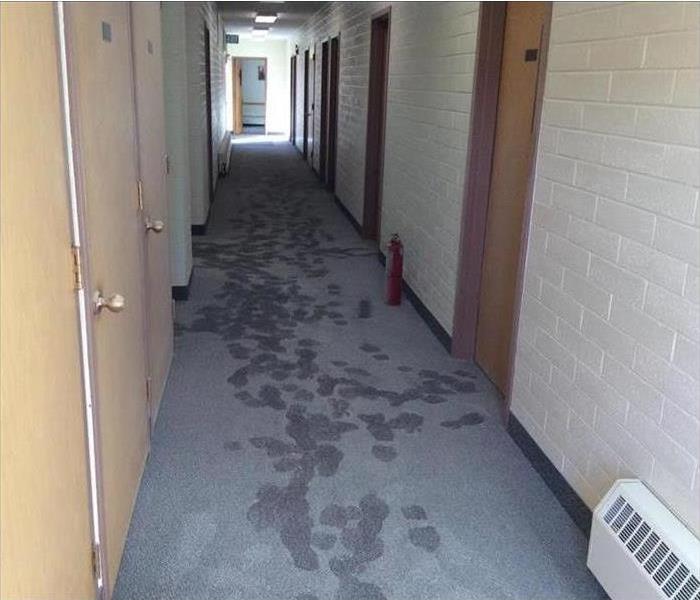 Fire extinguisher residue left after a fire in West Valley City, UT.
Fire extinguisher residue left after a fire in West Valley City, UT.
Thankfully, after experiencing a fire in your commercial property, you are not alone in the cleanup process. Most insurance companies will even require the use of fire remediation specialists in the West Valley City, UT, area before providing coverage. Many of these services offer both content cleaning and content storage and some even facilitate dry-cleaning. While it is a relief to know that your property will be restored, it is beneficial to understand the fire damage restoration process.
What is the fire damage restoration process?
- Initial Contact and Assessment
Dependable restoration services offer immediate response times, meaning that after a disaster they will respond without notice. This initial point of contact will also allow project managers to assess the extent of the damage, which will help them understand the best way to move forward.
- Board Up Services
Once the property has been assessed, the restoration crews will board up and tarp any necessary areas to mitigate further loss. This mitigation process also provides property owners with the assurance that they are safe from any other liability issues, like looting and vandalism.
- Cleaning Up and Drying Out
During the cleanup phase, the mediation companies will remove excess water, scrub away surface damage, sanitize any problem areas and remove orders. In addition to the extensive cleaning process, these companies may help you find dry-cleaning specialists to help remove smoke odors from porous materials.
- Repair and Restoration
After the cleaning, comes the fun part. This is the point when you begin to see your property take on new life. Damaged walls will be replaced. Rooflines will be repaired. Flooring and other surfaces will be changed out or restored. When all is finished, your building can return to full operation.
While the fire is a devastating thing to experience for any business owner, there is security in knowing that fire remediation specialists exist. These companies ensure that there is hope for restoration, and by performing the necessary task of securing property, cleaning out the property, and even facilitating dry-cleaning, the services ensure reduced stress and anxiety.
How To Prepare Your Home Before Rain
7/29/2021 (Permalink)
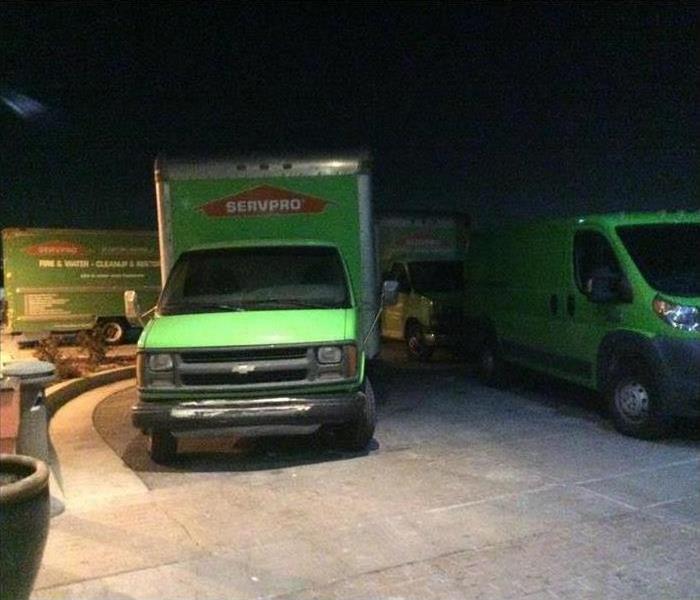 SERVPRO knows that immediate action is crucial when suffering storm damage in West Valley City, UT.
SERVPRO knows that immediate action is crucial when suffering storm damage in West Valley City, UT.
You can't decide when flooding will impact your area; torrential rains can come any time of the year. However, you can affect how much damage the storm can do to your home.
With a little preparation, you can keep storm damage to a minimum.
First, you should prepare your family by doing the following:
• Collecting important items such as extra medication
• Putting important documents in a waterproof casing
• Knowing possible escape routes
• Checking that your insurance covers floods
Once you have done those things, you should protect your home from flood damage. Here are a few ways you can keep your house ready for whatever Mother Nature throws your way:
Clean Your Gutters
If your gutters and storm drains are clogged when the rain starts coming down heavily, this could cause serious problems. Your storm drains give the water a safe place to go, but debris stops this from happening. Instead, the water collects and spills over into areas you wanted to keep it from.
Make sure that you have your gutters and storm drains in West Valley City, UT, professionally cleaned every spring and fall. This simple step can help you avoid severe flood damage. In fact, it could save you money in the long run.
Fill Foundation Faults
Does your foundation have cracks? Even the smallest openings can make flooding worse than it otherwise would be. These breaks allow water to seep in, which causes flood water to damage the foundation. Over time, this can cause further flood damage and even structural problems. Get those cracks fixed while they are still small.
Add Retaining Walls
As you work on landscaping in the spring and fall, consider adding a retaining wall. These beautiful features not only look great, but they can also keep your home from flooding and prevent soil erosion.
No amount of planning is 100 percent foolproof. If floods still enter your home, be sure to have a professional cleanup crew in West Valley City, UT, fix your home immediately.
Benefits of Professional Sewer Repair
7/26/2021 (Permalink)
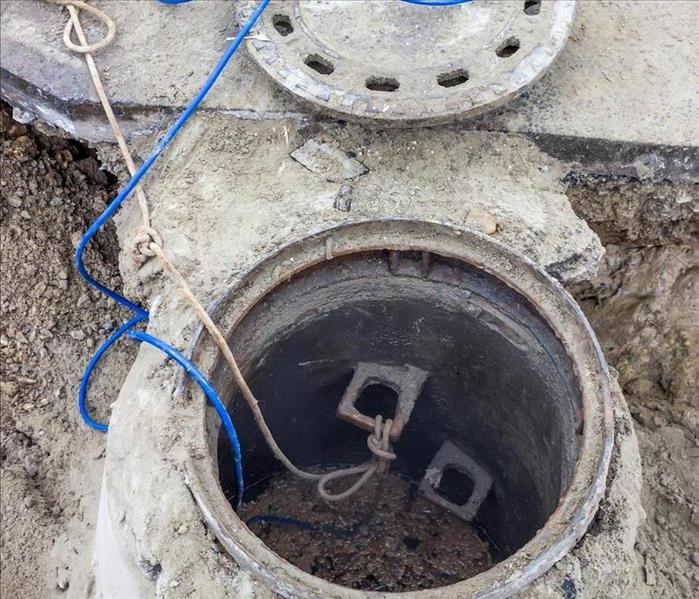 To clean pipes without damage them must be used some specific products.
To clean pipes without damage them must be used some specific products.
Insurance providers often see sewer damage claims from commercial property owners. One clogged drain can cause a lot of problems for the whole building. While chemical drain cleaners claim to tackle the problem, they're no match for a serious clog and can often do more damage than good in the long run. Your clients in West Valley City, UT, are better off using professional plumbing and sewer damage mitigation services such as those offered by SERVPRO.
Pipe Protection
A drain cleaner is typically made of one of three types of chemicals:
While the specific cleaners used may vary, the outcome is typically the same. The chemicals produce heat to break down the materials and clear the pipe. If the problem is only a small blockage, a one-time use will likely clear the clogged drain. If chemical cleaners get trapped in the pipes, however, they can actually damage the pipe without clearing the clogged drain.
Damage Mitigation
A persistent clog is likely to eventually lead to a backup of the sewer into your client's building. If this happens, the business owner will need a reliable mitigation company to sanitize and restore the structure. SERVPRO is a preferred vendor for many insurance providers because it has teams throughout the country. Franchises that meet the rigorous standards set by corporate are fast, efficient, and thorough when it comes to the sewage cleaning process.
Environmental Safety
Another benefit of professional intervention over DIY drain cleaners is the potential effects on the environment. Anything poured down a drain has the potential to affect the water supply. Experts use methods and equipment that minimize this impact.
It may seem to make sense to use a chemical cleaner to fix a clogged drain, but this action can actually cause your clients more trouble than it resolves. By referring them to reliable sewer damage experts, you can help them avoid further damage and expense.
How To Repair a Leaking Toilet
7/26/2021 (Permalink)
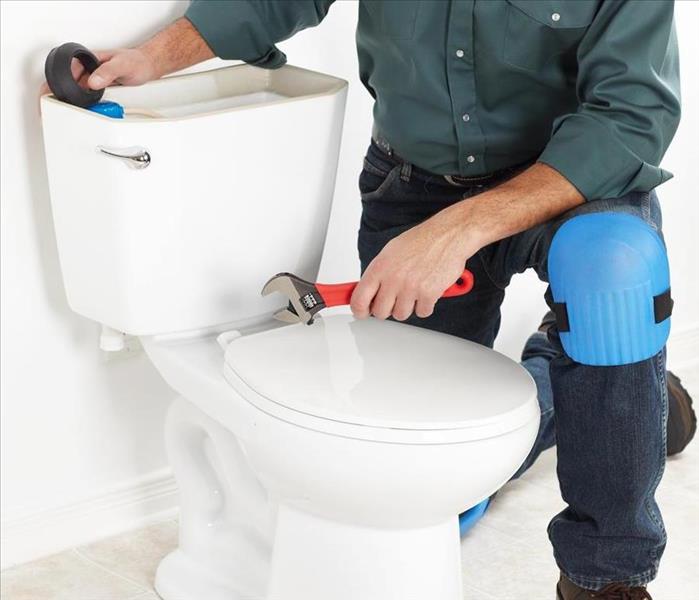 Repair the leaks will prevent different damage caused by water.
Repair the leaks will prevent different damage caused by water.
Most household toilets are durable pieces of equipment that can withstand regular use for decades, with a minimum amount of maintenance. However, parts can wear out or come loose, leading to a leaking toilet. If your toilet has begun to leak, it is important to take steps to repair it, before it causes more damage.
Identify the Problem
The most common cause of a leak from the bottom of an old toilet is the failure of the wax seal. However, leaks can also be caused by other things:
- Loose supply tube
- Cracked tank
- Broken shutoff valve
- Sweaty bowl
Remove the water from the floor with a mop, wet/dry vacuum, sponge, or towel, and then dry the toilet. If there is a lot of water, or the water has caused a mold or mildew problem, you may need to contact a water remediation company in West Valley City, UT. If the puddle forms again, check to see if it is coming from under the toilet or from somewhere else.
Fix the Leak
If the water is coming from the bottom of the toilet, you may be able to fix the leaking toilet by tightening the bolts that attach the toilet to the floor. To do this, use a slotted screwdriver or putty knife to remove the caps that cover the bolts and then tighten the bolts with a wrench. Avoid applying excessive pressure, because this can crack the toilet. If this doesn't stop the leak, you may need to replace the wax seal. Replacing the seal is a more complicated toilet repair that involves removing the toilet. While you can do it yourself, you may want to contact a plumber instead.
Water from a leaking toilet can cause severe damage to your floor and lead to mold growth. It is important to repair leaks as soon as you discover them to avoid unnecessary damage.
5 Ways Hurricane Shutters Can Benefit Your Home
7/14/2021 (Permalink)
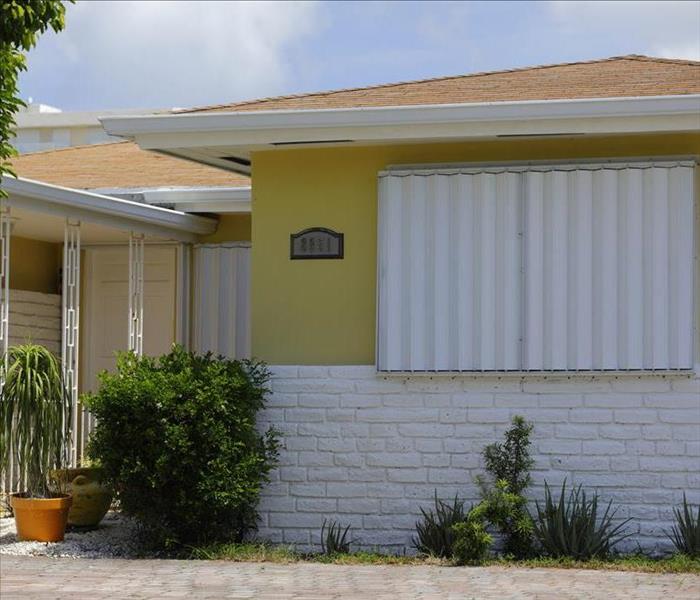 Protecting your West Valley City home from hurricanes is essential to minimize the loss.
Protecting your West Valley City home from hurricanes is essential to minimize the loss.
Between the extremely high winds and heavy rain, a hurricane can be a devastating event for both you and your West Valley City, Utah, property. This is why it's essential to prepare as well as possible to minimize the loss. If you reside or have a vacation property in a hurricane-prone area, it's even more important to have permanent means of protection. Storm shutters are an excellent option for various reasons.
1. More Value for Your Money
Although storm shutters require an initial investment, it's a one-time expense. This is much better financially in the long run because you don't have to buy plywood and supplies to board up your home multiple times a year. This not only saves you money but also time and labor.
2. Insurance Savings
Many insurance companies offer discounts for taking necessary precautions to protect your home against storm damage. Check with your insurance agent to see if fixed shutters qualify you for savings.
3. No Installation Damage
Putting up plywood boards or hurricane panels yourself, particularly when you're in a hurry, can lead to accidentally damaging your home. Fixed shutters are advantageous because they're installed before high winds hit, and they're permanent.
4. Flexibility
Fixed storm shutters are the best option for multi-level properties, balconies, and patios. They can also be customized to your windows and doors for better fit and protection. This customizability allows for a more discreet appearance so they won't look out of place or detract from your home's appeal.
5. Preparation
Having fixed hurricane shutters installed on your home means you're always prepared for severe weather. This preparation is key to offering you peace of mind, especially when you have to be away from home during a severe storm. Another beneficial practice is discovering a storm damage restoration company to call should you sustain a loss.
If you live in an area that regularly sees high winds and severe storms, hurricane shutters could be an ideal solution for your home. Take steps today to protect your property.
The Secrets of Mold
6/28/2021 (Permalink)
 Some types of mold can cause health effects.
Some types of mold can cause health effects.
Mold is everywhere all of the time. It is just waiting for a good place to grow. It can be both incredibly good, like in cheese, and incredibly bad, like bread mold, depending on where it is growing and what kind it is.
Mold is useful for:
- Cheeses
- Antibiotics
- Causing materials to decompose quickly
Many molds are helpful, but some are not. When they start growing in your home and on your walls, it is time to call a mold remediation specialist in West Valley City, Utah.
What Mold Is
Mold is a fungus and is unlike plants or animals. It is very similar to mushrooms. There are a wide variety of molds, some of which can cause health effects, while others are perfectly benign.
How Mold Grows
Mold grows much like any other mushroom. It uses organic materials to feed on. When you leave bread out on the counter or in a cabinet in a few days, you will probably begin to see mold. Although it is not ideal, you will also see fridge mold on bread if left alone for long enough.
Mold grows particularly well on bread because bread is both moist and contains nutrients that it can consume. Bread also decomposes faster than many other substances.
Eating Mold
Mold grown for medicines like penicillin and cheese are very specific types. They are highly cultured and monitored, unlike the mold that grows on your loaf of bread. Although most bread mold is not usually toxic, you should avoid eating it. There are several types of mold that are dangerous and can cause health effects.
Disposing of Mold
If the mold is on something like bread which is disposable, you mustn't cut the moldy parts off. Mold contains tiny particles called spores. Spores are what spurs fungus growth and can float through the air onto other surfaces. You should put the item in a non-porous bag and throw it away.
Bread mold is only one form of mold. Each form is a bit different, and although some are useful, others are not. If you see mold, it is best to dispose of it properly.
How the Claims Inventory System Helps Insurance Agents
6/28/2021 (Permalink)
 Inventory System simplifies the work done by agents.
Inventory System simplifies the work done by agents.
Filing an insurance claim after flooding or a fire at your home in West Valley City, Utah, is one of the first tasks you'll complete to recover. At this point and throughout the process, it's important to work closely with your insurance agent. This professional may recommend the services of a preferred restoration provider, such as SERVPRO, in addition to working through the paperwork necessary to complete your claim.
What the Inventory System Provides
There are several reasons why insurance providers choose to work with preferred providers. SERVPRO, for instance, has a claims inventory system that simplifies the work done by the agent. The inventory system includes several components:
1. Database of Documentation
Every insurance claim requires a lot of paperwork and many details. A central database offering documentation pertinent to specific cases and with information from around the country makes it easier for agents to access and store photographs, written records, digital information, and anything else required to complete your claim.
2. Access From Any Location
You and your insurance agent may not be in the same place very often. When you add in the property damage cleanup and restoration technicians, as well as any other emergency response professionals, staying in touch and sharing information becomes complicated. The digital claims inventory system provides a central point of contact where information can be shared almost instantly. This speeds up the process of filing your claim and receiving the necessary funds.
3. Information for Tracking Claim Progress
It's important that your agent knows how repairs and your claim are progressing. This allows corrections and answers to questions to be handled quickly and accurately. Regular progress reports can also help you feel more comfortable about the work being done in your home. With convenient access to this information, you and your agent can be aware of the severity of damage and the need for further work.
This digital inventory system is helpful in completing your insurance claim quickly and accurately. The benefits provided through the system make it popular with agents from many insurance providers.
SERVPRO Helps Communities Recover From Natural Disasters
6/22/2021 (Permalink)
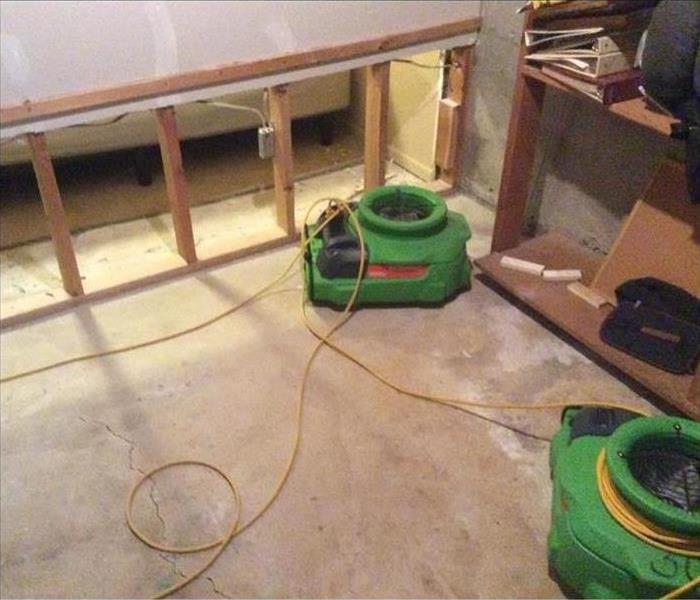 Basement flooded.
Basement flooded.
When disaster strikes an entire community, each insurance claim is joined by hundreds of others. For the insurance agent covering your West Valley City, UT, home, this means hours of effort to work through detailed paperwork. SERVPRO serves insurance companies and homeowners by offering a claims inventory system that cuts through home cleanup and repair confusion, simplifying the completion of claims for agents.
The Claims Inventory System in Action
A single insurance agent, entire firms, and claims adjusters can all use the claims inventory system to complete their paperwork more quickly. Trusted cleanup, restoration, and mitigation companies provide data, estimates, and pertinent information to the inventory. The information is then made available to professionals in the following ways:
- An organized collection of claims, arranged by damage type as well as by type of loss.
- Reviewed files for each individual homeowner.
- Regional and national repair and reconstruction cost comparisons
- Recorded response times.
While you're waiting for news about your own insurance claim, insurance personnel are sorting through the details of many homeowners' claims. The inventory makes it quick and easy for professionals to access repair estimates, client details, service options, and other pertinent information.
Actions You Can Take While Waiting
While your insurance agent is at work on your claim, there are some steps you can take to speed up the process. These include gathering documentation, such as copies of your insurance information and proof of homeownership. It's also important that you document all damages. Use written records and photographic evidence as much as possible. Although you probably don't want to work on repairs that property damage restoration professionals will cover, you should board up or tarp any openings that would expose your home to further damages.
Community Partners Working Together
There are many ways that SERVPRO works to improve property restoration in West Valley City, UT. The claims inventory system is one example of these efforts, speeding up the results of your insurance claim, so you can get back to your desired routine.
3 Flood Preparation Tips for Businesses
6/18/2021 (Permalink)
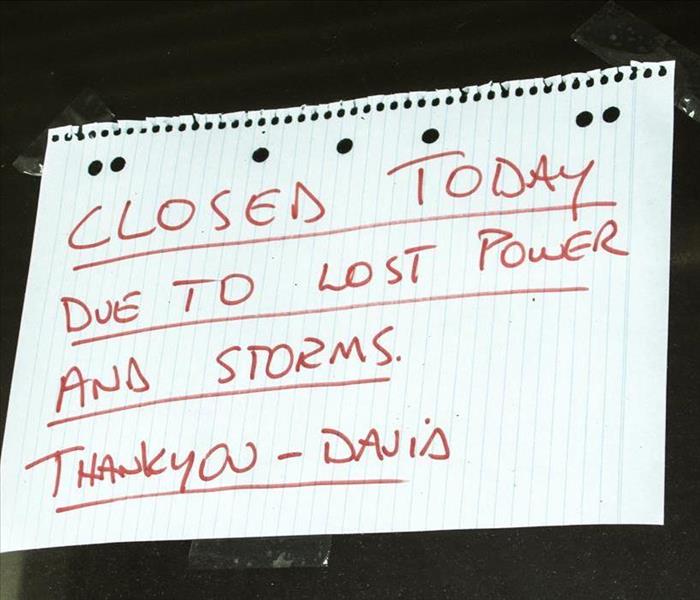 Being prepared for a flooding can keep your business safe.
Being prepared for a flooding can keep your business safe.
The damage from flooding can cost your business time, money and customers. However, a flood preparation plan can help you minimize the amount of property damage and the lost time your business suffers.
3 Tips for Businesses Flood Preparation
1. Be Aware of Your Flood Risk
Any business can experience a flood, but some are more likely to have serious flood damage than others. Look up your location in West Valley Ctiy, UT, on a FEMA flood map to find out what the flood risk is in your area. Assess your building's risks and make a plan to minimize them.
If your building has electrical equipment that is close to the ground, considering having an electrician elevate your electrical components to reduce the risk of shock. Inspect your building's drainage system and windows to make sure they are properly sealed.
2. Create a Disaster Plan
Create a disaster plan that covers what you will do if flooding causes your power to go out, damages your equipment or disrupts your business in some other way. The disaster plan should include alternative plans, such as using a generator when the power goes out or moving your operations to an off-site facility if you are forced to evacuate your building because of black water contamination. It should also include recovery resources, such as flood mitigation companies you can contact to start drying out your property and contact information for your flood insurance company and key employees.
3. Protect Your Data
Electronic data should be backed up to the cloud or stored in an off-site facility. Important documents should be stored in an area above the flood line and copies should be kept off-site.
Flooding can completely devastate a business, destroying equipment and shutting down facilities. However, the better your flood preparation is, the less damage you are likely to incur and the faster you will be able to restore normal operations.
Cleaning Requirements After a Flood
5/28/2021 (Permalink)
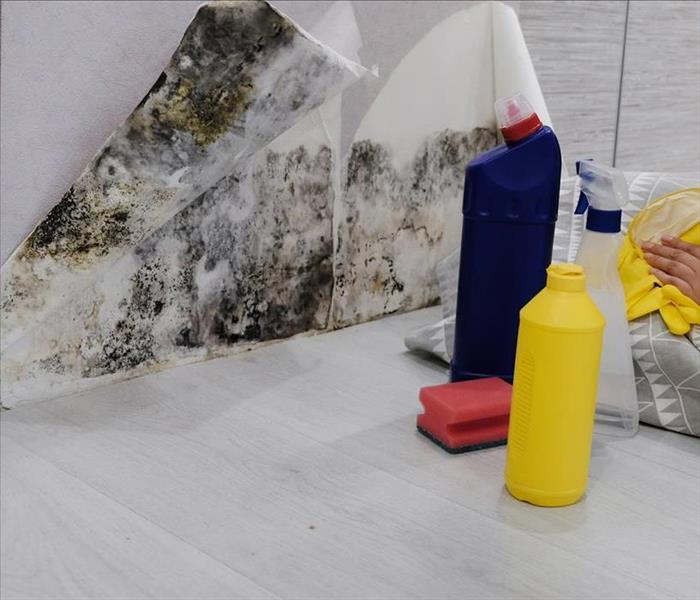 Check cleaning requirements after a flood.
Check cleaning requirements after a flood.
Cleaning up after a flood is a long process. It has to be done right, or you will face problems later on. After a major flood, it is usually better to call a professional cleanup company in West Valley City, UT, to deal with the damage because they know all of the cleaning requirements.
3 Things to Consider When Cleaning After a Flood
Remove Items
The first thing you should do is remove any items that are wet, saturated or starting to mold or mildew. This can include:
- Carpets
- Furniture
- Personal items
- Appliances
You also need to remove all contaminated materials from your home and properly dispose of those that can't be cleaned. When doing a full flood clean, it is better to remove something than keep it and have issues later.
Dry Your Home
It is extremely important to dry your home. You can do this with fans or with drying chemicals. Each part of your home will have different drying and cleaning requirements. If you are unsure of whether something will air dry without an issue, it is better to have it professionally dried just in case.
Drying drywall takes time and patience. In some cases, it is easier just to have your remediation company replace it along with the insulation behind it.
Clean Your Home
Cleaning your home after a flood is not as simple as it seems. Everything needs to be cleaned with an EPA-approved flood disinfectant for surfaces. This disinfectant is more powerful than simple over-the-counter cleaners.
The best thing to do is start at the ceiling and work your way down. Even though parts of your house might escape the flood, evaporating water can contain contaminants that might make you sick later on.
Remember to check each item or materials cleaning requirements. You will find that some items should be removed right away while others can be dried out and cleaned. In any case, your home needs thorough cleaning after any flood.
6 Steps for Cleaning After Sewage Damage
5/25/2021 (Permalink)
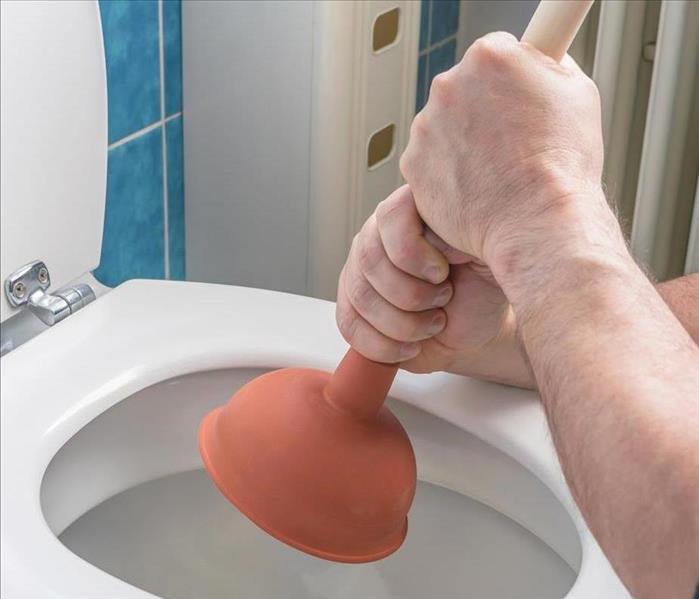 Sewer backup can lead to severe damage if not managed properly.
Sewer backup can lead to severe damage if not managed properly.
A flood of clean water can do enough damage in your West Valley City, UT, commercial building, but a sewer backup manifests a different level of disaster. Thorough sewage cleanup must begin immediately for the well-being of your employees, building and overall business. Follow these tips for managing the problem safely and efficiently.
6 Tips for Managing Sewage Damage
1. Wear Personal Protective Equipment
First, it's essential to wear the proper PPE to keep yourself safe. Adequate PPE is also necessary to prevent cross-contamination into non-affected areas. This gear includes eye protection and a respirator to shield your face from contaminated water and chemical cleaners. Disposable gloves, shoe covers and coveralls are also very beneficial.
2. Investigate and Stop the Sewage Source
Find and stop the source of the sewage leak as soon as possible. If it's coming from a flooded toilet you may be able to solve the problem yourself. If it's the result of a sewer backup, hiring professionals to repair it is typically the safest option.
3. Eliminate Standing Water
After you've stopped the influx, the next step in the sewage cleanup process is eliminating the standing water. One of the safest and most efficient ways to do this yourself is using a wet/dry vacuum.
4. Remove Contaminated Materials
All contaminated items must be removed and discarded. These materials will probably include drywall and flooring.
5. Determine What's Salvageable
Anything porous that you can't get completely clean and dry within 48 hours will typically not be salvageable. Mold can begin growing within 24 hours of water exposure.
6. Clean and Dry Remaining Materials
Finally, you must thoroughly wash and dry all that remains. Hiring water damage restoration experts can ensure that the job is handled swiftly and correctly while keeping you safe. They'll use industrial equipment and professional inspection procedures to ensure your building is returned to its preloss condition.
Sewage cleanup is disgusting but essential work. Whoever is cleaning the area must manage the project with care to protect the well-being of your employees, property and ultimately your business.
Fire Restoration Steps
5/25/2021 (Permalink)
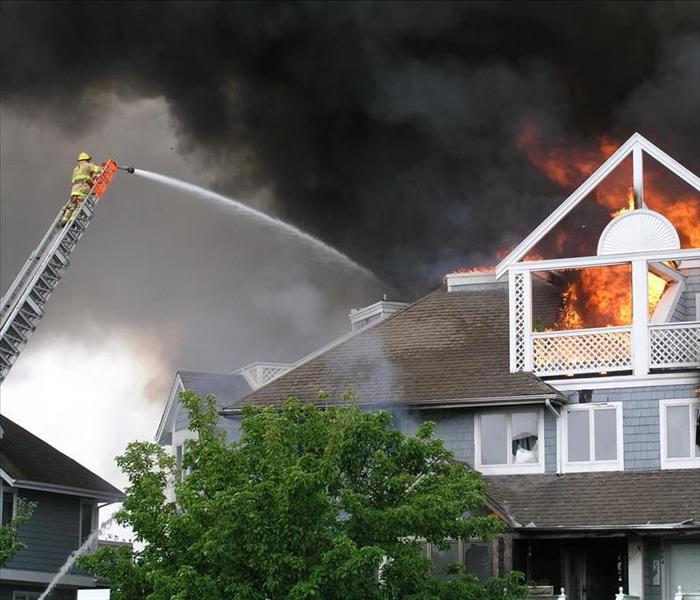 A home fire can be damaging.
A home fire can be damaging.
A fire can destroy your home in West Valley City, UT, in a matter of minutes. Even if the house is not a total loss, a lot of damage can still happen quickly, and professional fire restoration is necessary to get your home back to the way it was before the incident. Before technicians can rebuild, they must first clean up the mess left behind.
5 Steps for Fire Restoration
Assessment
The first thing that fire damage mitigation specialists do when they arrive is assess your home. The walkthrough will give them the information they need to plan mitigation:
- Extent of the damage
- Effect on structural integrity of home
- Places of egress that need boarding up
Once the assessment is complete, the technicians provide an itemized list of the steps involved as well as a cost estimate for their services. This information helps you understand the process and timeline and can also assist with your insurance claim.
Extraction
It takes a lot of water to put out a fire. Therefore, before fire restoration can really begin, technicians must extract all standing water and dry the space. Removing the water also makes it easier to determine which parts of the structure must be removed.
Removal
If your walls, ceiling or floors sustain significant water or smoke damage, the materials must be torn out. Any porous material is particularly susceptible to damage that cannot be fixed. If it can't be salvaged, it has to be removed.
Cleaning
The next step is removing soot from remaining surface. The damage cleaning process may involve techniques that mimic the factors involved in the fire so that cleaning agents can get into cracks and crevices.
Restoration
After the remaining structure is thoroughly disinfected, technicians rebuild the structure. The restoration team matches the new walls, floors and ceiling with the remaining ones so that no one can tell where the damage occurred.
The fire restoration starts with assessment and mitigation. The final step isn't finished until your home is back to normal.
Black Mold Growth in West Valley City
5/6/2021 (Permalink)
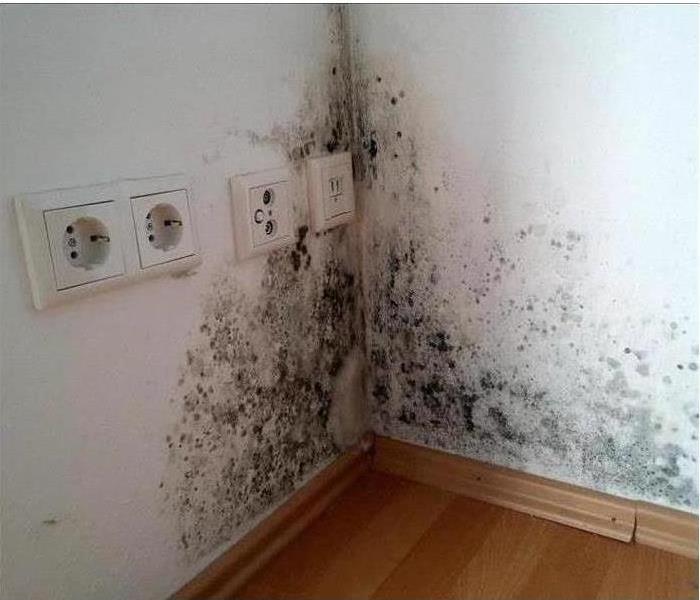 Visible mold growth
Visible mold growth
Mold growth that is visible may appear like an undeniable indication of a mold problem.
However, some individuals don't see little signs of mold development or they believe it's simply residue or smudged dirt. Now and then individuals basically overlook unmistakable black mold in their West Valley City, UT home.
On the off chance that you can see mold growth, regardless of whether it's just little, you should call a remediation company quickly.
Little mold patches can spread quickly.
Visible mold in your home is enough evidence to determine a problem. In the event that you don't deal with the mold problem right away, it will soon turn into a more concerning issue. Obvious mold and mildew growth could likewise be an indication that there is a substantially bigger mold problem that could be hiding in full colonies behind walls.
At times you won't not understand there is mold in your home, particularly on the off chance that it doesn't quite look normal. Some mold development looks white and string like. Other forms show up as bunches of little dark spots. They can be dark-brown, light-brown, green or even a dark-green shade.
Damage Repair Due to a Faulty Toilet
4/30/2021 (Permalink)
 Replace a leaking toilet to avoid further damage.
Replace a leaking toilet to avoid further damage.
When your clients' homes flood due to leaking toilets, it may be difficult to understand the details of their claims. There is a reason that SERVPRO is a preferred vendor for many providers. The Claims Information Center gives you and the homeowners you serve in West Valley City, UT, all the information you need to issue an honest and fair payout.
Leaking Toilet Repair
Find the Source
The first step in fixing a leak is figuring out its source. A toilet leak can come from several places:
- Overflowing bowl
- Leaky Supply line
- Cracked tank
- Unsealed base
The reason it's important to find the source is that it helps water damage mitigation experts determine the contamination level of the water, which can affect how much it costs to repair the damage. It also determines the type of toilet repair your clients need. In many cases, a leaking toilet can be fixed by replacing the supply line or tightening the bolts at the base. If this doesn't work, however, other steps have to be taken.
Remove the Toilet
While homeowners' policies may not cover the repair of the old toilet, you want them to be able to fix the problem quickly so that no more water damage is done to the home. They or a qualified plumber will likely need to remove the toilet to replace the broken seal underneath it. If the seal itself isn't the problem, they should keep the water valve shut off to the toilet until it can be replaced.
Replace the Toilet
Once the source of the leak has been repaired, the toilet just needs to be put back in place. A certified plumber can ensure that the job is done properly so that no further water damage occurs.
No matter how much damage a leaking toilet causes, SERVPRO's CIC keeps you and your client informed about the repairs that are needed and the subsequent expenses. Choosing SERVPRO as your preferred vendor ensures efficient, excellent service.
Help! My Toilet Overflows When I Take a Shower!
4/15/2021 (Permalink)
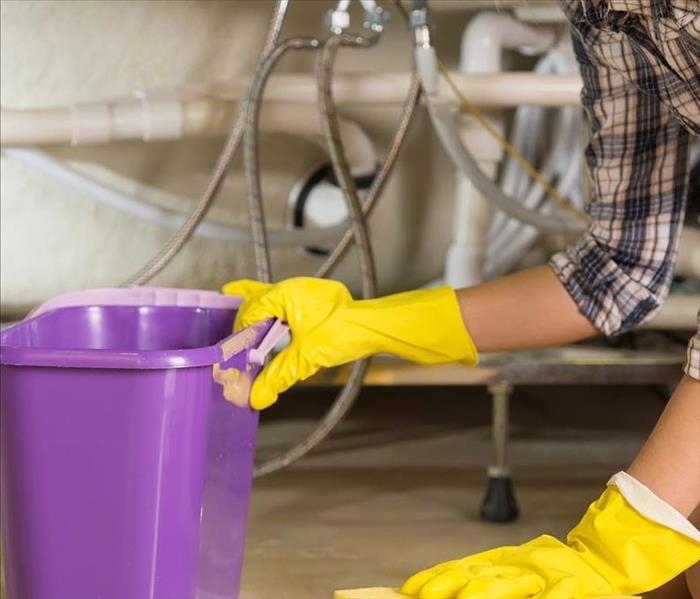 Clear a clogged pipe as soon as possible.
Clear a clogged pipe as soon as possible.
Is your toilet gurgling or overflowing when you take a shower? If so, there's probably a blockage somewhere between the main sewer line and the toilet. This obstruction will cause the shower water to back up. Home bathrooms are often designed so that the water from the shower travels to the toilet drain first. This can result in a toilet overflow. After performing sewage cleaning once, you're going to want the issue resolved as soon as possible. There are several ways to try to deal with the clog yourself if you don't want to hire professionals right away.
Ways to Deal With a Clog
Plunge the Toilet
A toilet plunger can often dislodge an obstruction in the line. Any plunger is better than none, but the best is one with an extra rubber flange built-in. This will create a tighter seal when plunging. If you see any materials coming up from the bottom of the bowl, this could indicate that a clog is breaking up. This could be messy if there's a significant blockage that breaks free and causes another toilet overflow. The assistance of sewage cleaning experts can ensure proper cleanup and sanitization.
Snake the Toilet
A plumber's snake or auger is a long cable with a corkscrew end. There are a few different varieties, but they all work by feeding the wire through the drain line and turning the corkscrew to dislodge blockages. Try to feel for obstructions as you're feeding it down the line.
Clear the Drain Cleanout
Your West Valley City, UT, home should have a drain cleanout plug where your drain line ends (e.g., crawlspace, basement or outside). Look for a large screw-on cap (i.e., the plug) in one of these areas. Remove the plug and feed the snake down the drain to remove any obstructions. A blockage may be further down the line, in which case you'll probably need to hire a professional plumber.
You must clear a clogged pipe in your bathroom line as soon as possible. You can probably avoid further problems, including a disgusting sewage cleaning job.
Mitigation and Remediation: Are They Different?
4/12/2021 (Permalink)
 Know the difference between mitigation and remediation to get back to business after a flood.
Know the difference between mitigation and remediation to get back to business after a flood.
When you are considering a flood cleanup company, you might hear the terms mitigation and remediation. Many think these two terms on synonymous, but they aren't. When dealing with a storm damage cleanup company in West Valley City, UT, you should know the difference between these two services.
The Simple Answer
When answering this question, you only have to look at the differences in the definitions.
- Remediation is making things better for your business.
- Mitigation is reducing the amount of impact that on a business.
When you think about a flood cleanup company for your business, you should choose a company that does prevention, mitigation and remediation. This way, you cover all of your bases.
Differences Between Mitigation and Remediation
Storm Damage Remediation
Storm damage remediation is a lot more complex than the simple definition of remediation takes into account. A remediation company most often acts as a restoration company. It is about fixing the problems caused by flooding and other storm damage and getting your business back to normal.
Think of remediation like the word remedy. A storm remediation company makes things better. Sometimes this is through replacing damaged equipment or a part of the building, and sometimes it is through rebuilding key systems.
Storm Damage Mitigation
Mitigation is another animal entirely. Instead of removing and rebuilding, mitigation reduces the severity of a situation. This service focuses on things that help to prevent more damage. In the case of something like storm damage, companies can clean up the water and then use chemical and physical methods to prevent mold from growing.
During mitigation, it is all about reducing the problems that the flood caused and not about repairing the damage or preventing it before it happens. The only way it deals with prevention is by preventing further damage from a situation.
Hiring a flood cleanup company is a big decision. By understanding the difference between mitigation and remediation, you can make an informed choice about which company better suits your business's needs.
How Drain Cleaners Might Cause More Harm Than Good
3/29/2021 (Permalink)
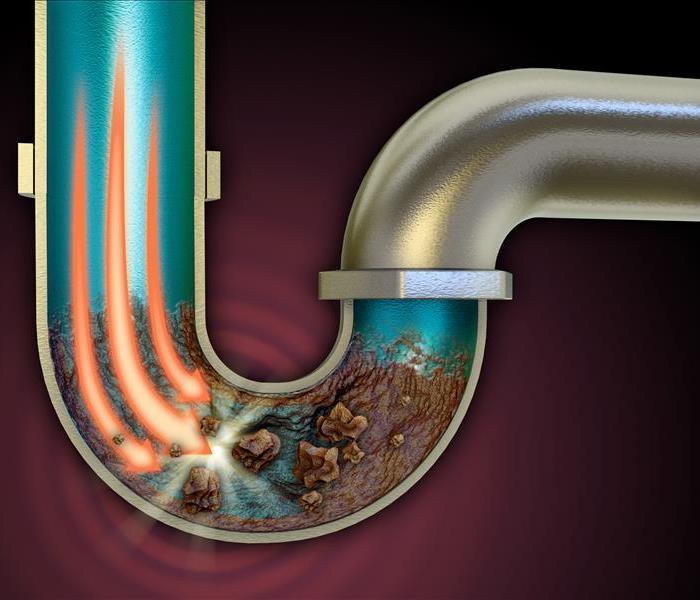 Drain cleaners can damage your pipes.
Drain cleaners can damage your pipes.
Nothing is more annoying than a clogged drain when you are in a rush. It might be tempting to pour a cleaning agent into it and hope for the best, but this can cause more harm than good. Some homeowners find themselves with more plumbing problems than they planned on when using store-bought products to clear a clog.
Drain Cleaners Cause Damage
Unfortunately, sometimes your typical clog remover is one of the worst things you can put down a drain. You do not want to use drain cleaner on:
- Older pipes
- Weak pipes
- Metal pipes
- Pipes that are completely blocked
It can even cause harm when your pipes are new. Most of these cleaners contain caustic chemicals, and if you use them incorrectly, they can cause a leak. This causes water damage, and you will find yourself calling a sewage cleaning company in West Valley City, UT, to fix the problem.
A good rule of thumb is always to read the directions on any drain opener very carefully. The instructions will tell you exactly how to use it on a clogged drain. The majority of cleaners specifically say not to use it when your pipes are completely blocked. Pouring a cleanser down a completely blocked pipe can cause the cleaner to weaken your pipes.
Calling the Professionals
Sometimes it is necessary to call a professional to take care of the problem. A drain clog can be an indicator of a much larger problem. This is particularly true if the problem is in your toilet. Multiple bends could be clogged, and there is a good chance that what you are dealing with is raw sewage. This can be dangerous if you are not wearing the proper protective gear.
Drain cleaners are not always the best solution for dealing with a clog. They can damage your pipes, cause sewage leaks and generally make things worse. A clogged drain doesn't have to be a big deal, but you do need to be careful about what you use to fix it.
How To Prevent Mold Growth After Water Damage
3/19/2021 (Permalink)
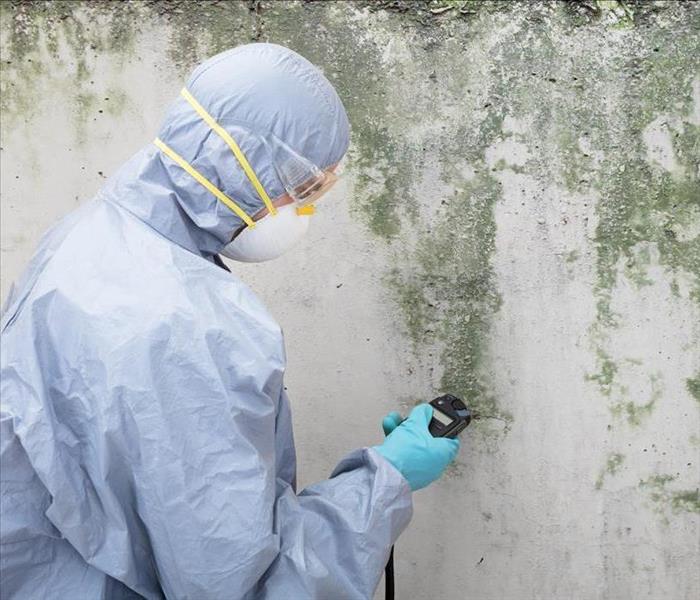 Call in professionals to assess the damage.
Call in professionals to assess the damage.
Mold prevention is one of the most important things you can do after your home is damaged by water. Whether a pipe breaks or it is from a flood, mold will start to grow quickly. Fortunately, you can do a few things to stop this from happening.
Tips to Prevent Mold Growth After Water Damage
Call In Professionals
One of the best things you can do is call a damage specialist in West Valley City, UT. They can:
- Assess the damage
- Use commercial grade mold and mildew cleaners and preventatives
- Repair the damage
Not only can professionals prevent mold growth, they often work with insurance companies to make filing your damage claim easier.
Stop Leaks Quickly
One of the keys to stopping mold is to stop what is causing the moisture. This could be a leak or generalized flooding. If the flooding is from a leak, consider shutting off the water main or stop valves. Stopping it will help prevent mold; it can give you a headstart in dealing with the damage.
Dry Wet Areas
Get the area dry as quickly as possible for the best mold prevention. Professionals do this by setting up fans and other drying equipment, but you can start by soaking up as much water as possible if the water damage is from a leak. If the problem is from a flood, you are best off letting the professionals set up pumps to get the water out.
Remove Damaged Drywall and Materials
Damaged drywall, flooring and wood can be soaked with water. There could also be moisture damage behind these that needs to be dealt with. You need to get any damp or damaged materials out before mold can take hold. This can save you thousands in remediation costs.
Whether the damage is from a leak or a natural disaster, the best way to stop it from growing is to use these mold prevention tips. With mold, it is best to act quickly before it takes hold.
What Does Commercial Property Insurance Cover?
3/15/2021 (Permalink)
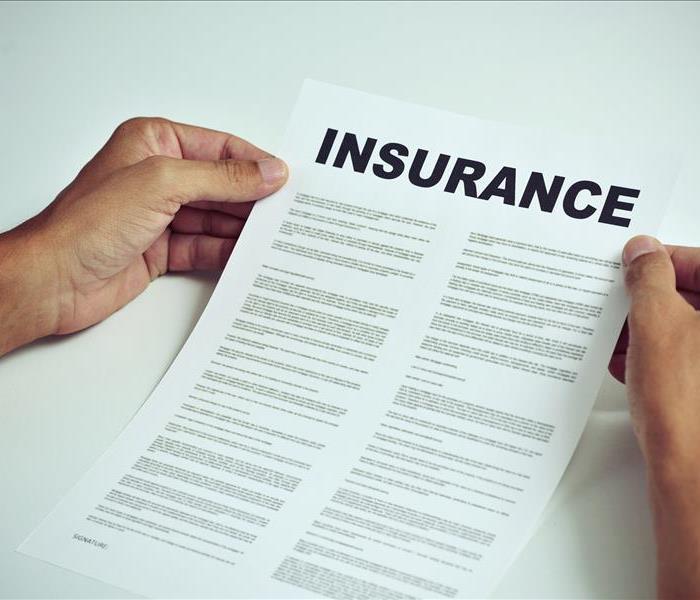 Commercial insurance is important
Commercial insurance is important
Commercial insurance plays a vital role in protecting your business interests in the event of an emergency. One coverage that most business owners carry is commercial property insurance. Unlike liability insurance, this part of your policy covers what your business owns.
What It Covers Against
Commercial property insurance covers you against losses of all varieties. It covers:
- Fire damages
- Loss due to theft
- Flood damage
- Natural disasters
For instance, if your business suffers from a pipe breaking and floods, this insurance will cover the damages. The same goes for wind and fire damage.
What It Covers
This type of insurance covers most of your business assets. Just as liability insurance covers your client or customer's person and property, this insurance covers yours. This includes things like landscaping damage, building damage, inventory damage, and stolen inventory. It protects everything your business owns. In some cases, this insurance covers cleaning your business after a flood or fire and the cost of a remediation company in West Valley City, UT.
Why You Need It
You could suffer significant financial loss in the event of a disaster. Imagine your building or office destroyed by fire. The damage can be devastating. You could lose everything. Make sure your commercial insurance policy covers the cost of all valuable property and cleanup necessary to make your business whole again.
What To Look For in a Policy
There are some basics that you need to know when you are looking for commercial property insurance. The first thing you should do make a list of all of your commercial property. This list should include sheds, outbuildings, inventory, industrial equipment, office equipment and important paperwork.
Anything that you want to be protected against loss should be on that list. Bring that list to your insurer. Ask them for a policy that covers as much as possible within your budget.
Commercial insurance covers a lot, but some policies don't have property coverage. If you read your policy and it doesn't have this coverage speak to your insurance agent.
Mold damage Remediation
2/25/2021 (Permalink)
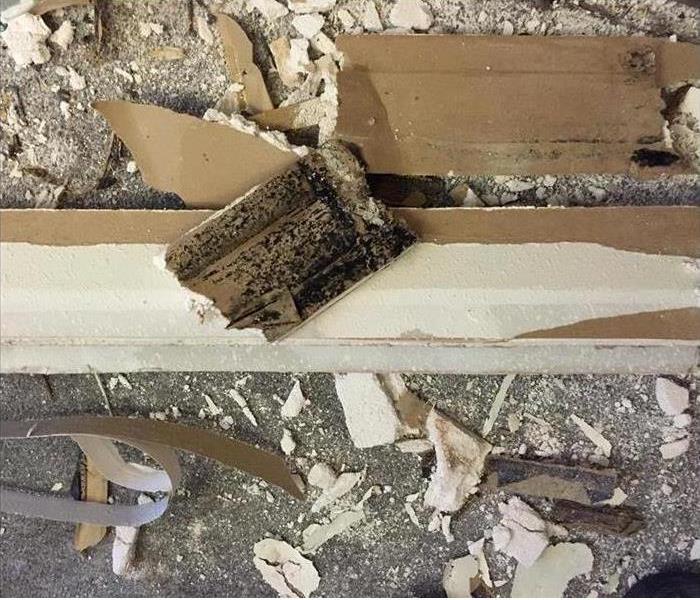 Baseboard mold damage.
Baseboard mold damage.
Any home or business can quickly become infested with mold with the introduction of a water source, like a roof or plumbing leak. Mold can spread throughout a property in as little as 48-72 hours, and can produce allergens and irritants that have the potential to cause other health effects.
If you suspect that your home or business has a mold problem, SERVPRO Of West Valley City can inspect and assess your property. If mold is found, we have the training, equipment, and expertise to handle the situation.
Understanding Mold
Microscopic mold spores exist almost everywhere, outdoors and indoors, making it impossible to remove all mold from a home or business. Some restoration businesses advertise “mold removal” and even guarantee to remove all mold, which is a fallacy.
Consider the following mold facts:
- Mold is present almost everywhere, indoors and outdoors.
- Mold spores are microscopic and float along in the air, and may enter your home through windows, doors, or AC/heating systems or even hitch a ride indoors on your clothing or on a pet.
- Mold spores thrive on moisture. Mold spores can quickly grow into colonies when exposed to water.
- Before mold remediation can begin, any sources of water or moisture must be addressed. Otherwise, the mold may return.
- Mold often produces a strong, musty odor which can lead you to possible mold problem areas.
- Even higher-than-normal indoor humidity can support mold growth. Keep indoor humidity below 45 percent.
Water Damage in West Valley City
2/25/2021 (Permalink)
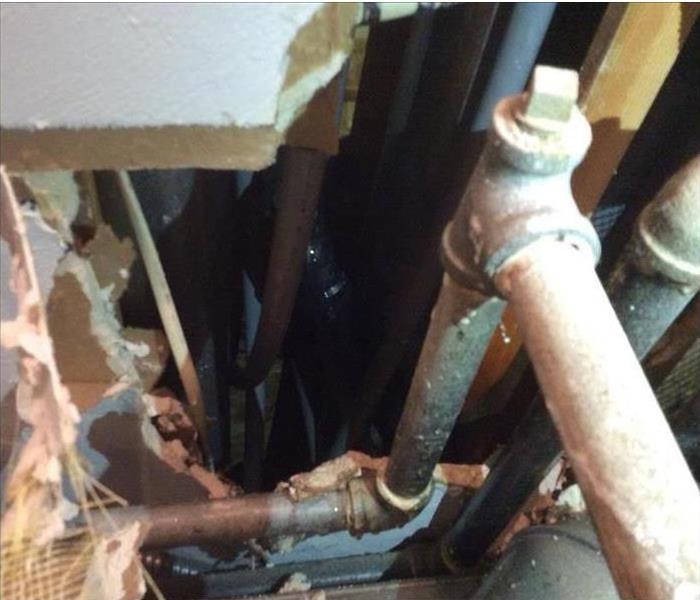 Broken pipe leading to water damage in West Valley City, UT.
Broken pipe leading to water damage in West Valley City, UT.
Water damages happen quite frequently in the West Valley City area. The most common that we see are from failed supply lines from a toilet or fridge.
When experiencing a water loss in your home you should first:
- Shut off the water
- Remove furniture from the area
- Call your insurance agent
- Call SERVPRO for a free consultation or emergency services
When dealing with a water loss from a broken supply line or pipe it is considered a Category 1 or clean water source. Most of your building materials that are wet will be salvaged and restored to pre loss conditions.
About SERVPRO
SERVPRO of West Valley City has a quick response time. All our technicians are background checked and are certified through the IICRC. Their certifications range from Water Restoration Technician, Applied Structural Drying, Commercial Drying Specialist, and Applied Microbial Remediation Technician.
What if I Don't Have Flood Insurance?
2/24/2021 (Permalink)
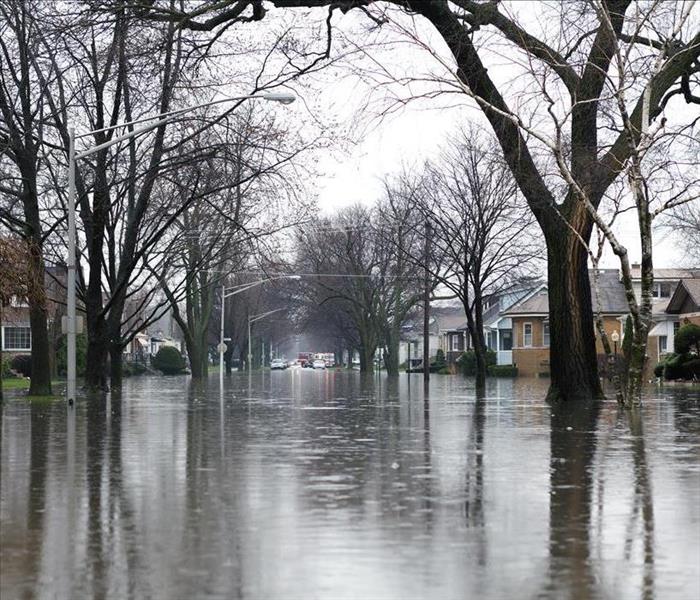 Flooding can lead to severe water damage.
Flooding can lead to severe water damage.
Many areas aren't located on a floodplain or prone to flooding. However, there's always a possibility that you could find your West Valley City, UT, home in a flood one day. In that case, what happens if you don't have flood insurance? There are a few options available to assist you.
3 Things to Consider if You Don't Have Flood Insurance
1. Prepare Ahead of Time
If there's a chance of an impending flood, it's best to be safe by being proactive. Move valuables and important documents to higher levels (e.g., upstairs or up on shelves). You can also put smaller important items in a clean, dry washing machine or dishwasher; they will keep water both in and out. If any of your valuables are too big or bulky to move (e.g., antique furniture), you can put a drain pan under each leg to keep the water away from it. However, this won't help for floodwaters that are more than an inch or two high.
2. Consider a Loan
If you've experienced a flood and your home has sustained damage, but you don't have flood insurance, you can consider getting a loan. The U.S. Small Business Association offers loans for which you can qualify even if you're not a business owner. They're primarily for homeowners who don't have flood insurance. These low-interest loans are available up to $200,000 for primary residence damage. The SBA also offers loans up to $40,000 for personal property damage (also available for renters).
3. Check Into Federal Disaster Assistance
The United States President must declare your state a major disaster area to get federal disaster assistance from the Federal Emergency Management Agency. They also must mark your county for individual assistance. A federal grant from FEMA will offer up to $33,000 per household for expenses incurred from a disaster like a flood. These expenses could include hiring flood damage restoration professionals, temporary housing, belongings replacement, and medical and funeral expenses.
If your home sustains a flood but no flood insurance, there are other options. Understanding them and being prepared before something happens can make a high-stress time a little less stressful.
Protect Your Family From a Gas Fire
2/23/2021 (Permalink)
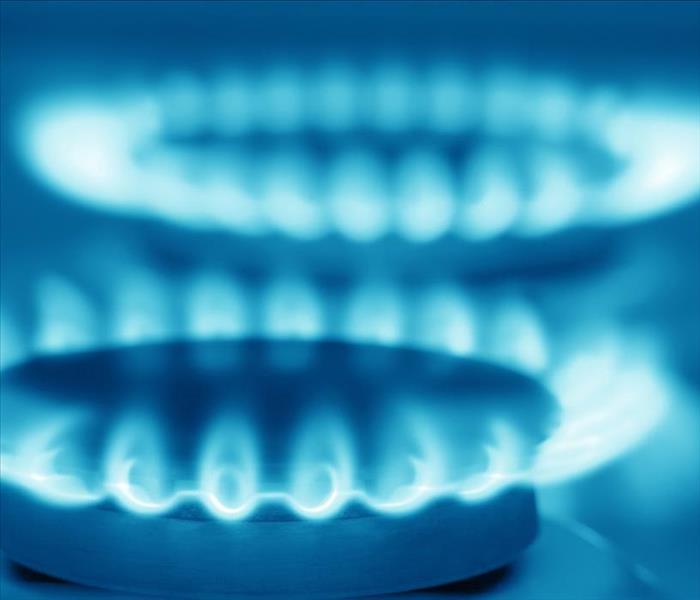 Gas may be used for cooking.
Gas may be used for cooking.
In many communities, natural gas is the go-to source of energy for home and water heating. In addition to these conveniences, this gas may also be used for cooking, powering air conditioning units, running the clothes dryer, and powering a gas fire in your fireplace. While this cost-effective source of energy is generally safe, there are some precautions you should take if you smell that "rotten egg" odor, hear a hissing sound, or suspect a gas leak for any other reason:
5 Precautions to Take if You Suspect a Gas Leak
- Don't turn any lights on. Don't plug anything into your outlets. Any spark or flame could cause collected gas to ignite. If you need a source of light, choose a flashlight.
- Check your gas appliances. If you have a gas stove, for example, make sure the burners have been turned off. It's fairly easy for the knobs to get bumped into an "on" position.
- Open windows and doors. This is the best way to provide the ventilation necessary to get gas out of your home.
- Evacuate everyone from your home. After moving across the street, call 911 or the gas company. The best way to avoid a gas fire is to alert professionals to the problem. They may also ask you to warn your neighbors to evacuate.
- Locate the gas meter. When you aren't worried about a potential leak and resulting gas explosion, find out where your gas meter is installed. With this information, you can turn off the meter if you smell gas.
Remember that your top priorities are the safety of your family, your loved ones, and the people around you. Don't take risks when dealing with gas.
Natural gas is an affordable option when it comes to powering your house. With the right information, you can avoid a gas fire. If your West Valley City, UT, home is affected by fire, contact property damage cleanup and repair professionals for help.
3 Steps To Take After Your Sprinklers Are Triggered
2/22/2021 (Permalink)
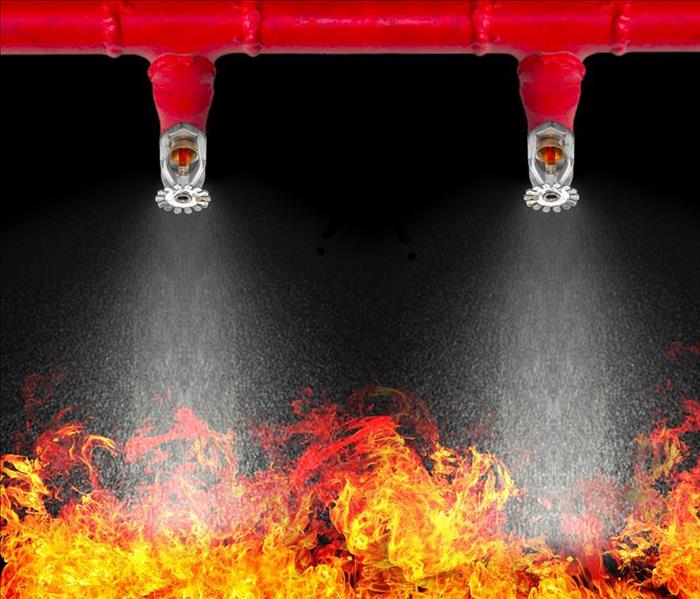 Sprinkler systems can leave behing a big mess when triggered by fire or by accident.
Sprinkler systems can leave behing a big mess when triggered by fire or by accident.
Your fire system is designed to put out any flames in your building in West Valley City, UT, as quickly as possible. Whether the sprinklers are triggered by a fire or by accident, they will likely leave behind a big mess that will require professional cleanup. When you have flooding issues from the sprinkler system, there are three steps you need to take right away.
3 Steps to Take When You Have Flooding From the Sprinkler System
1. Stop the Flow
The first thing you want to do when fire sprinklers flood your building is stop the water at its source. Depending on your system, the sprinklers may be fed by either a reservoir or the water may come directly from a line off the water main. Override the trigger on your fire panel, then shut off the water to the building.
2. Call Mitigation Experts
No matter how fast your reaction to the problem is, the fire system is designed to release a large amount of water in a short amount of time. To ensure that the flooding in your building doesn't lead to secondary damage, you need to call water mitigation experts as soon as possible. The team can arrive within hours of your call, assess the problem, and start the restoration process.
3. Contact Insurance Company
Your commercial property policy is likely to cover most if not all of the costs of repairing water damage, but you need to notify your insurance company as soon as possible. The assessment of the adjuster and the itemized estimate from the mitigation company are both necessary to complete your damage claim correctly.
When your fire system causes flooding in your building, you don't want to wait too long to address the problem. The sooner you can shut off the water supply and call cleanup experts, the less damage you are likely to have overall. Your quick action tells your insurance company that you have handled the situation responsibly and increases your chances of having your claim approved.
3 Reasons To Install Storm Shutters
1/26/2021 (Permalink)
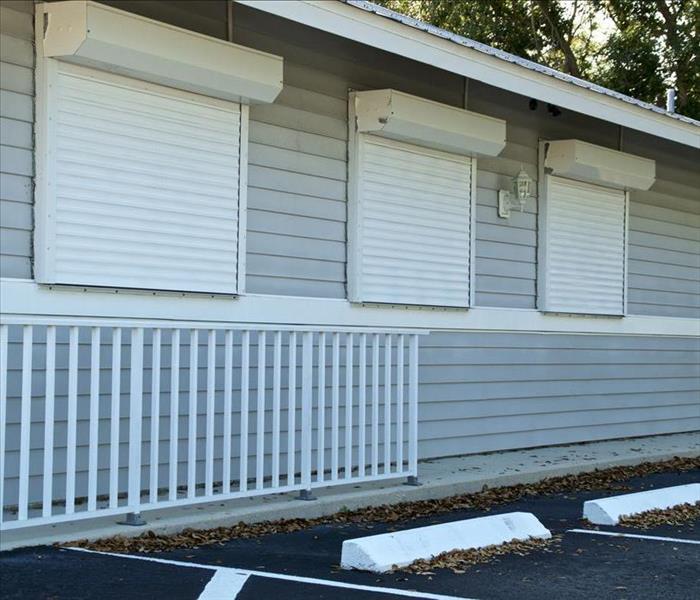 Install storm shutters to protect your home
Install storm shutters to protect your home
While residential properties must adhere to building codes and standards, those requirements ensure that a structure remains standing when subject to typical storm surges and expectations. Unfortunately, high winds are often unpredictable, and while some aspects of a home are built to withstand such gusts, windows are often vulnerable to breakage and penetration. Most storm damage specialists in West Valley City, UT, recommend homeowners install permanent shutters, and they make such a recommendation for three reasons.
3 Reasons Most Storm Damage Specialists Recommend to Install Storm Shutters
1. Always Ready
Having storm shutters installed means you are always ready, even when the weather shifts suddenly. The protective shields are often easy to deploy by either pulling over and latching or unrolling and latching. Whichever option you choose for your home, you ensure quick deployment and minimal damage to your home through a professional installation.
2. Not Intrusive
Many people worry that a shutter will devalue their property because it will affect the curb appeal, but this is not typically the case. A shutter system is looked at as a value add, and while some may be more visible than others, most do not intrude on the overall look of the home, and you will be happy to have them when the high winds start raging in your neighborhood.
3. Cost Efficient
Some people do not see the value in storm shutters, often opting for spontaneous protection through the nailing up of plywood panels. Not only are nails destructive, but the plywood will only need replacement when it comes to the next storm. By installing a storm shutter system, you are saving money because it is a one-time expense.
While building codes and city regulations attempt to cover every natural disaster or issue, high winds can be highly unpredictable, meaning that some structural elements are more susceptible than others to damage. A storm shutter system can protect both your home and family, and it is a one-time cost.
How Do I Get Rid of Mildew on My Plants?
1/22/2021 (Permalink)
 Get rid of mildew on plants.
Get rid of mildew on plants.
Powdery mildew is a common problem for various plants. It can restrict a plant’s growth or even kill it, if untreated. Powdery mildew is a general term for several fungus-related plant conditions. It thrives in warm, humid climates but can live in most environments, including West Valley City, UT. This plant mildew is distinctive from others due to its powdery appearance.
Fortunately, there are safe, natural treatments for this mildew growth:
4 Ways to Get Rid of Mildew on Plants
1. Garlic
Powdery mildew doesn’t react well with sulfur. Therefore, you can use a garlic solution to kill this fungus since garlic is high in sulfur. Crush six cloves of garlic. Then, mix it with one ounce of any kind of organic oil and one ounce of rubbing alcohol. The solution then needs two days to set. Then, strain the mixture. Keep the liquid and crushed garlic and put the garlic in a cup of water to soak. Strain the water off of the garlic. Mix one gallon of water with the oil and alcohol solution. Finally, thoroughly mix in the garlic water. Now, you can spray the mixture onto your plant’s leaves.
2. Vinegar
Acetic acid, which is present in vinegar, is excellent for plant mildew and one of the oldest fungal remedies. Mix four tablespoons of vinegar into one gallon of water. You can apply this to the affected plants every three days. Be careful to not make a more robust solution, as it can harm the plant by burning the leaves.
3. Potassium Bicarbonate Solution (Baking Soda)
A bicarbonate solution is excellent at killing the fungi without harming the plant. Thoroughly mix one teaspoon of baking soda with a quart of water. Spray it over the affected plant. It can also be a preventative treatment.
4. Milk
Milk is one of the most effective powdery mildew treatments. A solution of 60 parts water with 40 parts milk should be sprayed on the affected area biweekly. You can use undiluted milk if this solution doesn’t solve the problem.
You must start treating plant mildew as soon as you discover it, especially if you find it indoors. If there's a question, mildew and mold remediation specialists can help.
Splitting the Costs of Fire Damage in Rental Properties
1/14/2021 (Permalink)
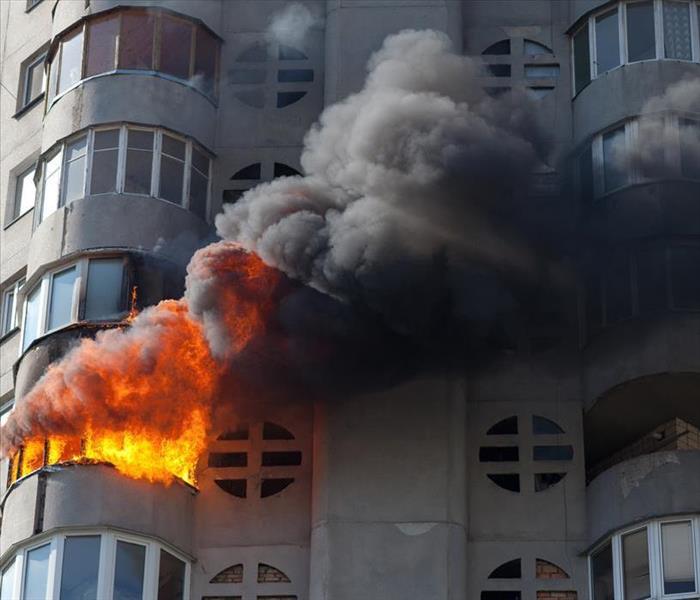 Fire damage in an apartment
Fire damage in an apartment
As a rental property owner in West Valley City, UT, you have an obligation to maintain your properties, so they are safe and livable for your tenants. Your responsibilities are defined by the Federal Housing Administration, the Fair Credit Reporting Act, the Department of Housing and Urban Development, and a variety of other federal, state, and local regulations. With so many sources of regulations, figuring out where your responsibilities end can be confusing. For example, who is responsible for repairs following an apartment fire?
Responsabilities of Fire Damage in Rental Properties
Renters' Insurance
Your tenant should have renters' insurance; as a property owner, you can require that your tenants carry this protection. Renters' insurance covers:
- Tenant-caused damage to walls, floors, and ceilings
- Tenant-caused damage to appliances
- Flea extermination caused by tenants' pets
- Damage to the tenants' belongings in the fire-affected apartment
In most cases, you'll need to show that the tenants were responsible for damage beyond normal wear and tear.
Your Property Insurance
After an apartment fire, the costs associated with fire cleanup and repair are split between your own property insurance and the renters' insurance. For example, your tenants' insurance should cover the loss of their furniture, clothing, and other belongings. Your insurance should cover damage to the structural elements of the property. As the building owner, you should reach out immediately to fire damage remediation experts for inspections, cleanup, removal of soot, and related repairs.
Determination of Responsibility
This sounds pretty straightforward, but sometimes other factors influence who ultimately pays. For example, your insurance company may want to know how the fire started and what types of damage have occurred. Your insurance company will attempt to work with the tenants' insurance provider.
Remember the property owner is responsible for damage to the structure and the tenant is responsible for damage caused to the content of the building. If the apartment fire was caused by something the tenant did, they may be found responsible for additional costs.






 24/7 Emergency Service
24/7 Emergency Service













































































